
Complete Guide to Storm Sails

Last Updated by
Daniel Wade
June 15, 2022
Storm sails are popular safety measures that help you retain control of your boat in high winds. They also reduce the risk of knockdown.
In this article, we'll cover the most common types of storm sails and their uses. Additionally, we'll go over storm sail materials, cost, sizing, and tips from the sailing community. You'll also learn when (and how) to deploy storm sails at sea.
Storm sails are durable and compact sails designed for use in rough weather. They're smaller than regular mainsails and headsails. The most common kinds of storm sails are the trysail and the storm jib. Storm sails can be deployed alone or in pairs.
The information contained in this article was sourced from expert sailors and storm sail manufacturers. Additionally, we sourced technical specifications from reviewers and users of storm sails.
Table of contents

What are Storm Sails?
Storm sails are small and durable headsails and mainsails designed for use in rough weather. They are a fraction of the size of typical mainsails and headsails, and they attach to the vessel using a multi-point tie system.
Storm sails are almost always triangular regardless of what kind of vessel they're deployed on, which includes storm sails designed for gaff-rigged sailboats. This is because a three-pointed sail is durable and easy to deploy at the base of the mast. Three connection points are easier to deal with than four, and storm sails don't require the use of top spars.
Storm sails are typically bright orange in color to distinguish them from other canvas aboard the vessel. Additionally, high visibility material makes it easier to see the boat in dangerous conditions. This is especially useful in emergencies, and it helps avoid collisions with other vessels.
Storm sails are stronger than the rest of the sails aboard most vessels. They are designed to stand up against gale-force winds and heavy ocean spray. Most storm sails can be deployed rapidly without completely removing the mainsail or headsail.
How do Storm Sails Work?
The concept and function of a storm sail is simple. A storm sail is essentially just a reefed version of your headsail or mainsail. Storm sails provide propulsion in high winds, which is essential if you want to keep control of the boat.
Storm sails are useful because they are smaller than the smallest configuration of your typical sail setup. In other words, they give you a smaller sail plan than you could have achieved by reefing. During dangerous storm conditions, this could be the difference between a controllable boat and a knockdown.
Types of Storm Sails
Most vessels that carry storm sails have one for the forward sail plan and one for the after sail plan. This typically includes a trysail for replacing the mainsail and a storm jib for replacing the headsail. In some cases, vessels opt to carry only a single storm sail as an easy precautionary measure.
Vessels that only carry a single storm sail generally opt for a storm jib, as it can be easier and safer to rely on a headsail during foul weather conditions. Additionally, it frees up the mainsail for precise adjustments, as it's easier to reef and trim from the cockpit. The downside of carrying only a storm jib is that it requires someone to trek to the bow of the boat during hazardous conditions.
In addition to trysails and storm jibs, there are many sub-varieties of storm sails available today. Next, we'll cover a few of the most popular storm sail types and their intended uses.
Basic Storm Sails for Emergencies
Basic no-frills storm sails are available for typical cruising boats to use in emergencies. These simple, often brightly colored Dacron sails are easy to rig and compact for long-term storage. They are triangular and often flat, which makes them ideal for quick deployment.
They are the most affordable type of storm sail and often considered 'universal fit' for boats within a certain size range. In other words, you probably won't have to custom-order a basic storm sail setup for your production fiberglass cruising sloop.
Basic storm sails often come in a convenient and weatherproof storage box that's clearly marked for stowing with your other emergency gear. These are not the most efficient or durable storm sails available, but they're strong enough to improve your chances in a dangerous situation.
Racing Storm Sails
Storm sails have found a unique niche amongst some offshore racing sailors. Vessels that participate in offshore regattas in foul weather often rely on them to achieve high speeds. This is especially true in conditions that are too hazardous to deploy a standard sail plan.
There are not a whole lot of purpose-built storm sails for racing. However, many sailors who participated in ocean races choose higher-quality and more controllable storm sails. That said, ocean racers often choose storm sails with unique shapes and characteristics.
Racing storm sails are usually slightly larger than basic emergency storm sails. They often have a deeper reef and longer leech, which increases the size of the canvas and brings it closer to the deck. Additionally, these characteristics make the small sail more efficient and allow the vessel to reach higher speeds while retaining precise control.
Racing storm sails are often reinforced in key areas, which is done at the factory or after the fact by the owner. This is because they're more likely to be deployed more than once and left on extended periods. Sometimes, Racers opt to delete unreliable quick-rig features that are found on standard storm sails.
Custom Storm Sails
There are many reasons why a sailor might choose to have a custom storm sail produced. As far as cost is concerned, it's comparable to a typical custom sailmaking job. Custom storm sails can be made with unique dimensions to optimize their efficiency on a specific hull design.
Custom storm sails are sometimes produced with higher-quality materials than consumer models, which gives sailors additional peace of mind. In many cases, the unique design of some sailboats requires purpose-built storm sails.
Most sailmakers will produce storm sails upon request. However, you may have to provide additional specifications ahead of time. They can also reinforce consumer storm sails using high-quality material or make adjustments to provide a better fit for your boat.
What are Storm Sails Made Of?
Storm sails need to be strong and weather-resistant. Additionally, they need to survive long periods of storage in less-than-ideal conditions, such as in the bilge or under a deck hatch.
Modern sale materials such as Kevlar and laminates are strong, but they don't always perform well in long-term storage. As a result, storm sails are typically made with a thick sheet of good old Dacron.
Dacron is a popular type of polyester sail fabric that's found in all kinds of sailboats. The primary difference between a Dacron storm sails and run-of-the-mill sail fabric is color and thickness.
When to Use a Storm Sail
What sort of conditions warrant the use of a storm sail? This varies between boats, and also between captains and crews. But generally speaking, storm sails can be deployed in high-wind conditions when typical reefing and adjustments aren't enough.
The precise wind speed that causes you to deploy storm sail is impossible to predict without knowing your specific vessel's handling characteristics. However, storm sails are sometimes found in winds exceeding 30 or 40 knots.
If a knockdown is imminent, the best course of action is most likely maneuvering. It will be very difficult to rig a storm sail when the vessel is at extreme risk of being blown over. It's best to rig a storm sail when the boat is still under control, either by you or someone else.
How to Rig a Trysail
Storm sails rig up similarly to your regular sails. Precise installation instructions vary between boats and sail models, but you can expect to install them roughly the same way.
The luff and tack of the main storm sail (trysail) typically rig up using sheets to the spinnaker blocks on the mast. The storm sail sheet runs to a block on the deck and then to a winch, similarly to how a jib sheet would run.
How to Rig a Storm Jib
The storm headsail, or storm jib, rig up using an inner forestay or halyard. The storm jib is hanked on, and the jib sheet runs to block and winch on the deck. The storm sheet typically follows the same route as a regular job sheet.
Are Storm Sails Required?
Some sailors believe that the Coast Guard requires storm sails aboard all sailboats. This is not the case, as the USCG doesn't list storm sails on its roster of mandatory safety gear . The majority of sailboats don't (and probably won't ever) have a storm sail aboard.
While storm sails are not a legal requirement aboard sailboats, there are situations where sailors must carry them. Ocean races are an example of one such situation, as many offshore regattas mandate them. This is especially true in Northern latitudes, where rough weather and gale-force winds are commonplace. Most of these organizations don't require sailors to use them; they just require sailors to have them.
How Much do Storm Sails Cost?
Storm sails are typically affordable, at least compared to other emergency gear, such as automatically inflating lifeboats. Storm sail prices vary based on material quality, thickness, and size. Below, we'll cover the price and specifications of a typical storm sail as an example.
Our example model from National Sail and costs $640 . It's a conventional hank-on storm jib, which is the most common type. It has a luff of 28 inches, a leech of 22.5 inches, and a foot of 11.9 inches. It has an overall weight of 9 pounds. Based on its size, this model is designed for a boat around 40 to 50 feet in length.
As you can see, storm sails are relatively affordable, even for large boats. The prices you can expect to pay for a typical 30-foot cruising vessel are between $200 and $350, depending on the quality and thickness of the cloth.
Storm Sail Sizes
It's essential to find the right size storm sail for your boat. Storm sails vary in both dimensions and fabric weight (or material thickness). Most storm sail manufacturers produce trysails and storm jibs for vessels between 20 and 60 feet in length.
Are Storm Sails Necessary for Offshore Cruising?
The debate about the necessity of storm sails has been raging for years. The jury is still out whether sailors should keep one aboard. Some people swear by them, and others dismiss them as a needless complication when reefing and handling would suffice.
It comes down to your personal experience and judgment. Storm sails work, and there are many instances where they've been deployed and likely helped save vessels from knockdown or foundering.
That said, sailors rightfully note that they can be very difficult (and even dangerous) to deploy during storm conditions when captain and crew effort would be more useful trying to handle the vessel.
Storm Sail Use and Preparation
It's essential to practice with storm sails in windy conditions before relying on them in truly dangerous situations. Go out on a windy day and practice deploying and controlling your storm sails. Put a plan in place to get them up quickly and safely.
Make sure to wear a life jacket and harness when deploying storm sails or moving around the boat in rough weather. Ensure that you have a place to attach your harness along the way, especially in areas that you need to stand to rig your storm sails.
Also, make sure to find harness attachment points on both sides of the mast, as you never know what side the boat will be heeling when you need to deploy your storm sails. Once you're confident that you can deploy and control your storm sails quickly and safely, you'll be ready to rely on them as an additional safety measure in rough weather.
Should I Buy Storm Sails?
So, should you buy a set of storm sails? Again, the answer depends on your location, sailing conditions, and personal experience. If you live in an area where rough weather is common or if you intend to embark on an offshore race, it's worth considering a set of storm sails. For the price, storm sails are a cheap insurance policy for hazardous weather.
Related Articles
I've personally had thousands of questions about sailing and sailboats over the years. As I learn and experience sailing, and the community, I share the answers that work and make sense to me, here on Life of Sailing.
by this author
Most Recent

What Does "Sailing By The Lee" Mean?
October 3, 2023

The Best Sailing Schools And Programs: Reviews & Ratings
September 26, 2023
Important Legal Info
Lifeofsailing.com is a participant in the Amazon Services LLC Associates Program, an affiliate advertising program designed to provide a means for sites to earn advertising fees by advertising and linking to Amazon. This site also participates in other affiliate programs and is compensated for referring traffic and business to these companies.
Similar Posts

How To Choose The Right Sailing Instructor
August 16, 2023

Cost To Sail Around The World
May 16, 2023

Small Sailboat Sizes: A Complete Guide
October 30, 2022
Popular Posts

Best Liveaboard Catamaran Sailboats
December 28, 2023

Can a Novice Sail Around the World?
Elizabeth O'Malley

4 Best Electric Outboard Motors

How Long Did It Take The Vikings To Sail To England?

10 Best Sailboat Brands (And Why)
December 20, 2023

7 Best Places To Liveaboard A Sailboat
Get the best sailing content.
Top Rated Posts
Lifeofsailing.com is a participant in the Amazon Services LLC Associates Program, an affiliate advertising program designed to provide a means for sites to earn advertising fees by advertising and linking to Amazon. This site also participates in other affiliate programs and is compensated for referring traffic and business to these companies. (866) 342-SAIL
© 2024 Life of Sailing Email: [email protected] Address: 11816 Inwood Rd #3024 Dallas, TX 75244 Disclaimer Privacy Policy
READY-MADE STORM SAILS
For heavy weather sailing, ready-made storm sails.
Rolly Tasker ready-made storm jibs and trysails are designed and made for extreme conditions. Heavy duty reliability at reasonable costs made possible by pre-fabricating to standard sizes with options available in colour and set. All our storm sails are made to our high-end Premium Offshore specification.
A Must-Have for Offshore and Ocean Sailing
These sails must be on board any yacht venturing offshore and onto the oceans. When ocean racing they must also comply with the racing rules. Most organizing bodies of ocean races specify bright orange storm sails. These sails are obviously seldom used but when, they must be 200% reliable and easy to set.
The Rolly Tasker Sails storm trysail is made of top end heavy US Dacron in white with a bright orange patch on each side, or completely in bright orange for best conspicuity. It is made in strong cross-cut design with special corner reinforcing and stainless-steel cringles. Finishing is hand-made with leather detailing.
Setting the Trysail
The storm trysail is set either in the standard mast groove or, sometimes, on a dedicated mast track next to it. Alternatively, the mainsail halyard can be fixed to the gooseneck. Following the trysail can be attached with hanks to the halyard and hoisted with the boom topping lift. More traditionally, the trysail can also be hoisted on parrel beads around the mast in which case the sail will not be supplied with luff slides, but with eyelets on which these beads can be fastened.
The Rolly Tasker Sails storm jibs are also designed in the robust cross cut and made of top-quality Dacron. A super strong quality is guaranteed by extra strong corner reinforcements, hand-finishing and quality detailing with leather and stainless-steel rings. The storm jibs can either be delivered in full orange or in white with orange patches. The luff can either be provided with a luff tape, stainless-steel snap hanks or swedish brass piston hanks.
Setting the Storm Jib
The storm jib will normally be hoisted on a dedicated inner stay or on the forestay inside the profile luff slide. On a dedicated stay, the storm jib will be hanked-on while on the genoa furling profile, the storm jib will slide inside the groove just like the genoa or other standard foresails. Alternatively, the storm jib can also be set over the furled foresail – see below.
This storm jib is specially designed for very easy use over the furled-up foresail. This eliminates the task of lowering, removing and stowing the furling headsail prior to hoisting the storm jib inside the luff groove. Instead, the gale sail has a wide Dacron sleeve that just slides over the furled foresail. The sail slides up and down very easy because Dacron slides over itself so smoothly. The sail can be hoisted on the spinnaker or a spare headsail halyard.
The gale sail has a perfect aerodynamic shape and luff due to the sleeve over the furled foresail. This also makes it an ideal alternative to a partially furled (reefed) headsail which, when furled to less than half of the original size in strong winds, does not have an ideal shape anymore.
The gale sail is made of the same high-quality Dacron and to the same high specification as the standard storm jib.
Choosing your Storm Sails
All our storm sails come in many different sizes to suit most yachts from 16 to 55’ boat lengths. You can easily choose the correct size for your boat in the following tables.
Other Useful Products
We can also supply your sail numbers for your trysail should this be required by racing rules. It is also recommended that all storm sails have their dedicated sheets always attached also when stowed away. Further to this we also supply turning blocks and other deck gear related to these sails.
The Ready-Made Storm Sails at a glance
High level Offshore construction
Ready to sail
Best quality to price ratio
Fast world-wide delivery
Sizes to fit boats from 16 to 55’
Our standard specification includes:
Top end Premium US Dacron
Strong cross-cut construction
Stainless steel cringles
Large corner reinforcing
UV stabilized thread throughout
Super strong finish with hand worked leather detailing
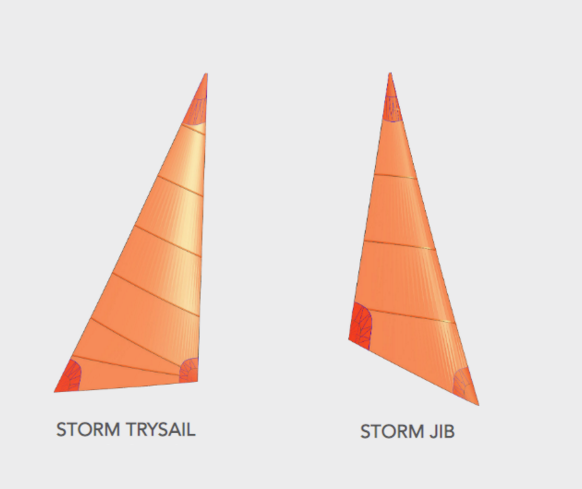
Inshore Sails
Coastal sails, offshore sails, performance sails, downwind sails, storm sails.

Storm Sails: The Ultimate Guide
Looking for the right storm sail to weather any wind.
Sailing in rough weather can be a challenging and sometimes even dangerous experience, but with the right preparation and equipment, it can also be incredibly rewarding. Storm sails are one of the most important pieces of equipment for any sailor looking to safely navigate through high winds and heavy seas.
The importance of storm sails cannot be overstated, as they can mean the difference between safely navigating through a storm and experiencing a catastrophic failure that could put both the crew and the vessel at risk.
But choosing the right storm sails for your boat and learning how to use them effectively requires a solid understanding of sailing theory and practice.
In this article, we’ll provide you with a comprehensive guide to storm sails, covering everything from the different types of storm sails available to how to properly hoist and trim them.
Whether you’re a seasoned sailor or a novice, this guide will give you the knowledge and confidence you need to navigate through any storm with ease and safety.

Table of Contents
What is a storm sail, what does a storm jib do, when should you use a storm sail, storm sails for cruisers, racing storm sails.
- Custom Storm Sails
What Materials Are Storm Sails Made Of?
How much do storm sails cost, how to rig a storm jib, how to look after your storm sail, why are storm jibs orange, should you take the sails down in a storm, do you need storm sails for offshore sailing, what size should a storm sail be.
- Third Reef vs Trysail
Where Can You Buy A Storm Sail?

A storm jib is a type of sail that is specifically designed to be used in heavy weather, when winds are high, the sea state is rough and sailing conditions are becoming dangerous . It is typically a small, triangular sail that is hoisted at the bow of the boat, and it is used in conjunction with other storm sails to help the boat maintain stability and control.
Storm sails are designed to be used in extreme weather conditions and are made from heavier, stronger materials than standard sails.
They are typically smaller than regular sails, with a higher aspect ratio to better withstand gusts and prevent the boat from heeling over too much.
The primary function of a storm jib is to help the boat maintain forward momentum in the face of strong winds and heavy seas.
When the wind is too strong to fly your usual sail setup, it can be difficult to maintain speed and keep the boat moving in a straight line. The storm jib helps to counteract these forces by providing additional power to the boat’s forward motion, allowing it to continue moving through the water.
In addition to providing forward momentum, a storm jib also helps to maintain the boat’s balance and stability. When the wind and waves are pushing against the boat, it can be difficult to keep it upright and prevent it from heeling over too far.
The storm jib helps to counteract this tendency by providing additional lift to the bow of the boat, helping to keep it level and balanced in even the roughest conditions.
Overall, a storm jib is an essential piece of equipment for any sailor who wants to safely navigate through heavy weather conditions. Understanding the function and importance of the storm jib can help you stay safe and in control when the winds and waves are at their strongest.

Storm sails are specifically designed to be used when the winds and waves are too strong for regular sails to handle, and they provide a range of benefits that can help keep the boat and crew safe in even the most challenging conditions.
There are several signs that indicate it is time to use a storm sail. These include:
- Wind speed: If the wind speed has caused you to fully reef and the boat still feels overpowered then you should have probably already switched to a storm sail.
- Sea state: If the waves are high and the sea state is rough, it can be difficult to maintain control of the boat using regular sails alone. Switching to a storm sail can help provide additional stability and control.
- Boat size: Smaller boats are generally more vulnerable to heavy weather conditions than larger boats. If you are sailing a smaller boat and the winds and waves are particularly strong, it may be wise to switch to a storm sail.
- Crew experience: If you or your crew are not experienced in sailing in heavy weather conditions, it may be safer to switch to a storm sail. These sails are specifically designed to be easier to handle and more forgiving than regular sails, making them a good option for novice sailors.
Overall, it is important to pay close attention to the conditions and to use your judgment when deciding whether to switch to a storm sail.
By understanding the signs and being prepared, you can help ensure the safety and well-being of both your crew and your vessel.
It might be that using a storm sail isn’t the right course of action and you need to heave to instead, or run bare poles. The only way you’ll be able to make that judgment is through gaining experience in different conditions, on different boats and with different crew.
The Different Types Of Storm Sails

There are a few different types of storm sail to suit your different needs, so have a think about what types of sailing you do the most to work out which is most appropriate for your needs.
Almost every cruiser, especially those taking on ocean crossings or offshore passages, will own a storm sail.
Typically, they will carry a basic dacron sail that can be stored easily and is easy to rig in an emergency. Most come in an weather proof box that can be stowed alongside your other emergency kit.
These type of storm sails tend to be affordable and universal, meaning you won’t have to custom order your storm jib. You can just buy the right size sail for your boat instead.
For sailors looking to maintain a decent speed in the face of heavy weather there are storm sails more suited to race sailors available.
Many race sailors opt for slightly larger storm jibs than the basic, off the shelf ones most used by cruisers. They might have a deeper reef and longer leech to add to the size of the canvas. These sails give you more control and ultimately, more speed.
Race sailors might find the need for stronger storm sails too, as they will likely be pushing them harder and using them for longer. For this reason, racing storm sails are usually reinforced in the areas that are most likely to see more wear and tear.

Storm sails are typically made of heavy-duty materials that are designed to withstand the toughest weather conditions. The most common materials used for storm sails include high-strength synthetic fibers such as traditional materials like Dacron and nylon.
These materials are chosen for their durability, strength, and resistance to UV damage, salt water, and abrasion.
Dacron is one of the most common sail materials but a storm sail will differ in terms of thickness and colour.
The specific material used for a storm sail will depend on the size and type of boat, as well as the expected weather conditions.
Storm sails are actually pretty affordable compared with how much standard sails cost and other emergency equipment like life rafts, so there really is no excuse not to grab yourself one before setting sail!
For a standard basic storm sail you can expect to pay between $494.99 – $1,099.99. The lower priced sails will be suitable for smaller boats and much larger boats will need to pay for sails in the upper price band.
If you need an even cheaper alternative you might consider looking on the second hand market. As many storm sails come in standard sizes it will be easier to find a sail for sale that fits your boat and needs. Just make sure you give it a good inspection and deal with any repairs immediately.
Obviously, you can choose to get a fancy custom storm sail with all the bells and whistles, and you will pay a lot more for one of those.

The first thing you should always do when you get your new storm jib is to test out rigging it. The last thing you want to do is be stuck in a storm trying to work out how to hank it on properly.
Each storm jib will be slightly different so it’s important to work out how to use your specific type, but here are the rough steps to rig a storm jib:
- Remove the current headsail: Before rigging a storm jib, the current jib sail might have to be removed to make room for the storm jib.
- Prepare the storm jib: The storm jib should be prepared and ready to hoist before starting the rigging process. Make sure that all of the sheets and halyards are properly attached to the sail. It’s best if you store the sail with sheets attached.
- Attach the clew and halyard: Attach the storm jib clew and also the halyard to the head of the sail. The halyard should be attached securely, and the line should be free of knots or tangles.
- Hank on the sail and raise
- Attach the sheets if this wasn’t pre-done
- Tension the sheets: Tension the sheets until the sail is properly trimmed and the sail is flat. The sail should not be too loose or too tight.
- Adjust the tack: Adjust the tack of the sail so that the sail is properly aligned with the wind. The tack should be adjusted until the sail is fully powered.
- Trim the sail: Once the sail is properly aligned, trim the sail to optimize its performance in the current wind conditions.
- Check the rigging: Finally, check all of the rigging and make sure that everything is properly secured and free of knots or tangles.
Remember that rigging a storm jib should be done carefully to ensure the safety of the crew and the boat.
Taking good care of your storm sail is essential if you want it to perform at its best when you need it most.
Storm sails are typically made from heavy-duty materials that are designed to withstand the toughest weather conditions, but they still require regular maintenance and upkeep to ensure they stay in top condition.
Here are some tips on how to look after your storm sail:
- Clean your sail regularly: Salt, dirt, and debris can all take their toll on your sail over time. To keep it in good condition, make sure to clean it regularly using warm water.
- Dry your sail thoroughly: After cleaning your sail, make sure to dry it thoroughly before storing it away. Any residual moisture can lead to mold and mildew, which can weaken the fabric over time.
- Store your sail properly: When not in use, store your sail in a dry, cool place away from direct sunlight. Make sure to fold it carefully to avoid creases that can weaken the fabric.
- Inspect your sail regularly: Regularly inspect your storm sail for signs of wear and tear, including frayed edges, holes, and weakened areas. If you notice any damage, have it repaired as soon as possible to prevent further damage.
By taking good care of your storm sail, you can help ensure that it is always ready to perform at its best when you need it most. With proper maintenance and upkeep, your storm sail can provide you with years of reliable service in even the toughest weather conditions.

Here are some more of the most frequently asked questions on the topic of storm sails.
Storm jibs are often colored bright orange or fluorescent yellow to increase their visibility in low-light or stormy conditions.
This high-visibility color makes it easier for other boats and rescue crews to spot your vessel in an emergency, which can be critical in situations where time is of the essence.
Additionally, bright colors can help make it easier for crew members to see and handle the sail in low-light or stormy conditions, reducing the risk of accidents or mishaps.
Overall, the bright orange color of storm jibs serves an important safety function, helping to keep sailors and their vessels safe in even the most challenging weather conditions.
Whether or not to take the sails down in a storm depends on a variety of factors, including the severity of the storm, the size and type of boat, and the experience and skill level of the crew.
In some cases, it may be safer to take the sails down completely and rely on the engine to navigate through the storm. If the wind is particularly strong you might in danger of losing the mast entirely! In other cases, it may be safer to reduce sail and continue sailing through the storm using a storm sail and heavily reefed main sail.
One of the main concerns with leaving the sails up in a storm is the risk of damage to the sails or rigging. Strong winds and waves can put a great deal of stress on the boat and its equipment, and it is important to take steps to reduce this stress as much as possible.
Ultimately, the decision of whether or not to take the sails down in a storm should be based on a careful assessment of the conditions and a consideration of the safety of the crew and the vessel.
If in doubt, it is always better to err on the side of caution and take the necessary precautions to keep everyone safe. Scour the best sailing forums for advice on tackling storms at sea.

Storm sails are an important piece of safety equipment for offshore sailing, as they are specifically designed to handle the extreme weather conditions that can be encountered at sea.
While not every offshore sailing trip will require the use of storm sails, they are an essential part of any sailor’s toolkit for dealing with unexpected storms or weather events.
When planning an offshore sailing trip, it is important to take into account the potential weather conditions that could be encountered along the way. In areas where strong winds and rough seas are common, it is especially important to have a set of storm sails on board to ensure that you are prepared for any eventuality.
Ultimately, the decision of whether or not to bring storm sails on an offshore sailing trip will depend on a variety of factors, including the size and type of boat, the experience level of the crew, and the expected weather conditions.
We feel it is better to be safe than sorry and to err on the side of caution by bringing a set of storm sails along on your offshore adventure, and personally we wouldn’t leave port without one.
Saying that, in our 4 years of sailing the Med we haven’t once had to use a storm sail. We have been lucky that bad weather has always hit when we are close enough to anchorage to motor, or we have found we can use our smaller stay sail instead. This is a huge advantage of our cutter rigged vessel.
These sizes are taken from Precision Sails , a reputable sail maker who we can speak highly of from experience.
Head to Precision Sails now to check out their top-quality storm sails.
You can buy a storm sail from any reputable sail maker, and sometimes from the second hand market.
We can highly recommend Precision Sails if you’re looking for new sails. Their sails are of excellent quality and the staff there really know what they’re talking about!
Conclusion: The Ultimate Guide To Storm Sails
In conclusion, storm sails are essential safety equipment for any sailor venturing out into open waters. They are specifically designed to withstand high winds and rough seas, providing stability and control to the vessel.
We hope that by following the guidelines outlined in this guide, sailors can equip themselves with the knowledge and tools necessary to navigate even the most extreme weather conditions.
Worried about sailing in a storm? Check out these sailing quotes to arm you with inspiration and courage!
Further reading
- The best lifejackets for sailing
- Best sailing drysuits
- Winter sailing jackets
Similar Posts
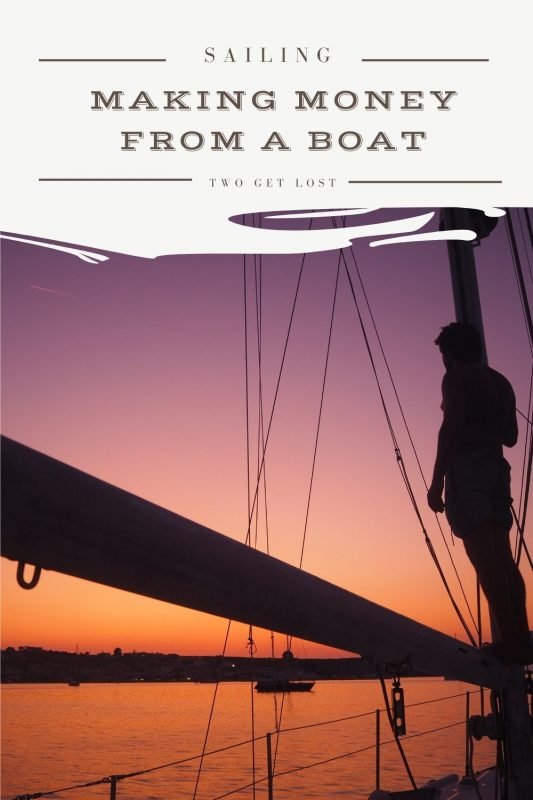
How to Make Money While Living on a Sailboat

The Best Anchors For Sand 2024
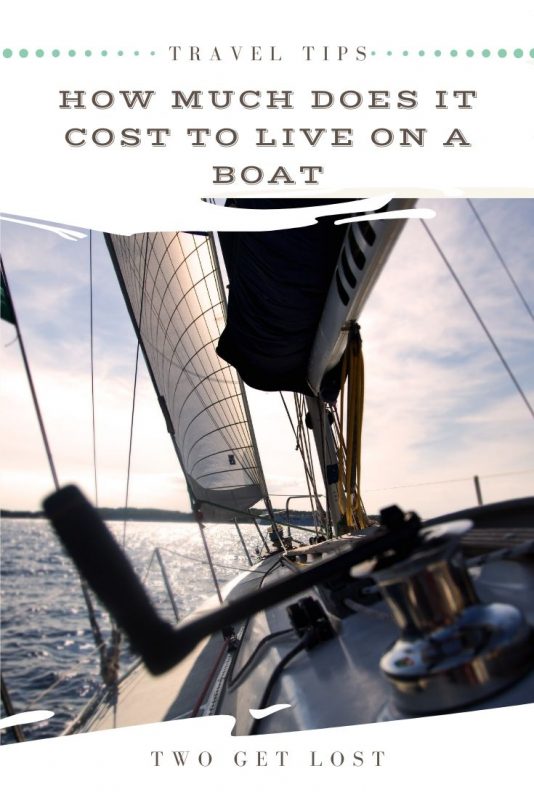
How Much Does It Really Cost To Live On Board A Sailboat?
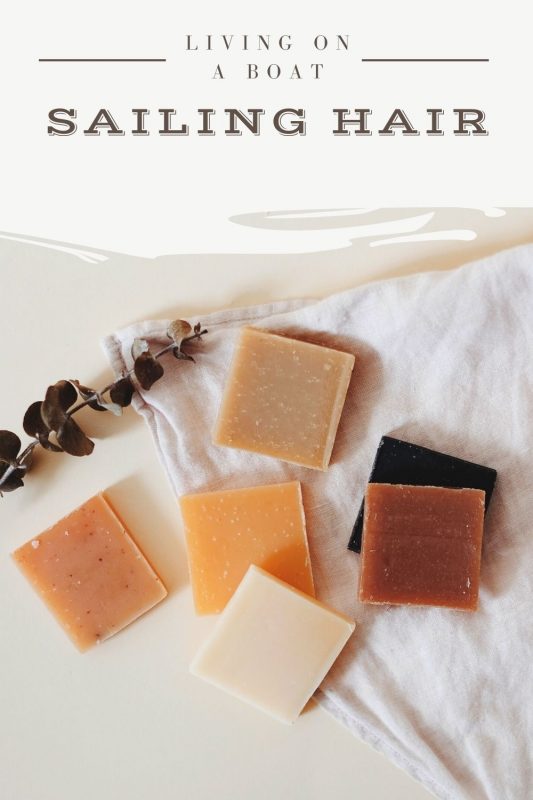
Sailing Hair, Just Don’t Care
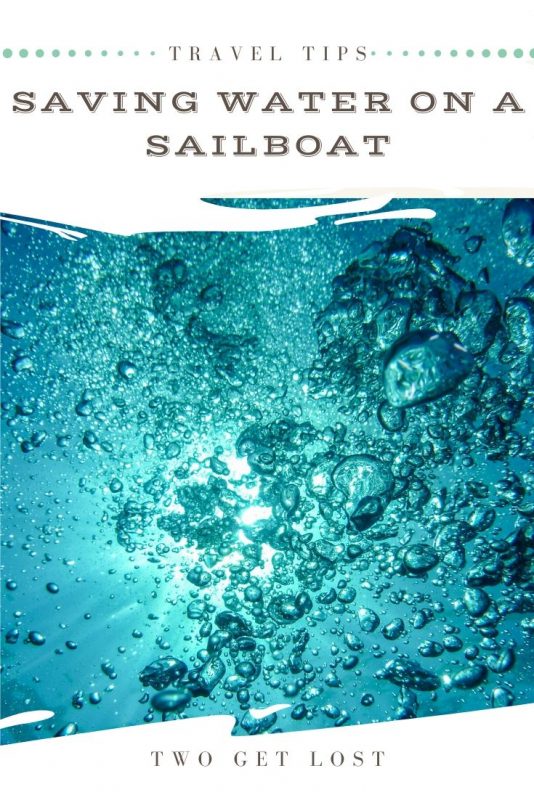
Saving Water On A Sailboat
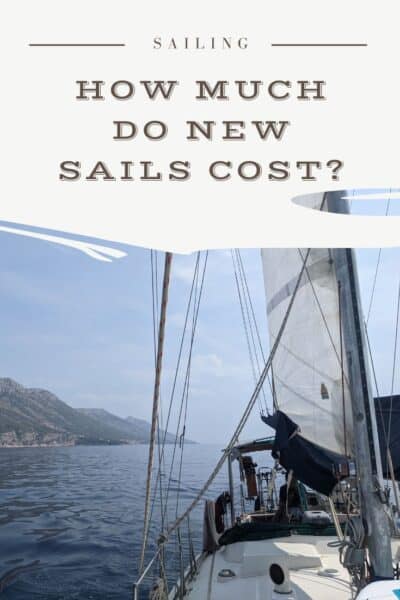
How Much Do New Sails Cost And Do You Really Need Them?
- Search Search Hi! We’re Emily, Adam and Tiny Cat, liveaboard sailors travelling the world on our 38ft sailboat and writing about it as we go. We hope we can inspire you to live the life you’ve always dreamed, whether that’s exploring the world or living a more simple way of life in a tiny home. Find out more. Patreon
- Privacy Policy
- Yachting World
- Digital Edition

Masterclass: How to set a storm trysail
- February 3, 2021
Yachtmaster Ocean instructor and co-founder of Rubicon 3 adventure sailing, Rachael Sprot, offers her hard-won tips on setting a storm trysail

We were running before a deep depression en-route from Ponta Delgada in the Azores to La Coruña. The sea was building behind us and the gale we had was due to become a severe gale soon.
We were perfectly comfortable in our 30-ton Clipper 60 Hummingbird but I knew that the whoops of excitement would soon be replaced by weary silence when the weather started to exact its toll on the crew.
The massive TSS off Finisterre coincides almost perfectly with the continental shelf and we had just under 100 miles to run before we got there.
By my reckoning we’d arrive just as the sea state peaked in 12 hours’ time, and it would be dark. In the current sea state we were already invisible to shipping most of the time and what was worse, they were invisible to us.
The mainsail had a preventer on which made manoeuvring more difficult, and I wasn’t confident that the preventer would hold if one of the crew had a slip of concentration.
We needed storm sails. A storm jib is easy to set and we could have run before the weather under that alone, but I wanted the option of making ground to windward or at the very least holding station, so we needed the trysail too.
What is a trysail?
A trysail is a substitute mainsail designed solely for storm conditions. Setting independently of the boom it is loose-footed and designed to sit above the stack of your mainsail using a long tack strop.

A trysail is rigged independently of the mainsail. Photo: c/o Rachael Sprot
They aren’t designed to give you optimum close-hauled performance, instead they’re a way of clawing some ground to windward or maintaining a safe distance off a dangerous lee shore .
To most sailors a trysail looks very odd, as it meets two conflicting demands: it needs to sit above the bulk of your mainsail so that it can fly in clean air, yet the centre of effort needs to be as low as possible to reduce heeling.
The result is that most trysails will be as long in the foot as they are in the luff, thereby gaining sail area horizontally rather than vertically. The sail also needs to sheet down to the deck, so it will have a long leech with the clew position considerably lower than the tack. In many respects it’s more like a second jib than a small mainsail.
Article continues below…

Skip Novak’s Storm Sailing Techniques Part 3: storm sails
Skip Novak has firm views about the easiest and safest way to reduce sail and carry on in a gale.…

How to train your crew for an emergency: Everything you need to know
I tried a more proactive approach to making sure both skipper and crew are equipped to deal with worst-case scenarios…
A trysail is much better adapted to strong winds than your expensive main. Pete Sanders of Sanders Sails has made hundreds of trysails over the years: “Everything is heavily reinforced. The material itself needs to be a heavy cloth, at least as heavy as your mainsail cloth if not heavier, and you can’t use laminates for a trysail. It’s stitched using three rows of 3-step stitching and the pressed eyes in each corner are reinforced with webbing straps.”
Rigging a trysail
To be able to use your trysail in anger you need to be able to set it independently of the mainsail – there’s no way you’ll want to de-rig your main in rough weather and feed a trysail into the existing track.
There are three options: a separate track on the mast; securing the trysail with tough Velcro straps that attach around the mast; or creating a stay from the masthead to the gooseneck using your topping-lift and hanking on the sail.
All of these options have their drawbacks.
A separate mast track is expensive to retrofit, it works on older-style aluminium spars with curved section profiles but slimmer mast profiles often don’t have room for an extra track.
The Velcro strap option sounds appealing, but it relies on you having a fairly clean mast without many external halyards or other obstacles to catch on.
If you have a substantial ram’s horn on the gooseneck then creating your own stay from the topping lift is an option, but you need to be able to get really good tension on it in order to get a taut luff so it needs to lead to a winch.

Trysails can be used to continue sailing after a boom breakage, as here on Kialoa II in the Rolex Sydney Hobart Race. Photo: Dallas Kilponen
Like all things at sea, preparing your trysail is easiest before the weather hits. If you have the option of feeding your trysail into its separate track and leaving it neatly stowed on deck by the mast or lashed to the boom, it makes life a thousand times easier when it comes to hoisting it.
At the very least it should live somewhere accessible for ocean passages.
There is no point in carrying a trysail if you haven’t practised rigging it. You need to know which sheets you’ll use, where you’ll sheet it to, how high it needs to be to clear the mainsail stack and whether there are any special techniques for raising and lowering it on your boat.
You’ll only find these things out by trying it, preferably when alongside on a sunny day.
Better to reef?
World Sailing used to dictate that all boats in offshore races needed to carry trysails, but recently offer an alternative: in Categories 1&2 (including the Fastnet) you can now opt for a very deep 50% reef instead.
This is essentially a fourth reef and it has many advantages: it’s quicker to put in, you don’t need a separate track on the mast, and in rough weather there’s less work to be done outside the cockpit.
But the decision is not straightforward. Can your boom accommodate a fourth reefing line? Do you want to sail around with all that extra knitting? If it can’t, you’ll need to de-rig one of the other reefing lines and use that. On large boats such as ours the prospect of standing on the coachroof and untying the first or second reef, then trying to feed it through a reefing eye on a flogging leech, doesn’t appeal.
For yachts that regularly sail in exposed seas, having a fourth reefing point in the main gives you options.
If you know gales are likely you could de-rig your first reef before leaving port and run it to the fourth reefing point instead. You can’t use your first reef and might have to opt for a slightly slower speed under your second reef at times, but as you get closer to home if the weather forecast seems stable you can easily pull the fourth reefing line out and feed it through the first reefing point.
It’s much easier to swap the reefing lines over this way, than trying to run the fourth reef as bad weather approaches.
Ideally an ocean-going yacht would have both options: a sturdy trysail which is straightforward to rig and a fourth reefing point in the mainsail.
There are many incidents when trysails have been used because of a boom breakage rather than storm survival conditions. Carrying a trysail gives you valuable redundancy.
If there’s one time that you’re going to damage a mainsail or boom, it’s in heavy weather, with a crash gybe, knockdown or big breaking wave. Setting your trysail allows you to take the boom out of the equation in a controlled way.
Setting a trysail
1 Set the storm jib. This reduces canvas and means you can find a comfortable point of sail to drop the main without being over-powered.
2 Drop the mainsail. This is easier said than done in a gale. Allow the main to luff by coming onto a close reach with the sheet well out. On bigger boats a strong crewmember with a boat hook may be able to pull the luff down by hooking the sliders one-by-one.
3 Run downwind and keep the boat as stable as possible while you do the rest of the deck work. Lower the boom and secure it off to one side with a strong lashing.

A ‘blanket stitch’ lashing of the mainsail to the boom. Photo: c/o Rachael Sprot
4 Now lash the mainsail. On a large yacht with a high boom this is one of the most difficult parts of the job. Throw a long line over the boom a few times and truss it up as best as you can!
5 Attach your trysail at the mast if it isn’t already rigged (pic C). Make sure the tack line is attached to a strong point at the gooseneck – you can even tie it around the gooseneck. Leave some extra length in the tack line so that you can adjust the height of the sail.

A trysail with two sheets to a point on each quarter. Photo: c/o Rachael Sprot
6 Set up two sheets to a point on each quarter, the spinnaker sheet blocks usually work well. Make sure the lazy sheet goes over the boom and forwards of the topping lift (if it’s still attached) or you won’t be able to tack or gybe.
7 Hoist the trysail. This can be easier said than done if you’re running downwind – you’ll almost certainly need to come up on the wind and allow the sail to luff with the sheet eased.
8 Once the sail is up you can adjust its height using the tack line. Make sure that it isn’t chafing the mainsail underneath and that it has a clean air flow and good sheet lead.
If you enjoyed this….
Yachting World is the world’s leading magazine for bluewater cruisers and offshore sailors. Every month we have inspirational adventures and practical features to help you realise your sailing dreams. Build your knowledge with a subscription delivered to your door. See our latest offers and save at least 30% off the cover price.

How to Sail through a Storm: Waves, Sails, Tactics

On the open ocean and in the middle of a storm is when your will, strength, and endurance are tested to their bitter limits. The natural elements from the huge swells to the gusty winds are just a few things you have to worry about. There will also be exhausted crew members and passengers. Her some tips to sail through a storm!
Finding yourself sailing in big waves is when you make sure your best steereris at the helm. Big waves in a storm will test the most experienced sailor.
Try not to sail on a reach across big breaking waves as they can cause a boat to roll. Always keep your speed up to aid steering and try to move toward flat spots. To minimize the risk of a wave washing across the deck only turn the sail in thesmooth water.
Should folding of the sail not reduce enough speed, you should use the trysail and storm jib (storm sails). Storm sails are small, but the sails are perfectly proportioned for high winds. Newer boats have the trysail attached to the boom, with the storm jib set forward of the mast – this keeps the boat balanced.
When facing a storm, there are two possible scenarios – avoid it or head for more space in the open ocean. Storms these days hardly ever arrive unexpectedly due to technological advances and satellite tracked weather patterns. There is a clear danger in being caught up by the storm should you decide to avoid it. And with less maneuvering space, there is a chance of being blown on shore the closer you find yourself to land. The rule of thumb is to stay away from land and to sail away from the storm – looking for a clear path.

There are numerous storm tactics to choose from, and all with the same purpose. Tactics aim to lessen the strain and fight it takes to get one of the boat’s ends to point towards the waves. There is no one storm tactic that works for all boats in every storm.
Sailing with storm sails is one option as the sails provide enough power to allow you to steer and gain control in the waves. You can also try to steer the boat ahead of the storm towards the waves. However, you will need a lot of space and constantly steer into the waves.
Another tactic is to lie ahull. This entails you to fold down all the sails and lie and wait it out. It is a less reliable tactic but one that does not require a lot of work or strain. Your main concern is losing control of the boat and ending up with the side of the boat facing the waves.
Ultimately, the best tactic or way to sail through a storm is to avoid it entirely… Storms are cold, wet, miserable, and highly dangerous out at sea. It is a truly unforgettable experience but does not confuse a sense of adventure out on the seas with a dangerous situation. Never comprise the safety of your crew, passengers, and yourself.
7 Bluewater Cruising Sailboats We Love
Five best places where to sail at least one time in your life, 8 great sailing books for your reading pleasure, sailing for beginners: a guide to ensuring the safety of guests on your boat, live your passion, subscribe to our mailing list.
Hi.. i had to endure a 3 day cyclone of new caledoni in a 25 foot wooden boat….it was hell….i tried sea anchor off the bow…no good.. i would have lost my rudder… i hove too…. i could see i would get rolled… i then tried bernard moitesieur (joshua) method… running before….with drogues…. it was the answer…. bare boat… no sails. It slowed me down…i had stearage… and was a lot more comfortable… it took alot of concentration……you hsd to keep the stern dead square to oncoming huge seas… we did surfed…. luckily i had sea room….. how i survived…. only my FATHER in heaven knows… quit a few boats went missing…..
I certainly wouldn’t have my crew sitting along the rail like a load of Hooray Henry’s racing around the buoys! All but the helmsman and one other on deck, the rest below avoiding hypothermia and being washed overboard. The skipper in that photo was obviously an amateur.

What to Do When Sailing in a Storm: The Complete Guide

It’s your worst nightmare come to life. You’re sailing along in perfectly calm weather when suddenly, the skies gray, thunder booms in the distance and the waves get choppy. Even if you never end up in such a scenario, it’s still a good idea to be ready just in case. What should you do when sailing in a storm?
To stay safe on your sailboat in stormy conditions, remember these tips:
- Make a storm preparedness plan before you venture out
- Don’t freak out, especially when you’re sailing with other people
- Put on your life jacket if you’re not already wearing it and tell your crew to do the same
- Learn how to recognize a storm
- Seek a path that avoids the storm
- Lie ahull, in which you ride out the storm with the sail down
- Use your storm sails to maintain control and steering through rough conditions
- Heave-to, in which you trim your jib and then the main while lashing your helm for steerageway
- Check the weather forecast to avoid future dangers
In this in-depth, complete guide, we’ll walk you through all the above points in much greater detail. Let’s get started.
Sailing in a Storm? 9 Tips for Safe Travels
Have a storm preparedness plan at the ready.
As a sailor, you have to anticipate every possible scenario you might encounter on your boat, even the most unlikely and awful ones. Having a plan to get out of such situations gives you peace of mind. You’ll also have a set of steps to act on so you can hop right to it when trouble comes.
If you often sail with a group of others, sit down with your crew and come up with a storm preparedness plan. You might ask some crew members to man the back of your sailboat and others the front, or someone might unleash the storm sails and others the luff. Whatever it is you want to do on your sailboat, make a plan.
Having a storm preparedness plan doesn’t mean you can’t ever deviate from it. In some situations, it may be more appropriate to heave-to or sail away from the storm, and if so, that’s what you should do.
If this is your first storm aboard a boat, then it’s natural to feel nervous and very unsettled. That’s to be expected. Even seasoned sailors aren’t particularly comfortable handling storms, but they do what they have to.
If you’re captaining a crew especially, you must maintain your poker face. Internally, you can feel turmoil, but outside, you must be stoic, calm, and ready to tackle anything. Even if you’re by yourself, freaking out does nothing but misguide your energy towards your panic. You could also get yourself so worked up that you can’t think straight, causing you to make critical mistakes.
Remember the storm preparedness plan you came up with. Begin completing steps per that plan. Once that starts coming together for you, you should surely calm down.
Besides feeling panicky, make sure to prevent discord among your crew members. They may have agreed to work certain stations when you created your storm preparedness plan, but now that the time has come to actually enact the plan, some crew members might get annoyed or argumentative about their assigned tasks.
Remind your crew that everyone’s lives are at risk until you can get to safety. That should help them recall that there are more important things to worry about right now than who gets to do which task.
Wear Your Life Jacket
Make sure that when drawing up your storm preparedness plan that you remember to include life jackets in there somewhere. There should be enough life jackets for yourself as well as anyone else you have onboard your sailboat.
Not all life jackets are made the same. The U.S. Coast Guard approves of several types or classes of life jacket.
For potential sailing emergencies, we’d recommend Type I, or offshore life jackets. These are ideal when riding in remote waters, rougher seas, and open ocean when you may be stranded for a while. The reflective tape and eye-catching color grab attention. Also, if you or a crew member were to become unconscious after a storm-related boating accident, a Type I life jacket would turn you over so your face is up and out of the water.
You might also invest in a Type II life jacket, which is a near-shore vest. Don these life jackets if riding in inland waters where the conditions are calm and you may be rescued fast. You won’t necessarily be flipped up by your life vest if it’s a Type II, so all your crew members must be conscious when wearing this life jacket.
Know How to Recognize a Storm
You’re no weatherperson, but if you’re a trained sailor, then you should have a knack for predicting storms. Well, predicting maybe isn’t the right word, as you’re using your senses to gauge your surroundings and determine when a weather event may come.
How do you do that? Here are some signs that a thunderstorm could soon roll in on the water:
- The cirrus clouds travel quickly. If you don’t know, cirrus clouds are the shorter, singular clouds that have edges like hair. These clouds are also always at a higher altitude.
- The moon or sun develops a halo around it. This is a sign of humidity, which is typically a predictor of a storm. Look at the brightness of the halo to get a feel for what kind of weather you’re expecting. If the halo is dimmer, the storm won’t be that bad, but a bright halo indicates very inclement weather ahead.
- Look at the birds in the sky, especially the puffins, tropic birds, cormorants, frigate birds, sea ducks, and gulls. Are they all moving away from the sea towards the shoreline? That’s happening for a reason. A storm is imminent.
- Invest in a barometer, a weather tool that tracks your air pressure. If the barometer suddenly gives you a low reading, then the air pressure likely decreased because of an impending storm.
Move from the Storm If You Can
Now that you know a storm is on its way, you have some decision-making to do, and fast. You can either head towards the open ocean or towards shore. Which choice is the smarter one will vary depending on how far you are from the shoreline and the storm. If the shore is 100 miles away but the storm is 25 miles, then veering from it towards open ocean is your smartest bet.
If you have your heart set on getting to shore, make sure you have a clear path in that direction that doesn’t intersect with the storm. If your sailboat gets gripped by tough winds or hard waves, it could catapult into the shoreline, causing massive damage. Sometimes, it’s better not to risk it.
If Not, Lie Ahull
You can’t always avoid or maneuver away from the storm, especially if it comes on suddenly and you weren’t gauging the weather using the tips above. If not, then add the next three tactics to your storm preparedness plan as a Plan B, C, and D.
Lying ahull means you and your crew undo all the sails and lay them flat against your boat. This will prevent the wind from wrestling you in an unintended direction. Otherwise, you just sit and wait for the storm to pass.
Just because your sails are down does not mean your sailboat can’t capsize or that you’re in total control. You’re still at risk, so you should choose when you want to lie ahull strategically. If you’re expecting a day of moderate yet frequent storms, then lying ahull is a good idea. You and your crew can easily pull the sails down, and doing so doesn’t exert much energy.
Once the storms are finally over, you can begin making your way back to shore, hopefully without sustaining any damage to your boat.
If you’re caught in a particularly nasty storm, we would not advise you to lie ahull. You’re essentially a sitting duck when you do this, so conditions must be relatively safe. Otherwise, you’re much better off trying a few other tactics.
Or Use Your Storm Sails
For example, you can rely on your storm sails. If you’ve never used your storm sails before, here’s an introduction. The storm sail or jib attaches to an inner forestay, which is removable if necessary.
Some sailors use a flat-cut headsail as a storm sail and others a reefed roller genoa. The latter is generally not recommended. Since it’s not flat, the roller genoa can become baggy when the sail’s draft moves. This can also make your sailboat heel.
To lift your storm sail when needed, use a halyard. Your storm sail should be sheeted so it’s in a close-haul position. Jot down where the sail’s track is so you can determine pennant length at the stay base. When bad weather calls for you to use your storm sail, you can then connect your pennant to your stay base, hoisting your storm sail when you do.
The International Security Assistance Force or ISAF has published a set of rules known as the Offshore Special Regulations for Storm and Heavy Weather Sails. The rules encompass your sailboat’s storm sail, so keep these in mind when using the sail:
- Cut the luff by almost half (40 percent) when raising a reefed mainsail instead of a trysail.
- Measure the foretriangle to height squared. Then, ensure your staysail, also known as a heavy-weather jib, doesn’t exceed that height squared by more than 13.5 percent.
- You also need to know your forestay length, as the luff can’t be more than 65 percent of it.
- Calculate your foretriangle in height squared, then confirm your storm jib isn’t more than five percent of that.
- You must be able to sheet your trysail without the boom.
- The boom length by the luff length must be larger than the trysail, which needs an area less than 17.5 percent.
- You can’t rely solely on your luff groove when attaching the storm jib.
- You cannot use a high-tech fiber sail as your storm sail.
Or Even Heave-to
The third strategy we’d suggest when sailing in a storm is the heave-to. This is a means of stopping your boat, especially in conditions where the air is especially heavy and your sails could use a break.
If you’ve never done a heave-to before, first, you want to trim your jib so it’s facing the opposite (and yes, the wrong) side it usually does. Next, you want to trim your main, doing so hard. By lashing your helm after that, your sailboat has steerageway. This is just the least amount of speed needed for your helm to work.
Your sailboat, which moves up to get steerageway, will also go forward. This happens because your jib attempts to put downward pressure on the bow. Your bow then moves away from the wind, allowing the main to fill and propel your sailboat.
As you move, your lashed helm should move you in the direction of the wind. Your main sail will also soften. That’s when the jib goes into action, moving the bow as it had tried before. Your main sail fills back up so the rudder moves the bow towards the wind.
Your boat should be far enough from the wind, at least 60 degrees, that your speed is reduced to no more than 2 knots. Your sailboat also becomes more stable, especially compared to lying ahull.
You may have issues with the heave-to depending on which sails are up and how blustery the winds are on that particular day. You might need a sea anchor, attached near the bow, to keep your boat mostly still for the heave-to.
Never Sail Without Knowing the Weather
Using the advice and information in this article, you were able to navigate your sailboat safely back to shore in stormy conditions. You and your crew all admit it was quite an experience, and not one you’d like to repeat again anytime soon.
You don’t necessarily have to. Long before you ever have to look at the clouds and the birds around you to determine whether it will storm, you can use a weather app or website. We would recommend you make this a habit on the days you plan to set sail.
It’s not enough to check the forecast earlier in the week and then head out on the weekend. Weather forecasts change all the time, and you must be prepared. Look at the forecast at the beginning of the week, sure, but then also two days before you go out.
The night before your sailing trip, check the forecast again. Look hour by hour to see what kind of weather is predicted in your area. If your weather service offers a radar, use this too, as it shows when storms may roll in and when they would be their worst.
If inclement weather is on the forecast, we’d strongly dissuade you from sailing. Yes, there’s always a chance the forecast might be incorrect, but is it really worth chancing it? All it takes is surviving one scary experience at sea in a storm to say no, it isn’t.
Conclusion
Is a storm a-brewing while you’re out on the sea in your sailboat? The best way to avoid a storm is to never go out in inclement weather at all. If it’s already too late for that, then you can try a variety of tactics to get through the storm, such as the heave-to, lying ahull, or raising your storm sails. In some cases, you can sail back to shore or into open ocean to dodge the storm altogether.
The most important element of storm survival on your sailboat is the full understanding, communication, and cooperation among you and your fellow crew members. Stay safe!
I am the owner of sailoradvice. I live in Birmingham, UK and love to sail with my wife and three boys throughout the year.
Recent Posts
How To Sail From The Great Lakes To The Ocean
It’s a feat in and of itself to sail to the Great Lakes. Now you want to take it one step further and reach the ocean, notably, the Atlantic Ocean. How do you chart a sailing course to get to the...
Can You Sail from the Great Lakes to the Gulf of Mexico by Boat? 
You have years of boating experience and consider yourself quite an accomplished sailor. Lately, you’ve been interested in challenging yourself and traveling greater distances than ever before. If...
- MarketPlace
- Digital Archives
- Order A Copy

Storm-Sail Choices
Before about 15 years ago, when roller furling had not yet spread to the average voyaging boat, offshore sailors equipped their boats with a storm trysail and storm jib. These sails were bent on when conditions at sea required the reduction of sail beyond the limits of the working sails’ deepest reefs.
The mainsail was lashed securely to the boom and the jib removed from the stay and stored belowdecks. The luff of the storm trysail — an overstitched, multi-ply, bomb-proof sail the size of a large handkerchief — was fitted into a separate track on the mast; the main halyard was removed from the working mainsail and shackled to the head of the trysail, and if conditions were really miserable, the sail was sheeted to windward to reduce speed and prevent tripping over the tops of waves. On the bow, a tiny storm jib, similarly built, was hanked to the jibstay or inner forestay and raised with the jib or foresail halyard. The boat, its sails balanced, would then ride the waves like a duck, the crew hunkered down, waiting for the worst to pass or steering gradually away from the storm’s center. A day or two later, the winds would ease, the storm sails were removed, and the boat was got underway again by its battered, but otherwise unharmed, crew.
Much has changed in the last decade and a half. Boat design has developed to the point that offshore voyagers can now attempt to outrun even fast-moving storms by carefully monitoring weather information via satellite in real time. These boats, capable of speeds far greater than 10 knots, are kept moving, their crew reducing sail only to the point that the boats are not overpowered. If you know where the storms are, the thinking goes, you avoid the worst of their fury, adjusting your course to whisk you on your way.
One of the most vocal proponents of this type of voyage planning is Steve Dashew, developer of the sled-like Sundeer line of yachts and owner of several narrow, elongated boats with high-aspect rigs that he has taken around the world. His series of books (written with his wife, Linda Dashew), from Surviving the Storm to the Offshore Cruising Encyclopedia to Practical Seamanship, all espouse this go-fast approach, which embraces technology for enhanced communication, weather information and high-tech sail-handling.
But the traditionalists, Lyn and Larry Pardey, for example, argue that sooner or later, if you spend enough time at sea, you will be sacked by a storm and your lightweight boat smashed to oblivion, regardless of how fast it is and how informed you are about the storm’s whereabouts. Each of their books, including the ever-popular Storm Tactics Handbook, cautions against relying too much on technology. They, too, have circumnavigated the earth several times on their deep-draft cutters, designed by the late Lyle Hess, that are based on 19th-century British pilot cutters, and they claim their experiences support their beliefs. They are proponents of heaving a boat to, deploying a sea anchor in survival conditions, and waiting out the worst of storms until it is safe to continue.
What’s in between
Dan Neri, author of the recently released Sail Care & Repair (see the review on page 15), has been making racing and cruising sails since 1980 and is currently director of development and head of cruising sails for North Sails in Portsmouth, R.I. Neri said that in the last year and a half he has developed a two-halyard storm jib that uses the traditional approach — a hanked-on jib — with modern materials, including a high-modulus halyard/stay combination made of 12-plait Spectra- or Dyneema-core line, such as Samson’s AmSteel-Blue.
“We build a storm jib or storm staysail with a high-modulus luff rope and hanks,” Neri explained. “Then we make a ‘stay’ out of AmSteel-Blue with a long splice in both ends and a shackle at the bottom. The jib is hanked to the stay, and the jib and stay are stored together. When storm conditions are approaching, the stay is shackled to a pad eye on the foredeck aft of the roller-furler headstay. The stay is then hoisted and tensioned with the first halyard. The jib is hoisted with the second halyard. For this to work, you need two halyards at the same height on the mast. Ideally, the halyards are in the position where an inner stay would be otherwise, typically at the top spreader on a two- or three-spreader rig.”
Neri explained that the potential sagging of the luff of the sail in heavy winds is minimized by having two exceedingly tight halyards &mdash of unstretchable material &mdash and the minimal size of the storm jib. “Eight years ago, halyards simply weren’t strong enough to withstand this kind of tension, and they would also just chafe away,” he added. When not in use, the halyards are secured at the base of the mast. Neri said he’s not the first person to develop the system; he credits racer Steve Pettengill with being the first to introduce to the U.S. sailing community the concept of a high-modulus soft stay aboard his BOC boat Hunter’s Child. Neri installed his first such system last year on Hawk, a custom aluminum design built for circumnavigators Evans Starzinger and Beth Leonard. He has since built seven other two-halyard, storm-jib systems in the last year and a half, he said, and expects to continue at a growing rate in the coming years. Another approach to the modern storm-jib concept is ATN’s Gale Sail, a storm jib that incorporates a flap of cloth that wraps over the rolled jib like a tortilla. Advantages to the Gale Sail include the peace of mind gained in knowing that the roller jib will not become unfurled &mdash it can’t because of the sleeve &mdash and not having to remove the working jib in the first place. Neri questions the value of storm trysails in this day of laminated, ultralight sailcloth. He still builds a fair number of trysails each year when a customer specifically requests one. Despite the availability of Spectra and Kevlar cloth, he maintains that good old Dacron is still the ideal storm-sail fabric. “These sails live in the bilge,” he said. “Laminated fabric will mildew and begin to delaminate as the adhesives evaporate over time. You don’t want a storm sail that’s only going to be around for five years, when the boat’s built to last 20 or 30 years, and a well-built Dacron sail will last that long, too.” As a believer in the get-away-from-storms-before-they-get-you approach to voyaging, Neri believes a storm trysail can actually be a hindrance on a modern boat. “On a modern boat, you sail your boat to get away from the worst part of the storm. The boat’s not going to be subjected to a long period of storm conditions with that kind of boat. A storm trysail doesn’t make sense. And if you’re caught, it’s not a great time to start changing out sails anyway. It’s better to reef down hard. The only time I can see where a trysail might come in handy on this kind of boat is if the boom breaks.” (Tony Gooch, an Australian-Canadian sailor living in Victoria, British Columbia, who recently returned from a solo circumnavigation aboard his 44-foot aluminum cutter, broke his boom in a gale in the Southern Ocean. Gooch then deployed his trysail while effecting repairs to the boom. See the story on Gooch’s trip on page 7.) Neri allowed that heavier, longer-keeled boats would employ different storm tactics. “For those kind of boats, obviously, a storm trysail makes sense; it’s a different kind of sailing,” he added. Neri has also installed deep reefs in a boat’s working mainsail &mdash a reef that leaves the same amount of square footage of sail exposed as recommended by the Offshore Racing Council for a storm trysail &mdash such as that featured on Ellen MacArthur’s Kingfisher. Far above her two working reefs, MacArthur had a deep reef installed on her working mainsail, which, when used, left only the smallest patch of canvas exposed. The tack and clew of the reef were not fitted with steel grommets. Reef lines were passed through loops of webbing that were stitched into heavily reinforced patches. The system is lightweight, eliminates the need to change sails and transfer the halyard, minimizing the crew’s exposure time on the open deck. The Cadillac approach Phin and Joanna Sprague, owners of Portland Yacht Services in Portland, Maine, circumnavigated the world aboard the 72-foot Alden staysail schooner Mariah in the 1970s. With Phin’s brother Abbott, they are building another Alden staysail schooner at their yard. They expect to launch Lion’s Whelp, a full-keel cold-molded design, later this year. Phin Sprague was so impressed by the versatility of the staysail schooner rig on his previous voyages that he was convinced to replicate the design, albeit with a small measure of modern sail technology. “Shortened down, the staysail schooner makes for a very powerful heavy-weather configuration. The staysails are the working sails of the boat. When the weather gets snotty, we can put a second reef in the main and move along well under the reduced main and the two staysails. When Joanna has finally had enough, we can then drop the main staysail and still forereach under the reduced main and forestaysail. If we need to reduce sail even further, we can drop the main and use the two staysails and set the trysail and storm jib, and at some point, we can even back the trysail to reduce headway further, even to the point of drifting sideways, leaving the boat’s own turbulence to windward,” Phin Sprague said. With this combination, he can balance the rig and “forget about the rudder.” The center of effort is concentrated properly for the lateral resistance of the hull and sail plan, and as a consequence, the boat is directionally stable at very low hull speed without needing steerageway to maintain a stable orientation to the seas and wind. Thus with no one on the helm, the boat doesn’t “hunt around.” He tries to keep the boat moving but not overpowered, so it will blast through the tops of waves and risk being knocked down when it loses stability, but enough to maintain headway. The long keel of the schooner will also prevent broaching in the event of being overtaken by a breaking sea, he said. “Of course, this advice is only worth anything on a long-keeled boat,” Sprague added. Is he a traditionalist? “I drive an old American station wagon that takes the bumps well; I don’t want to wear a helmet and a mouthguard when I go sailing. If I’m looking to live on a boat that can go anywhere, I want the Cadillac ride,” Sprague said. “Maybe it’s a concession to growing older, but sailing on a modern boat with a fin keel and a nearly flat bottom in heavy weather is like riding a piledriver. Part of seaworthiness is that you need your crew to be able to function. When you’re not trying to break any records, you want the least amount of stress possible. The shape of my hull and my sail inventory supports that.” Lion’s Whelp’s working sails were built of Dacron by Butch Ulmer of Ulmer Kolius in City Island, N.Y. Ulmer convinced Sprague to leave the main and staysails loose-footed, bent to their booms only at the clew and tack, for optimal sail shape. His Reckmann roller jib is fitted with both a luff tape and a series of grommets along the leading edge that will be used to lace the sail to the stay, an added protection to guard against losing the sail if the luff tape fails. (This is also an ORC recommendation for roller systems.) Sprague also had several storm sails built by Richard Hallett’s loft in Falmouth, Maine, (Hallett Canvas & Sails). These sails are all of fluorescent-orange Dacron cloth &mdash so that the crew of an aircraft can spot the vessel in storm conditions. Included in the storm inventory is a storm trysail that will be run up a separate track on the mast. The sail can be stored on deck &mdash on a crossing to northern Europe, say &mdash and lashed in place. The sail is flaked in the bag, tied inside the bag with webbing, with the head at the top so that the bronze cars can be prepositioned on the track, which leads low to the deck. When the sail is needed, the halyard is switched, the tack secured with a tag line, the sheet bent to the clew, and up she goes. Richard Hallett, an accomplished ocean racer and sailor, also believes in the benefit of storm trysails and has numerous harrowing tales to bolster his points. The traditional approach to storm sails is still pervasive on the U.S. West Coast, perhaps because of the lack of sheltered cruising waters for serious sailors. “We build a storm trysail for almost every boat that sails offshore,” said Carol Hasse of Port Townsend Sails, in Port Townsend, Wash. Hasse said that her loft builds sails predominantly for offshore voyaging boats. At the time of the interview, the loft was building sails for numerous production and custom offshore sailing vessels, including a Hallberg-Rassy, a Hylas, and a Valiant, and each of them was equipped with trysails and an inner forestay for hanking on a storm jib. “Having a storm trysail is a requirement in my opinion,” Hasse said. “It gets the center of effort lower and farther aft; if the boom breaks, you have a spare main, and it also reduces the wear on the mainsail.” A ride to Iceland Dave Martin, his wife and three children live aboard a 33-foot hard-chine steel sloop with a fin keel and skeg-hung rudder, built in France in 1981. “What Driver lacks in beauty and finesse is made up for with bulletproof reliability,” Martin said. They have sailed across the Atlantic and cruised northern Europe and the ice-choked islands of the far North Atlantic and Arctic Ocean, including Spitsbergen and Jan Mayen Island. “Good-quality storm sails are the difference between having a good storm experience and having a miserable time. Being able to make headway in bad conditions is good for morale. This is especially true during a long passage, such as on our 2,700-mile passage to Iceland,” Martin said. The boat’s Sobstad mainsail is built of 7.5-ounce Dacron and features triple stitching, a double leach and extra-reinforced corners. The sail has three reef points. The boat also has a 40-square-foot jib made of 10-ounce cloth, but Martin has found that in storm conditions he prefers to strike the jib altogether and sail under the triple-reefed main alone, which will still allow headway. And although the mast is fitted with a trysail track, Martin prefers to deep-reef the main than set a trysail. “From the standpoint of safety, I feel most comfortable when the boat is in motion. My favorite tactic in high winds with breaking seas is to sail close-hauled. Even a scant 2 or 3 knots of headway can be enough to achieve this goal,” Martin said. “During the height of the gale (on the trip to) Iceland, we made forward progress with a triple-reefed main &mdash no jib. Our Monitor wind vane steered flawlessly.” Martin and his wife repair their own sails with a Pfaff sewing machine onboard. Before owning Driver, they circumnavigated in a Cal-25. It remains to be seen if the trysail and storm jib remain an integral part of the voyager’s sail inventory. Like most choices having to do with boats, storm-sail inventory comes down to personal preference, and a sailor’s past experiences. In this age of modern fabrics and cutting-edge boat design, though, today’s ocean sailors clearly enjoy access to more sail options than ever before. Contributing Editor Twain Braden is the author of The Handbook of Sailing Techniques, published by the Lyons Press.
By Ocean Navigator
The Worldwide Leader in Sailmaking
- Sail Care & Repair
- Sailing Gear
- Sail Finder
- Custom Sails
- One Design Sails
- Flying Sails
- New Sail Quote
- 3Di Technology
- Helix Technology
- Sail Design
- NPL RENEW Sustainable Sailcloth
- Sailcloth & Material Guide
- Polo Shirts
- Sweaters & Cardigans
- Sweatshirts & Hoodies
- Accessories
- Mid & Baselayers
- Deckwear & Footwear
- Luggage & Accessories
- Spring Summer '24
- Sailor Jackets
- Maserati X North Sails
- NS x Slowear
- Sailor Jacket
- Sustainability
- North Sails Blog
- Sail Like A Girl
- Icon Sailor Jacket
- Our Locations
- North SUP Boards
- North Foils
- North Kiteboarding
- North Windsurfing
SAIL FINDER
SAILING GEAR
COLLECTIONS & COLLAB
COLLECTIONS
WE ARE NORTH SAILS
ACTION SPORTS
Popular Search Terms
Collections
Sorry, no results for ""
How To Sail Safely Through a Storm
How to sail safely through a storm, tips and tricks to help you get home safe.

Compared to the quick response and sudden nature of a squall , sailing through a storm in open water is an endurance contest. In addition to big wind, you’ll have to deal with big waves and crew fatigue.
Sailing in Waves
Sailing in big waves is a test of seamanship and steering, which is why you should put your best driver on the helm. Experienced dinghy sailors often are very good at heavy air steering, because they see “survival” weather more often than most cruisers.
Avoid sailing on a reach across tall breaking waves; they can roll a boat over. When sailing close-hauled in waves, aim toward flat spots while keeping speed up so you can steer. To reduce the chance of a wave washing across the deck, tack in relatively smooth water. A cubic foot of water weighs 64 pounds, so a wave can bring many hundreds of pounds of water across the deck.
Sailing on a run or broad reach in big waves is exhilarating, but be careful not to broach and bring the boat beam-to a breaker. Rig a preventer to hold the boom out.

Storm Sails
If reefing isn’t enough to reduce power, it’s time to dig out your storm sails — the storm trysail and storm jib. They may seem tiny, but since wind force rises exponentially, they’re the right size for a really big blow. Storm trysails are usually trimmed to the rail, but some modern ones are set on the boom. The storm jib should be set just forward of the mast to keep the sail plan’s center of effort near the boat’s center of lateral resistance. This helps keep the boat in balance.
Storm Strategy
The first decision before an approaching storm is the toughest: Run for cover, or head out to open water for sea room? With modern forecasting, a true storm will rarely arrive unannounced, but as you venture further offshore the chances of being caught out increase. While running for cover would seem the preferred choice, the danger lies in being caught in the storm, close to shore, with no room to maneuver or run off.
Two classic storm strategies are to try to keep away from land so you’re not blown up on shore, and to sail away from the storm’s path — especially its “dangerous semicircle,” which is its right side as it advances.
Storm Tactics
Storm tactics help you handle a storm once you’re in it. There are several proven choices, all of which aim to reduce the strain and motion by pointing one of the boat’s ends (either bow or stern) toward the waves. No one tactic will work best for all boats in all conditions.
Sail under storm jib and deeply reefed mainsail or storm trysail. This approach provides the most control. Sails give you the power to steer and control your boat in the waves.
Run before the storm with the stern toward the waves, perhaps towing a drogue to slow the boat. This tactic requires a lot of sea room, and the boat must be steered actively. Another concern is that you will remain in front of an approaching storm, rather than sailing out of its path.
Heave-to on a close reach with the jib trimmed to windward. Heaving-to can be an excellent heavy weather tactic, though some boats fare better than others.
Deploy a sea anchor while hove-to or under bare poles. A sea anchor is a small parachute set at the end of a line off the bow. A sea anchor helps keep the bow up into the waves so the boat won’t end up beam to the seas. One concern is the load on the rudder as waves push the boat aft.
Another alternative is lying ahull, simply sitting with sails down. This passive alternative is less reliable than the other tactics, as you lose the ability to control your angle to the waves and may end up beam to the seas. Furthermore, the motion of the boat rolling in the waves without the benefit of sails can be debilitating.
Want to order a storm trysail or storm jib for your boat? Contact a North Sails Expert here .
How to Heave-To
Wouldn’t it be great if, during a heavy air sail, you could just take a break, and relax for a bit? Imagine a short respite from the relentless pitching and pounding: a chance to rest, take a meal, or check over the boat in relative tranquility. Well, you can. The lost art of heaving-to allows you to “park” in open water.
To heave-to, trim the jib aback (i.e., to the wrong side), trim the main in hard, and lash the helm so the boat will head up once it gains steerageway. As the jib tries to push the bow down, the bow turns off the wind and the main fills, moving the boat forward. Once the boat begins to make headway, the lashed helm turns the boat toward the wind again. As the main goes soft the jib once again takes over, pushing the bow down. The main refills, and the rudder pushes the bow into the wind again.
The boat won’t actually stop. It will lie about 60 degrees off the wind, sailing at 1 or 2 knots, and making significant leeway (sliding to leeward). The motion will be much less than under sail, and dramatically more stable and pleasant than dropping all sails and lying ahull. You will also be using up less sea room than if you run before the storm at great speed.
Achieving this balance will require some fine tuning, depending on the wind strength, your boat design, and the sails you are flying. Also, fin-keeled boats do not heave to as well as more traditional designs.
In storm seas, some boats will require a sea anchor off the bow to help hold the boat up into the waves while hove-to.

Alternate Storm Strategy: Don’t Go
If conditions are wrong, or are forecast to worsen, don’t go. If you can avoid the storm, then do so.
If you’re at home, stay there. If you’re mid-cruise, button up the boat, make sure your anchor or mooring or dock lines are secure, and then read a book or play cards. Relax. Enjoy the time with your shipmates. Study the pile of Owners’ Manuals you’ve accumulated with each piece of new gear. Tinker with boat projects.
Put some soup on the stove, and check on deck every so often to make sure the boat is secure. Shake your head as you return below, and remark, “My oh my, is it nasty out there.”
If your boat is threatened by a tropical storm or hurricane, strip all excess gear from the deck, double up all docking or mooring lines, protect those lines from chafe, and get off. Don’t risk your life to save your boat.
Misery and Danger
Although everyone will remember it differently years later, a long, wet, cold sail through a storm can be miserable. As the skipper, you need to make the best of it: watch over your crew, offer relief or help to those who need it, and speak a few words of encouragement to all. “This is miserable, but it will end.”
Take the time to marvel at the forces of nature, and at your ability to carry on in the midst of the storm. Few people get to experience the full fury of a storm. It may not be pleasant, but it is memorable.
While misery and discomfort can eventually lead to fatigue, diminished performance, and even danger, do not mistake one for the other. Distinguish in your own mind the difference between misery and danger. Don’t attempt a dangerous harbor entrance to escape misery; that would compromise the safety of the boat and crew, just to avoid a little discomfort.
Interested in a new sail quote or have questions about your sails? Fill out our Request a Quote form below and you will receive a reply from a North sail expert in your area.
REQUEST A QUOTE
FEATURED STORIES
How to care for your foul weather gear.
27 February
GITANA TEAM WINS INAUGURAL ARKEA ULTIM CHALLENGE
Npl renew faq.
- Refresh page
You are using an outdated browser. Please upgrade your browser to improve your experience.
The Sail Store
Search for sails by boat model, (example: catalina 22, hobie 18, cape dory), [email protected], 888-946-8242, [email protected] 888-946-8242, sail store storm sails are rugged sails, available in white or fluorescent orange. the storm jibs and storm trysails are built using u.s. made cloth from challenge - one of the industry's most respected sail cloth manufacturers..
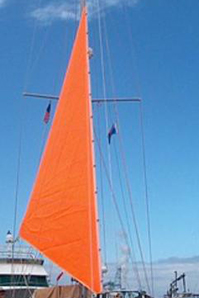
Yachting Monthly
- Digital edition

Heavy weather sailing: How to reduce sail in a storm
- Theo Stocker
- May 26, 2023
It’s one thing dealing with heavy weather sailing offshore, but what should coastal sailors do when they need to shorten sail in a blow? Martin Thomas explains, and Theo Stocker puts it to the test
Knowing the theory behind how to reduce sail in a storm is one thing, but does that theory work id you do get caught out? We took to the Solent on 40 knot winds to find out if the usual advice was easy to put into practise while a sea in inclement weather.
This is the second on a new Yachting Monthly series with the first part covering how to prepare your boat for a storm . We thought it was worth drawing on the combined knowledge of the seasoned sailors who have contributed to the latest edition of Adland Coles’ bible on the subject of windy weather, Heavy Weather Sailing , examining what should be done in heavy weather in coastal water, and then trying it out to see what works in practice.
Yachting Monthly editor Theo Stocker volunteered for this enviable duty, which he insists was actually great fun, and having watched the weather forecast all winter, managed to line up yachts, RIBs, crew and photographers with a Force 8 gale in order to go and play in the rough stuff.
For this endeavour Theo wanted a sturdy yacht that would be up to taking on extreme weather easily. And for that, you hardly need look further than the ever-faithful Contessa 32 . Assent was formerly owned by Willy Ker and is now owned by the Rogers family and skippered on the day by Kit Rogers, second-generation builder of Contessa 32s, among other things, at Jeremy Rogers Ltd in Lymington.

Genoas will wrinkle and bag when reefed due to the belly cut into the sail. A new, well-cut sail will be better behaved. Photo: Richard Langdon
Reducing sail in a storm
The first action to take as the wind rises is to shorten sail. Reef early and start by reefing the main, especially if you are still trying to make to windward. For most coastal and cruising sailors, standard reefing points are sufficient, although many new sails will have just two rows of reefing points, with a corresponding paucity of deck hardware.
It is sensible to specify a third reef as standard, and to find ways to handle the additional controls. If worse weather is anticipated then ask a sailmaker to put in a deep reef, usually a fourth reef. Be sure that the deep reef luff cringle will reach the staghorn, using a pair of ‘spectacles’ (two rings secured by a webbing strap through the cringle) if necessary. Some racing organisations such as RORC insist that boats carry a trysail, but for cruisers, in my view, this is not necessary. A trysail is a difficult sail for a short-handed crew to rig, especially in the conditions when it might be needed.
Article continues below…
A partly furled Genoa becomes baggy and performs poorly when the boat is close- hauled. If you plan to make longer voyages, when encountering rough weather is more likely, then fit a removable inner forestay before you set out. This can hang quietly attached to the toe rail or chain plate until needed. Then as the storm approaches, it can be deployed with a ratchet, wheel or lever to tighten the wire and a reduced headsail hanked on.

Having been under load, the genoa needed extra turns round the foil to furl away fully. Photo: Richard Langdon
Such a headsail will set kindly in strong conditions even when hauled to the wind. Be sure to have a suitable lead for the sheets as the blocks for the furling Genoa may not be in the right place.
Carry a storm jib of heavier canvas, although for most sailors the storm jib will be flown rarely, if ever. With a fully reefed main and a Number 3 jib or storm jib set on an inner forestay, most cruisers can survive quite severe weather for long enough to reach shelter.
It would be worth consulting a rigger or surveyor before fitting such an arrangement to agree the best means of doing so, and that both rig and deck attachment points will be strong enough to support the loads.

We lashed the reef clew down to keep it close to the boom. Photo: Richard Langdon
Our experience of reducing sail in a storm
Willy Ker said of Assent that ‘You can stick more or less anything with three reefs and the jib rolled well in. If it gets really nasty, I roll the headsail away. I don’t think I’ve ever set a storm jib.’ So setting a storm jib and trysail may have been overly cautious, but it was a good exercise.
For most of our time on the water, we had the deep third reef tucked in the main. A handkerchief compared to the full main, it set flat with good tension, and supported the boom at a sensible height. We did have to re-lead the first reef line as the third, as it gets used so rarely. Doing anything with the boom in heavy weather is best avoided, so if you can keep the third reef rigged, it is makes life easier

Deck work upwind is a damp and precarious experience. Photo: Richard Langdon
Genoa furling
We began with a scrap of the furling genoa. Assent was fitted with a fairly new and very nice set of Kevlar-reinforced dacron cruising sails from Sanders which hold their shape extremely well, and I was pleasantly surprised by how well the Genoa set even when heavily furled, compared to the wrinkled bag I was left with on my own Sadler 29’s stretchy genoa, that served only to induce heel and pull the bow off the wind.
The thing that caught us out was that, despite having been used as it was for over two year without issue, when using the roller-furling to reef the Genoa in a blow, the force of the wind pulled the turns of sail much tighter around the foil, exacerbated by any stretch in the furling line. Once we’d reached the end of the furling line, we still needed three or four more turns to get the sail away. The only way to achieve this was unreeving the sheets and passing them around the forestay, after which we had sufficient turns – not a fun job in heavy weather.

Getting a good sheeting angle is critical. Two sheet cars meant we could keep both sheets rigged. Photo: Richard Langdon
Rigging the storm jib
Hanking on the storm jib was fairly straightforward, and made easier with two people on deck. There was a little bit of guess work as to which way to lead the sheets around the shrouds and whether the forward genoa car would be suitable. As the storm jib was very high-clewed, it actually worked well with the car position, and it was best to keep the sheets outside the shrouds, even when close hauled, as we were sailing a fairly free angle. Re-leading the sheets and moving the genoa car, as we needed to for the genoa when heavily furled, required putting someone on deck, and tacking to free off the leeward side.
It is worth knowing which way to lead sheets before you have to do it for real to minimise time on deck. It isn’t always obvious if you haven’t tried it beforehand.

The trysail is a faff to rig, but a brilliant sail once set. Photo: Richard Langdon
Possibly the least used sail in any boat’s wardrobe, and for good reason. If you need to use the main mast track, getting the main sliders out and trysail sliders in was a pig of a job. The mainsail needed lashing down first, then it was a two-person job to wrestle the sliders free, with clevis pins and split rings that in these conditions were fiddly and potentially easy to lose, yet critical to the functioning of the system.
We led the sheets to the secondary winches via the spinnaker blocks on the quarters, which worked well, though they did cross the cockpit to do so.
If you can avoid this palaver, I would. You would be better to run under storm jib alone, or bare poles, though you will then be restricted to sailing across or downwind. It might be possible to rig a trysail on a wire aft of the mast, or with parrel beads around the mast as an easier method.
Despite all of this, I am a fan of the trysail. It is a brilliant sail once set – we were amazed at how well the boat sailed upwind with it. We clocked over 6 knots in 35-40 knots of wind on a fetch, and could point pretty high upwind. The helm remained balanced, heel was manageable and the boat felt under control. This is basically the only option if you need to make way upwind in extreme conditions, and anecdotes suggest this is one of the safest courses to steer. This may be more important for coastal than offshore sailors, given the potential need to sail upwind away from a lee shore when there isn’t searoom.
A dedicated trysail track would be invaluable if you carry a trysail. Without a track, the effort to rig it, and the risk of people spending a protracted period on deck, may put you off doing so. The sail will increase your options if you’re in a squeeze.
Enjoyed reading this?
A subscription to Yachting Monthly magazine costs around 40% less than the cover price .
Print and digital editions are available through Magazines Direct – where you can also find the latest deals .
YM is packed with information to help you get the most from your time on the water.
- Take your seamanship to the next level with tips, advice and skills from our experts
- Impartial in-depth reviews of the latest yachts and equipment
- Cruising guides to help you reach those dream destinations
Follow us on Facebook , Twitter and Instagram.
The Ultimate Guide to Sail Types and Rigs (with Pictures)
What's that sail for? Generally, I don't know. So I've come up with a system. I'll explain you everything there is to know about sails and rigs in this article.
What are the different types of sails? Most sailboats have one mainsail and one headsail. Typically, the mainsail is a fore-and-aft bermuda rig (triangular shaped). A jib or genoa is used for the headsail. Most sailors use additional sails for different conditions: the spinnaker (a common downwind sail), gennaker, code zero (for upwind use), and stormsail.
Each sail has its own use. Want to go downwind fast? Use a spinnaker. But you can't just raise any sail and go for it. It's important to understand when (and how) to use each sail. Your rigging also impacts what sails you can use.

On this page:
Different sail types, the sail plan of a bermuda sloop, mainsail designs, headsail options, specialty sails, complete overview of sail uses, mast configurations and rig types.
This article is part 1 of my series on sails and rig types. Part 2 is all about the different types of rigging. If you want to learn to identify every boat you see quickly, make sure to read it. It really explains the different sail plans and types of rigging clearly.

Guide to Understanding Sail Rig Types (with Pictures)
First I'll give you a quick and dirty overview of sails in this list below. Then, I'll walk you through the details of each sail type, and the sail plan, which is the godfather of sail type selection so to speak.
Click here if you just want to scroll through a bunch of pictures .
Here's a list of different models of sails: (Don't worry if you don't yet understand some of the words, I'll explain all of them in a bit)
- Jib - triangular staysail
- Genoa - large jib that overlaps the mainsail
- Spinnaker - large balloon-shaped downwind sail for light airs
- Gennaker - crossover between a Genoa and Spinnaker
- Code Zero or Screecher - upwind spinnaker
- Drifter or reacher - a large, powerful, hanked on genoa, but made from lightweight fabric
- Windseeker - tall, narrow, high-clewed, and lightweight jib
- Trysail - smaller front-and-aft mainsail for heavy weather
- Storm jib - small jib for heavy weather
I have a big table below that explains the sail types and uses in detail .
I know, I know ... this list is kind of messy, so to understand each sail, let's place them in a system.
The first important distinction between sail types is the placement . The mainsail is placed aft of the mast, which simply means behind. The headsail is in front of the mast.
Generally, we have three sorts of sails on our boat:
- Mainsail: The large sail behind the mast which is attached to the mast and boom
- Headsail: The small sail in front of the mast, attached to the mast and forestay (ie. jib or genoa)
- Specialty sails: Any special utility sails, like spinnakers - large, balloon-shaped sails for downwind use
The second important distinction we need to make is the functionality . Specialty sails (just a name I came up with) each have different functionalities and are used for very specific conditions. So they're not always up, but most sailors carry one or more of these sails.
They are mostly attached in front of the headsail, or used as a headsail replacement.
The specialty sails can be divided into three different categories:
- downwind sails - like a spinnaker
- light air or reacher sails - like a code zero
- storm sails

The parts of any sail
Whether large or small, each sail consists roughly of the same elements. For clarity's sake I've took an image of a sail from the world wide webs and added the different part names to it:

- Head: Top of the sail
- Tack: Lower front corner of the sail
- Foot: Bottom of the sail
- Luff: Forward edge of the sail
- Leech: Back edge of the sail
- Clew: Bottom back corner of the sail
So now we speak the same language, let's dive into the real nitty gritty.
Basic sail shapes
Roughly speaking, there are actually just two sail shapes, so that's easy enough. You get to choose from:
- square rigged sails
- fore-and-aft rigged sails
I would definitely recommend fore-and-aft rigged sails. Square shaped sails are pretty outdated. The fore-and-aft rig offers unbeatable maneuverability, so that's what most sailing yachts use nowadays.

Square sails were used on Viking longships and are good at sailing downwind. They run from side to side. However, they're pretty useless upwind.
A fore-and-aft sail runs from the front of the mast to the stern. Fore-and-aft literally means 'in front and behind'. Boats with fore-and-aft rigged sails are better at sailing upwind and maneuvering in general. This type of sail was first used on Arabic boats.
As a beginner sailor I confuse the type of sail with rigging all the time. But I should cut myself some slack, because the rigging and sails on a boat are very closely related. They are all part of the sail plan .
A sail plan is made up of:
- Mast configuration - refers to the number of masts and where they are placed
- Sail type - refers to the sail shape and functionality
- Rig type - refers to the way these sails are set up on your boat
There are dozens of sails and hundreds of possible configurations (or sail plans).
For example, depending on your mast configuration, you can have extra headsails (which then are called staysails).
The shape of the sails depends on the rigging, so they overlap a bit. To keep it simple I'll first go over the different sail types based on the most common rig. I'll go over the other rig types later in the article.
Bermuda Sloop: the most common rig
Most modern small and mid-sized sailboats have a Bermuda sloop configuration . The sloop is one-masted and has two sails, which are front-and-aft rigged. This type of rig is also called a Marconi Rig. The Bermuda rig uses a triangular sail, with just one side of the sail attached to the mast.
The mainsail is in use most of the time. It can be reefed down, making it smaller depending on the wind conditions. It can be reefed down completely, which is more common in heavy weather. (If you didn't know already: reefing is skipper terms for rolling or folding down a sail.)
In very strong winds (above 30 knots), most sailors only use the headsail or switch to a trysail.

The headsail powers your bow, the mainsail powers your stern (rear). By having two sails, you can steer by using only your sails (in theory - it requires experience). In any case, two sails gives you better handling than one, but is still easy to operate.
Let's get to the actual sails. The mainsail is attached behind the mast and to the boom, running to the stern. There are multiple designs, but they actually don't differ that much. So the following list is a bit boring. Feel free to skip it or quickly glance over it.
- Square Top racing mainsail - has a high performance profile thanks to the square top, optional reef points
- Racing mainsail - made for speed, optional reef points
- Cruising mainsail - low-maintenance, easy to use, made to last. Generally have one or multiple reef points.
- Full-Batten Cruising mainsail - cruising mainsail with better shape control. Eliminates flogging. Full-length battens means the sail is reinforced over the entire length. Generally have one or multiple reef points.
- High Roach mainsail - crossover between square top racing and cruising mainsail, used mostly on cats and multihulls. Generally have one or multiple reef points.
- Mast Furling mainsail - sails specially made to roll up inside the mast - very convenient but less control; of sail shape. Have no reef points
- Boom Furling mainsail - sails specially made to roll up inside the boom. Have no reef points.
The headsail is the front sail in a front-and-aft rig. The sail is fixed on a stay (rope, wire or rod) which runs forward to the deck or bowsprit. It's almost always triangular (Dutch fishermen are known to use rectangular headsail). A triangular headsail is also called a jib .
Headsails can be attached in two ways:
- using roller furlings - the sail rolls around the headstay
- hank on - fixed attachment
Types of jibs:
Typically a sloop carries a regular jib as its headsail. It can also use a genoa.
- A jib is a triangular staysail set in front of the mast. It's the same size as the fore-triangle.
- A genoa is a large jib that overlaps the mainsail.
What's the purpose of a jib sail? A jib is used to improve handling and to increase sail area on a sailboat. This helps to increase speed. The jib gives control over the bow (front) of the ship, making it easier to maneuver the ship. The mainsail gives control over the stern of the ship. The jib is the headsail (frontsail) on a front-and-aft rig.
The size of the jib is generally indicated by a number - J1, 2, 3, and so on. The number tells us the attachment point. The order of attachment points may differ per sailmaker, so sometimes J1 is the largest jib (on the longest stay) and sometimes it's the smallest (on the shortest stay). Typically the J1 jib is the largest - and the J3 jib the smallest.
Most jibs are roller furling jibs: this means they are attached to a stay and can be reefed down single-handedly. If you have a roller furling you can reef down the jib to all three positions and don't need to carry different sizes.

Originally called the 'overlapping jib', the leech of the genoa extends aft of the mast. This increases speed in light and moderate winds. A genoa is larger than the total size of the fore-triangle. How large exactly is indicated by a percentage.
- A number 1 genoa is typically 155% (it used to be 180%)
- A number 2 genoa is typically 125-140%
Genoas are typically made from 1.5US/oz polyester spinnaker cloth, or very light laminate.

This is where it gets pretty interesting. You can use all kinds of sails to increase speed, handling, and performance for different weather conditions.
Some rules of thumb:
- Large sails are typically good for downwind use, small sails are good for upwind use.
- Large sails are good for weak winds (light air), small sails are good for strong winds (storms).
Downwind sails
Thanks to the front-and-aft rig sailboats are easier to maneuver, but they catch less wind as well. Downwind sails are used to offset this by using a large sail surface, pulling a sailboat downwind. They can be hanked on when needed and are typically balloon shaped.
Here are the most common downwind sails:
- Big gennaker
- Small gennaker
A free-flying sail that fills up with air, giving it a balloon shape. Spinnakers are generally colorful, which is why they look like kites. This downwind sail has the largest sail area, and it's capable of moving a boat with very light wind. They are amazing to use on trade wind routes, where they can help you make quick progress.
Spinnakers require special rigging. You need a special pole and track on your mast. You attach the sail at three points: in the mast head using a halyard, on a pole, and on a sheet.
The spinnaker is symmetrical, meaning the luff is as long as its leech. It's designed for broad reaching.

Gennaker or cruising spinnaker
The Gennaker is a cross between the genoa and the spinnaker. It has less downwind performance than the spinnaker. It is a bit smaller, making it slower, but also easier to handle - while it remains very capable. The cruising spinnaker is designed for broad reaching.
The gennaker is a smaller, asymmetric spinnaker that's doesn't require a pole or track on the mast. Like the spinnaker, and unlike the genoa, the gennaker is set flying. Asymmetric means its luff is longer than its leech.
You can get big and small gennakers (roughly 75% and 50% the size of a true spinnaker).
Also called ...
- the cruising spinnaker
- cruising chute
- pole-less spinnaker
- SpinDrifter
... it's all the same sail.

Light air sails
There's a bit of overlap between the downwind sails and light air sails. Downwind sails can be used as light air sails, but not all light air sails can be used downwind.
Here are the most common light air sails:
- Spinnaker and gennaker
Drifter reacher
Code zero reacher.
A drifter (also called a reacher) is a lightweight, larger genoa for use in light winds. It's roughly 150-170% the size of a genoa. It's made from very lightweight laminated spinnaker fabric (1.5US/oz).
Thanks to the extra sail area the sail offers better downwind performance than a genoa. It's generally made from lightweight nylon. Thanks to it's genoa characteristics the sail is easier to use than a cruising spinnaker.
The code zero reacher is officially a type of spinnaker, but it looks a lot like a large genoa. And that's exactly what it is: a hybrid cross between the genoa and the asymmetrical spinnaker (gennaker). The code zero however is designed for close reaching, making it much flatter than the spinnaker. It's about twice the size of a non-overlapping jib.

A windseeker is a small, free-flying staysail for super light air. It's tall and thin. It's freestanding, so it's not attached to the headstay. The tack attaches to a deck pad-eye. Use your spinnakers' halyard to raise it and tension the luff.
It's made from nylon or polyester spinnaker cloth (0.75 to 1.5US/oz).
It's designed to guide light air onto the lee side of the main sail, ensuring a more even, smooth flow of air.
Stormsails are stronger than regular sails, and are designed to handle winds of over 45 knots. You carry them to spare the mainsail. Sails
A storm jib is a small triangular staysail for use in heavy weather. If you participate in offshore racing you need a mandatory orange storm jib. It's part of ISAF's requirements.
A trysail is a storm replacement for the mainsail. It's small, triangular, and it uses a permanently attached pennant. This allows it to be set above the gooseneck. It's recommended to have a separate track on your mast for it - you don't want to fiddle around when you actually really need it to be raised ... now.

Why Use Different Sails At All?
You could just get the largest furling genoa and use it on all positions. So why would you actually use different types of sails?
The main answer to that is efficiency . Some situations require other characteristics.
Having a deeply reefed genoa isn't as efficient as having a small J3. The reef creates too much draft in the sail, which increases heeling. A reefed down mainsail in strong winds also increases heeling. So having dedicated (storm) sails is probably a good thing, especially if you're planning more demanding passages or crossings.
But it's not just strong winds, but also light winds that can cause problems. Heavy sails will just flap around like laundry in very light air. So you need more lightweight fabrics to get you moving.
What Are Sails Made Of?
The most used materials for sails nowadays are:
- Dacron - woven polyester
- woven nylon
- laminated fabrics - increasingly popular
Sails used to be made of linen. As you can imagine, this is terrible material on open seas. Sails were rotting due to UV and saltwater. In the 19th century linen was replaced by cotton.
It was only in the 20th century that sails were made from synthetic fibers, which were much stronger and durable. Up until the 1980s most sails were made from Dacron. Nowadays, laminates using yellow aramids, Black Technora, carbon fiber and Spectra yarns are more and more used.
Laminates are as strong as Dacron, but a lot lighter - which matters with sails weighing up to 100 kg (220 pounds).
By the way: we think that Viking sails were made from wool and leather, which is quite impressive if you ask me.
In this section of the article I give you a quick and dirty summary of different sail plans or rig types which will help you to identify boats quickly. But if you want to really understand it clearly, I really recommend you read part 2 of this series, which is all about different rig types.
You can't simply count the number of masts to identify rig type But you can identify any rig type if you know what to look for. We've created an entire system for recognizing rig types. Let us walk you through it. Read all about sail rig types
As I've said earlier, there are two major rig types: square rigged and fore-and-aft. We can divide the fore-and-aft rigs into three groups:
- Bermuda rig (we have talked about this one the whole time) - has a three-sided mainsail
- Gaff rig - has a four-sided mainsail, the head of the mainsail is guided by a gaff
- Lateen rig - has a three-sided mainsail on a long yard

There are roughly four types of boats:
- one masted boats - sloop, cutter
- two masted boats - ketch, schooner, brig
- three masted - barque
- fully rigged or ship rigged - tall ship
Everything with four masts is called a (tall) ship. I think it's outside the scope of this article, but I have written a comprehensive guide to rigging. I'll leave the three and four-masted rigs for now. If you want to know more, I encourage you to read part 2 of this series.
One-masted rigs
Boats with one mast can have either one sail, two sails, or three or more sails.
The 3 most common one-masted rigs are:
- Cat - one mast, one sail
- Sloop - one mast, two sails
- Cutter - one mast, three or more sails
1. Gaff Cat

2. Gaff Sloop

Two-masted rigs
Two-masted boats can have an extra mast in front or behind the main mast. Behind (aft of) the main mast is called a mizzen mast . In front of the main mast is called a foremast .
The 5 most common two-masted rigs are:
- Lugger - two masts (mizzen), with lugsail (cross between gaff rig and lateen rig) on both masts
- Yawl - two masts (mizzen), fore-and-aft rigged on both masts. Main mast much taller than mizzen. Mizzen without mainsail.
- Ketch - two masts (mizzen), fore-and-aft rigged on both masts. Main mast with only slightly smaller mizzen. Mizzen has mainsail.
- Schooner - two masts (foremast), generally gaff rig on both masts. Main mast with only slightly smaller foremast. Sometimes build with three masts, up to seven in the age of sail.
- Brig - two masts (foremast), partially square-rigged. Main mast carries small lateen rigged sail.

4. Schooner

5. Brigantine

This article is part 1 of a series about sails and rig types If you want to read on and learn to identify any sail plans and rig type, we've found a series of questions that will help you do that quickly. Read all about recognizing rig types
Related Questions
What is the difference between a gennaker & spinnaker? Typically, a gennaker is smaller than a spinnaker. Unlike a spinnaker, a gennaker isn't symmetric. It's asymmetric like a genoa. It is however rigged like a spinnaker; it's not attached to the forestay (like a jib or a genoa). It's a downwind sail, and a cross between the genoa and the spinnaker (hence the name).
What is a Yankee sail? A Yankee sail is a jib with a high-cut clew of about 3' above the boom. A higher-clewed jib is good for reaching and is better in high waves, preventing the waves crash into the jibs foot. Yankee jibs are mostly used on traditional sailboats.
How much does a sail weigh? Sails weigh anywhere between 4.5-155 lbs (2-70 kg). The reason is that weight goes up exponentially with size. Small boats carry smaller sails (100 sq. ft.) made from thinner cloth (3.5 oz). Large racing yachts can carry sails of up to 400 sq. ft., made from heavy fabric (14 oz), totaling at 155 lbs (70 kg).
What's the difference between a headsail and a staysail? The headsail is the most forward of the staysails. A boat can only have one headsail, but it can have multiple staysails. Every staysail is attached to a forward running stay. However, not every staysail is located at the bow. A stay can run from the mizzen mast to the main mast as well.
What is a mizzenmast? A mizzenmast is the mast aft of the main mast (behind; at the stern) in a two or three-masted sailing rig. The mizzenmast is shorter than the main mast. It may carry a mainsail, for example with a ketch or lugger. It sometimes doesn't carry a mainsail, for example with a yawl, allowing it to be much shorter.
Special thanks to the following people for letting me use their quality photos: Bill Abbott - True Spinnaker with pole - CC BY-SA 2.0 lotsemann - Volvo Ocean Race Alvimedica and the Code Zero versus SCA and the J1 - CC BY-SA 2.0 Lisa Bat - US Naval Academy Trysail and Storm Jib dry fit - CC BY-SA 2.0 Mike Powell - White gaff cat - CC BY-SA 2.0 Anne Burgess - Lugger The Reaper at Scottish Traditional Boat Festival
Hi, I stumbled upon your page and couldn’t help but notice some mistakes in your description of spinnakers and gennakers. First of all, in the main photo on top of this page the small yacht is sailing a spinnaker, not a gennaker. If you look closely you can see the spinnaker pole standing on the mast, visible between the main and headsail. Further down, the discription of the picture with the two German dinghies is incorrect. They are sailing spinnakers, on a spinnaker pole. In the farthest boat, you can see a small piece of the pole. If needed I can give you the details on the difference between gennakers and spinnakers correctly?
Hi Shawn, I am living in Utrecht I have an old gulf 32 and I am sailing in merkmeer I find your articles very helpful Thanks
Thank you for helping me under stand all the sails there names and what there functions were and how to use them. I am planning to build a trimaran 30’ what would be the best sails to have I plan to be coastal sailing with it. Thank you
Hey Comrade!
Well done with your master piece blogging. Just a small feedback. “The jib gives control over the bow of the ship, making it easier to maneuver the ship. The mainsail gives control over the stern of the ship.” Can you please first tell the different part of a sail boat earlier and then talk about bow and stern later in the paragraph. A reader has no clue on the newly introduced terms. It helps to keep laser focused and not forget main concepts.
Shawn, I am currently reading How to sail around the World” by Hal Roth. Yes, I want to sail around the world. His book is truly grounded in real world experience but like a lot of very knowledgable people discussing their area of expertise, Hal uses a lot of terms that I probably should have known but didn’t, until now. I am now off to read your second article. Thank You for this very enlightening article on Sail types and their uses.
Shawn Buckles
HI CVB, that’s a cool plan. Thanks, I really love to hear that. I’m happy that it was helpful to you and I hope you are of to a great start for your new adventure!
Hi GOWTHAM, thanks for the tip, I sometimes forget I haven’t specified the new term. I’ve added it to the article.
Nice article and video; however, you’re mixing up the spinnaker and the gennaker.
A started out with a question. What distinguishes a brig from a schooner? Which in turn led to follow-up questions: I know there are Bermuda rigs and Latin rig, are there more? Which in turn led to further questions, and further, and further… This site answers them all. Wonderful work. Thank you.
Great post and video! One thing was I was surprised how little you mentioned the Ketch here and not at all in the video or chart, and your sample image is a large ship with many sails. Some may think Ketch’s are uncommon, old fashioned or only for large boats. Actually Ketch’s are quite common for cruisers and live-aboards, especially since they often result in a center cockpit layout which makes for a very nice aft stateroom inside. These are almost exclusively the boats we are looking at, so I was surprised you glossed over them.
Love the article and am finding it quite informative.
While I know it may seem obvious to 99% of your readers, I wish you had defined the terms “upwind” and “downwind.” I’m in the 1% that isn’t sure which one means “with the wind” (or in the direction the wind is blowing) and which one means “against the wind” (or opposite to the way the wind is blowing.)
paul adriaan kleimeer
like in all fields of syntax and terminology the terms are colouual meaning local and then spead as the technology spread so an history lesson gives a floral bouque its colour and in the case of notical terms span culture and history adds an detail that bring reverence to the study simply more memorable.
Hi, I have a small yacht sail which was left in my lock-up over 30 years ago I basically know nothing about sails and wondered if you could spread any light as to the make and use of said sail. Someone said it was probably originally from a Wayfayer wooden yacht but wasn’t sure. Any info would be must appreciated and indeed if would be of any use to your followers? I can provide pics but don’t see how to include them at present
kind regards
Leave a comment
You may also like, 17 sailboat types explained: how to recognize them.
Ever wondered what type of sailboat you're looking at? Identifying sailboats isn't hard, you just have to know what to look for. In this article, I'll help you.

How Much Sailboats Cost On Average (380+ Prices Compared)
Own your first boat within a year on any budget.
A sailboat doesn't have to be expensive if you know what you're doing. If you want to learn how to make your sailing dream reality within a year, leave your email and I'll send you free updates . I don't like spam - I will only send helpful content.
Ready to Own Your First Boat?
Just tell us the best email address to send your tips to:

2024 Storm Trysail Club Regatta Schedule
Storm Trysail Club organizes many regattas but also partners with other yacht clubs and OAs in different capacities to further the mission of dedication to blue water sailing.
Upcoming regattas, down the bay, block island race, monhegan race, ted hood regatta.
Photo: Steve Cloutier/ Block Island Race Week 2023
Inspiring and Enabling the Next Generation
Intercollegiate Offshore Regattas allow student athletes to experience and compete at a new level.
Photo: Steve Cloutier/ Intercollegiate Offshore Regatta 2023
Education and Training
Hands On Safety at Sea Seminars and Development of Resources is at the core of what we do
The Storm Trysail Club
Promoting good fellowship among blue water and ocean racing sailors, and encouraging the sport of ocean racing and offshore cruising.

Members Only
Upcoming events, orc education webinar series: advanced scoring, including pcs and wcs, hands-on safety at sea, junior hands-on safety at sea annapolis.
For over eight decades, the Storm Trysail Club has been on the leading edge of organizing new events, rating rules, yacht design, safety standards, and racing best practices. The Club organizes many important offshore and inshore regattas, and co-organizes many more.
Currently there are over 1,200 members who have been invited to join the Storm Trysail Club all of whom have demonstrated or are working towards developing a strong and dedicated commitment to offshore sailing.
Our “home station” and office is housed within the Larchmont Yacht Club, but there are 11 other Stations, or regional chapters, all around the country. The Stations help run regattas, Safety-At-Sea events, and local gatherings on and off the water.
SAFETY AT SEA
Supported by the Storm Trysail Foundation, the Storm Trysail Club conducts both Hands-On Adult and Junior Safety-At-Sea seminars. We also offer a video library of safety techniques created by our prominent offshore sailor members.
Have you attended a recent event and want to share your photos with us!
Club Partners
Thanks to the support of business and organizations our events are made possible. If you are interested with partnering with us, contact [email protected]

The 501(c)3 Storm Trysail Foundation supports a national slate of events, including Junior Safety-At-Sea Seminars, Adult Hands-On Safety-At-Sea Seminars and the Intercollegiate Offshore Regatta. It is also involved in safety research and education, as well as grants to other institutions to foster similar education and training.
bill duker new yacht

Find anything, super fast.
- Destinations
- Documentaries

Stepping On Board Italy’s Largest Sailing Yacht Sybaris
By Ben Roberts
The launch of a new yacht often signifies the realisation of a dream. For Bill Duker, that dream is 20 years in the making. From the days of sitting with his son drawing their dream yacht, to working with the finest designers and builders to make it happen. This is Sybaris, one man’s dream turned Italy’s largest sailing yacht.
Shortly after her technical launch and mast stepping operations, we arrived at the Perini Navi Group ’s Picchiotti shipyard in La Spezia to step on board the 70 metre ketch during her official launch ceremony.
This is Perini Navi’s most advanced project since the creation of the Maltese Falcon, which was launched at Perini Navi's Turkish facilities in 2006 and still stands as their largest yacht to date.
The subtle nature of Sybaris , even with her imposing 72 and 61 metre main and mizzen masts, is astounding. The performance under sail has the makings of a cutting-edge classic, and the resounding core of her creation is to house art, while becoming a masterpiece herself.
“We wanted to build a boat that combined great art in the interior, put it in a setting that the interior of the boat itself was a piece of art, and then set that interior within a superyacht that was also a masterpiece. Not only a masterpiece of beauty, but a masterpiece of performance.” Explains Sybaris Owner Bill Duker during the ceremony.
Style & Performance Drawn by the Perini Navi Technical Design studio, with considerable input from Bill Duker's team, Sybaris is sleek, sculpted and a notable evolution of the Perini Navi style with a less pronounced sheer line and more vertical bow.
Philippe Briand’s extensive experience was injected to optimise the naval architecture and make the most of the incredible 5,842m2 sail plan. This pedigree combination of designer, builder and architect has created a comfortable and stylish vessel which brings sailing back to the hands of the owner through cutting-edge technology..
A first for Perini Navi, Sybaris is equipped with two variable speed generators that supply power to the ship’s main grid, and stores excess energy in battery packs. This technology makes Sybaris a silent runner, allowing those on board to navigate and use battery power for hours without the smells and sounds of the diesel generator.
“As Perini Navi’s second largest sailing yacht launch to date, Sybaris raised numerous technical and aesthetic challenges, ” says Burak Akgül, Managing Director of Sales, Marketing & Design. “But where there’s a will there’s a way, and the result is a uniquely beautiful sailing yacht that pushes the boundaries of design in every conceivable way.”
Life Under Sail On deck, Sybaris provides an unprecedented amount of space. Her giant fly bridge measures up to 117m2 and reflects the truly sophisticated lifestyle inside and out. The exterior spaces lead seamlessly into the interiors, with PH Designs imbuing the yacht with an effortlessly cool demeanour in what is the studio’s first ever yacht project.
Titanium is a running feature throughout the yacht, formed by specialist craftsmen - brought in from the world of F1 - to create everything from exterior railings, leading into the striking interior ceilings and fixtures found across Sybaris.
The interior itself, matches the style and demeanour of Sybaris perfectly. The open plan-layout provides unbroken space which is filled with custom-designed furniture, storage and decorations which provide a clean, modern style that acts as a muted backdrop to the bold works of art from the owners private collection, set to be installed in the coming weeks.
Instead of built-in credenzas, for example, the 151m2 main salon features sculpted pillars milled from solid titanium to support ‘floating’ travel trunks clad with alligator skin. “The effect is modern with a remote reminiscence of Old World travel,” says founder of PH Design, Peter Hawrylewicz. “The allure lies in the confluence of these two temperaments.”
A dramatic sculptural feature is the central staircase leading down to the lower deck and up to the fly bridge. Made of titanium with glass balustrades and treads of bleached American oak, the Class-approved laminated glass panels alone weigh over 600 kg each, requiring reinforced beams fore and aft of the stairwell to support the structure.
To blur the boundary between the inside and outside environments, the titanium ceilings panels in the main salon continue through the glass sliding doors into the aft cockpit and softly bounce the illumination from the LED lighting recessed within.
The same reasoning has been applied to the flooring, where the extra-wide planks of teak in the cockpit are mirrored in the oak floorboards of the main salon. This is just one area which perfects the theme of the minimalist materials used, principally titanium, bleached oak and Bianco Assoluto marble with hints of bronze in the custom-built furnishings.
This is a yacht built for the pursuit of pleasure, with each design and construction party working under the vision of Bill Duker, who commented: “It’s been for me more than a creation of a high performance yacht, more than the creation of a beautiful piece of art, it’s been the thing that’s bound me and my son.”
We look forward to bringing you more on the interior of Sybaris in a dedicated interview with her designers, more about the journey of Sybaris’ creation and a closer look on board during her debut at the upcoming Monaco Yacht Show in September.
"It’s been for me more than a creation of a high performance yacht, more than the creation of a beautiful piece of art, it’s been the thing that’s bound me and my son." Bill Duker - Owner of Sybaris
"It’s been for me more than a creation of a high performance yacht, more than the creation of a beautiful piece of art, it’s been the thing that’s bound me and my son."
More news About…
Companies linked to this story, yachts in this story, more news from ..., new launches.
Cookie banner
We use cookies and other tracking technologies to improve your browsing experience on our site, show personalized content and targeted ads, analyze site traffic, and understand where our audiences come from. To learn more or opt-out, read our Cookie Policy . Please also read our Privacy Notice and Terms of Use , which became effective December 20, 2019.
By choosing I Accept , you consent to our use of cookies and other tracking technologies.
Site search
- Los Angeles
- San Francisco
- Archive.curbed.com
- For Sale in Miami
- For Rent in Miami
- Development News
- Celebrity Homes
- Architecture
- Neighborhoods
Filed under:
- South Beach
Step aboard 230-foot sailing superyacht Sybaris, owned by William Duker
The same owner as the newly listed $65M Apogee penthouse
/cdn.vox-cdn.com/uploads/chorus_image/image/52103203/Superyacht_sybaris.0.jpeg)
The reason William Duker just listed his Apogee penthouse (for $65 million) in Miami Beach is to travel around the world on his marvelous sailing superyacht.
Meet the 230-foot Sybaris, which is currently docked near the Miami Beach Marina off Terminal Isle. Launched in May, it is one of the largest sailing yachts on earth, and came to life after Duker beat cancer, per Boat International .
He set out to build a statement vessel.
“The boat kept growing in order to bring the lines down and make it look as sleek as it does. We thought it’d be a 56 metre, but then I started thinking that it had to be special, it had to be different. And there are already 10 or 11 or so 56 metres; I didn’t want hull number 12. I wanted something people could see from half a mile away and say, ‘Hey, there’s Sybaris ’,” Duker says.
Check out Duker’s favorite features.
Next Up In Yachts
- Sleek, solar-powered yacht makes a splash in Miami
- Miami officials urge Floridians to sign up for boating safety text alerts
- There’s a boat-filled junkyard in this Miami island
- Ritz-Carlton’s bespoke, luxury cruise line will give you wanderlust
- Mayor attends Terminal B groundbreaking at PortMiami
- See a driverless boat and more this weekend at the Miami International Boat Show
Share this story

International luxury lifestyle magazine for affluent audience.Since 2009
- Cigars & Spirits
- Real Estate
- Watches|Jewelry
- Sport & Health
- Best Of Luxury
A glimpse of the S/Y Sybaris – the 70m sailing yacht with the Best Interior this year
Inside S/Y Sybaris – the 70m sailing yacht with the Best Interior this year.
Perini Navi 70m S/Y Sybaris won “Best Interior Award” at 2016 Monaco Yacht Show. From 28 September to 1 October 2016, the 26th Monaco Yacht Show celebrated the best that Superyachts have on offer with 34,000 participants from around the world.
Delivered to her owner, American Bill Duker, earlier this month Sybaris sailing yacht is the latest addition to Perini Navi’s fleet of 61 superyachts . Designed and built by Perini Navi, with input from Philippe Briand on the hull lines and sail plan, the 70m ketch is the largest sailing yacht ever built in Italy (877 GT) and second in the Perini Navi fleet to the iconic Maltese Falcon (88m).
Combining Perini Navi’s continuous research into new technical solutions, the original design was thoroughly revisited and has resulted in an extraordinary yacht, one which captures the advanced engineering and styling that define a Perini Navi. The 70m S/Y Sybaris was presented with the ‘Best Interior’ award for her stunning interiors masterminded by PH Design of Miami.
The brand new sailing yacht built by the Italian shipyard was awarded for the design and bespoke work made on her interior areas made by the yacht designers Peter Hawrylewicz and Ken Lieber. The award was given on stage to her owner Bill Duker.
“A Perini is not only a yacht, it is a style of life and Sybaris proves this,” commented Fabio Boschi, President of Perini Navi on the occasion of the press presentation onboard Sybaris.
Perini Navi also showcased the 38m S/Y Dahlak. Both Sybaris and Dahlak feature Perini Navi’s latest generation sail handling and stored power systems.
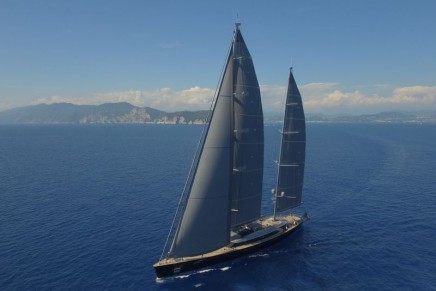
Privacy Overview

Try now - Live tracking map for yachts and other vessels
Real time world map for tracking yachts and all other vessels like speed boats, cargo or tankers! Tracking yachts and other vessels was never so easy!
Bill Duker Luxury Yacht – Sybaris
Luxury Sailing Yacht Sybaris is a 70 m / 229′8″ sailing vessel. She was built by Perini Navi in 2016.
With a beam of 13.24 m and a draft of 4.54 m, she has an aluminium hull and aluminium superstructure. She is powered by MTU engines of 1930 hp each. The sailing yacht can accommodate guests in cabins and an exterior design by Philippe Briand.
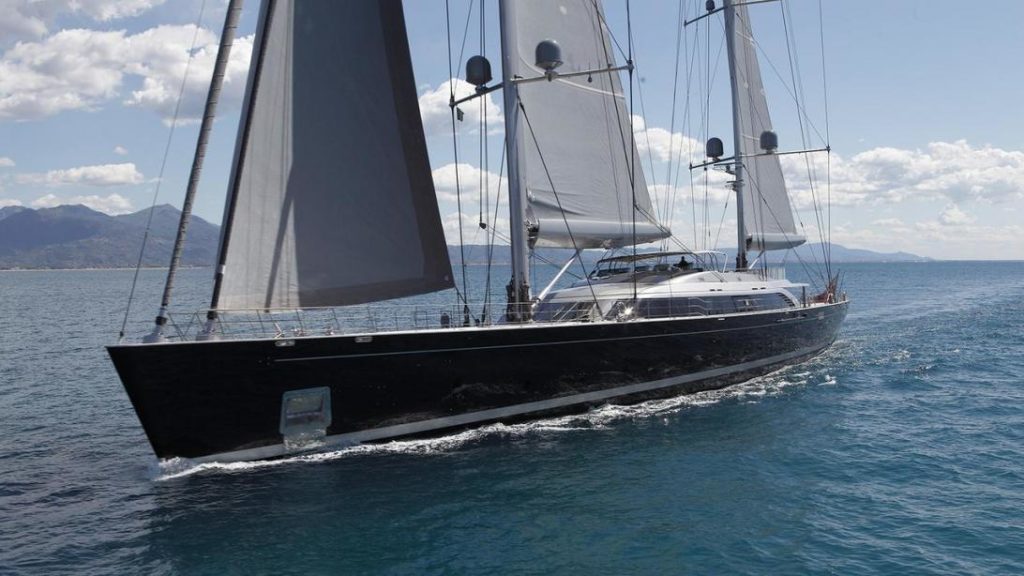
Commissioned for serial yacht owner Bill Duker, Sybaris is one of the largest yachts built by Italian yard Perini Navi to date, second only to the 88 metre Maltese Falcon.

Luxury Sailing Yacht Sybaris Awards
Monaco Yacht Show 2016 – Best Interior
Show Boats Design Awards Best Interior Layout & Design
Show Boats Design Awards Best Lighting Design
Show Boats Design Awards Newcomer of the Year PH Design
Her carbon-fiber rig includes two masts, which measure 72 and 62 metre’s respectively. Naval architecture, exterior design and sail plan optimization are all by Philippe Briand, while her interiors were styled by PH Design. Accommodation is for 12 guests, split across six cabins, and her total interior volume of 870 gross tonne’s also allows for a crew of up to 11.

Luxury Sailing Yacht Sybaris Interior
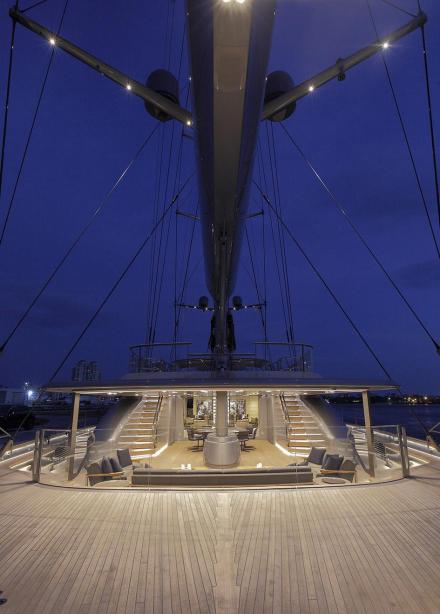
The subtle nature of Sybaris, even with her imposing 72 and 61 metre main and mizzen masts, is astounding. The performance under sail has the makings of a cutting-edge classic, and the resounding core of her creation is to house art, while becoming a masterpiece herself.
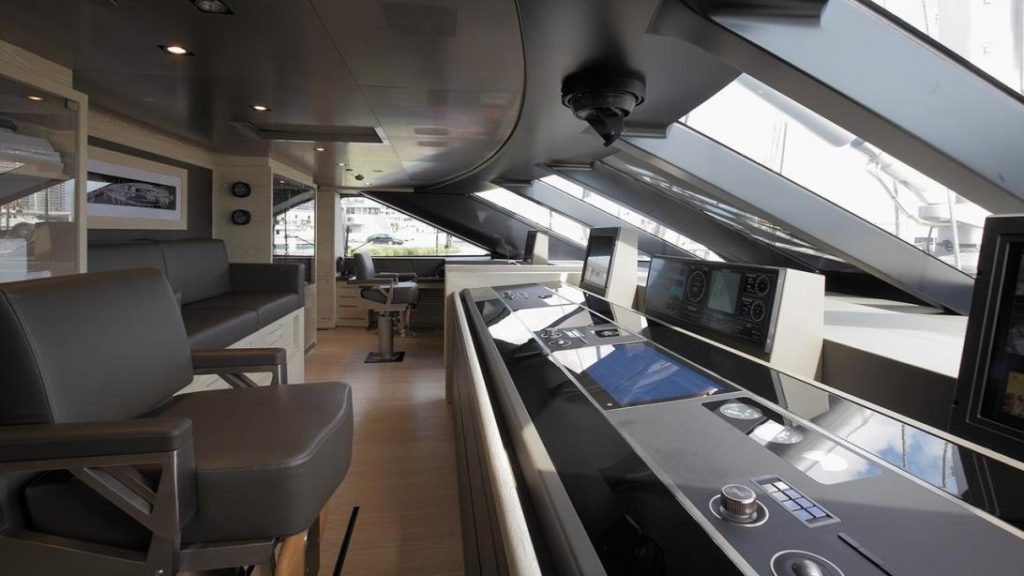
See page 2 for more
Related images:, share this with your friends:.
- Yacht Tracking Map Find mega yacht
- Fun Map Map The World
- Privacy Policy
- The A.V. Club
- The Takeout
- The Inventory
Rich Guy Yachts Just Keep Getting Longer
“if the rest of the world learns what it’s like to live on a yacht like this, they’re gonna bring back the guillotine,” american yachtsman bill duker said..
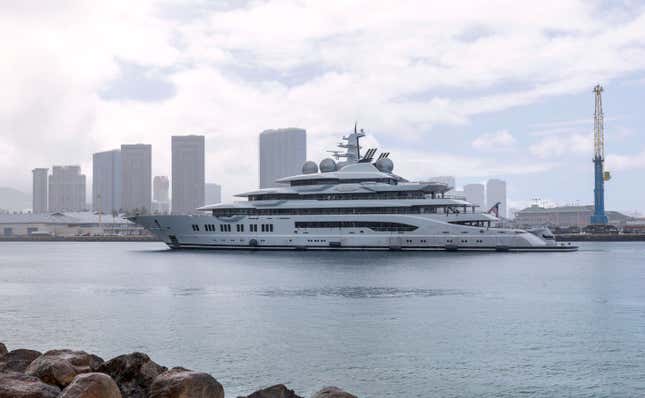
In case you need an even stronger indication that normal people are being taken for a ride in late-stage capitalism: historic inflation is being accompanied by a worldwide boom in the number of billionaires. All these new members of the ultra wealthy are buying super, mega and “giga” yachts to set them apart from land-based poors.
There are so many deeply incredible and infuriating pieces of information from this New Yorker story about the world of private yachts that I’m going to encourage you to spend time reading the whole in-depth piece. Here’s a few bits that caught my eye, like describing a different kind of embarrassment of riches: having too small a yacht.
A big ship is a floating manse, with a hierarchy written right into the nomenclature. If it has a crew working aboard, it’s a yacht. If it’s more than ninety-eight feet, it’s a superyacht. After that, definitions are debated, but people generally agree that anything more than two hundred and thirty feet is a megayacht, and more than two hundred and ninety-five is a gigayacht. The world contains about fifty-four hundred superyachts, and about a hundred gigayachts. For the moment, a gigayacht is the most expensive item that our species has figured out how to own. In 2019, the hedge-fund billionaire Ken Griffin bought a quadruplex on Central Park South for two hundred and forty million dollars, the highest price ever paid for a home in America. In May, an unknown buyer spent about a hundred and ninety-five million on an Andy Warhol silk-screen portrait of Marilyn Monroe. In luxury-yacht terms, those are ordinary numbers. “There are a lot of boats in build well over two hundred and fifty million dollars,” Jamie Edmiston, a broker in Monaco and London, told me. His buyers are getting younger and more inclined to spend long stretches at sea. “High-speed Internet, telephony, modern communications have made working easier,” he said. “Plus, people made a lot more money earlier in life.” A Silicon Valley C.E.O. told me that one appeal of boats is that they can “absorb the most excess capital.” He explained, “Rationally, it would seem to make sense for people to spend half a billion dollars on their house and then fifty million on the boat that they’re on for two weeks a year, right? But it’s gone the other way. People don’t want to live in a hundred-thousand-square-foot house. Optically, it’s weird. But a half-billion-dollar boat, actually, is quite nice.” Staluppi, of Palm Beach Gardens, is content to spend three or four times as much on his yachts as on his homes. Part of the appeal is flexibility. “If you’re on your boat and you don’t like your neighbor, you tell the captain, ‘Let’s go to a different place,’ ” he said. On land, escaping a bad neighbor requires more work: “You got to try and buy him out or make it uncomfortable or something.” The preference for sea-based investment has altered the proportions of taste. Until recently, the Silicon Valley C.E.O. said, “a fifty-metre boat was considered a good-sized boat. Now that would be a little bit embarrassing.” In the past twenty years, the length of the average luxury yacht has grown by a third, to a hundred and sixty feet.
Or this portion, describing the amount of both pollution and wealthy self-awareness generated by these giants:
Even before Russia’s invasion of Ukraine, the yachting community was straining to manage its reputation as a gusher of carbon emissions (one well-stocked diesel yacht is estimated to produce as much greenhouse gas as fifteen hundred passenger cars), not to mention the fact that the world of white boats is overwhelmingly white. In a candid aside to a French documentarian, the American yachtsman Bill Duker said, “If the rest of the world learns what it’s like to live on a yacht like this, they’re gonna bring back the guillotine.”
But what these big-ass boats really represent to their ultra-wealthy owners is the largest waste of money possible, or as Silicone Valley CEO put it, ““absorb the most excess capital.”
The latest fashions include imax theatres, hospital equipment that tests for dozens of pathogens, and ski rooms where guests can suit up for a helicopter trip to a mountaintop. The longtime owner, who had returned the previous day from his yacht, told me, “No one today—except for assholes and ridiculous people—lives on land in what you would call a deep and broad luxe life. Yes, people have nice houses and all of that, but it’s unlikely that the ratio of staff to them is what it is on a boat.” After a moment, he added, “Boats are the last place that I think you can get away with it.” Even among the truly rich, there is a gap between the haves and the have-yachts. One boating guest told me about a conversation with a famous friend who keeps one of the world’s largest yachts. “He said, ‘The boat is the last vestige of what real wealth can do.’ What he meant is, You have a chef, and I have a chef. You have a driver, and I have a driver. You can fly privately, and I fly privately. So, the one place where I can make clear to the world that I am in a different fucking category than you is the boat.”
Check out the whole story to see how the other side lives. It might motivate you to sharpen up the old guillotine blades while you’re at it.
Find anything you save across the site in your account
The Haves and the Have-Yachts
By Evan Osnos
In the Victorian era, it was said that the length of a man’s boat, in feet, should match his age, in years. The Victorians would have had some questions at the fortieth annual Palm Beach International Boat Show, which convened this March on Florida’s Gold Coast. A typical offering: a two-hundred-and-three-foot superyacht named Sea Owl, selling secondhand for ninety million dollars. The owner, Robert Mercer, the hedge-fund tycoon and Republican donor, was throwing in furniture and accessories, including several auxiliary boats, a Steinway piano, a variety of frescoes, and a security system that requires fingerprint recognition. Nevertheless, Mercer’s package was a modest one; the largest superyachts are more than five hundred feet, on a scale with naval destroyers, and cost six or seven times what he was asking.
For the small, tight-lipped community around the world’s biggest yachts, the Palm Beach show has the promising air of spring training. On the cusp of the summer season, it affords brokers and builders and owners (or attendants from their family offices) a chance to huddle over the latest merchandise and to gather intelligence: Who’s getting in? Who’s getting out? And, most pressingly, who’s ogling a bigger boat?
On the docks, brokers parse the crowd according to a taxonomy of potential. Guests asking for tours face a gantlet of greeters, trained to distinguish “superrich clients” from “ineligible visitors,” in the words of Emma Spence, a former greeter at the Palm Beach show. Spence looked for promising clues (the right shoes, jewelry, pets) as well as for red flags (cameras, ornate business cards, clothes with pop-culture references). For greeters from elsewhere, Palm Beach is a challenging assignment. Unlike in Europe, where money can still produce some visible tells—Hunter Wellies, a Barbour jacket—the habits of wealth in Florida offer little that’s reliable. One colleague resorted to binoculars, to spot a passerby with a hundred-thousand-dollar watch. According to Spence, people judged to have insufficient buying power are quietly marked for “dissuasion.”
For the uninitiated, a pleasure boat the length of a football field can be bewildering. Andy Cohen, the talk-show host, recalled his first visit to a superyacht owned by the media mogul Barry Diller: “I was like the Beverly Hillbillies.” The boats have grown so vast that some owners place unique works of art outside the elevator on each deck, so that lost guests don’t barge into the wrong stateroom.
At the Palm Beach show, I lingered in front of a gracious vessel called Namasté, until I was dissuaded by a wooden placard: “Private yacht, no boarding, no paparazzi.” In a nearby berth was a two-hundred-and-eighty-foot superyacht called Bold, which was styled like a warship, with its own helicopter hangar, three Sea-Doos, two sailboats, and a color scheme of gunmetal gray. The rugged look is a trend; “explorer” vessels, equipped to handle remote journeys, are the sport-utility vehicles of yachting.
If you hail from the realm of ineligible visitors, you may not be aware that we are living through the “greatest boom in the yacht business that’s ever existed,” as Bob Denison—whose firm, Denison Yachting, is one of the world’s largest brokers—told me. “Every broker, every builder, up and down the docks, is having some of the best years they’ve ever experienced.” In 2021, the industry sold a record eight hundred and eighty-seven superyachts worldwide, nearly twice the previous year’s total. With more than a thousand new superyachts on order, shipyards are so backed up that clients unaccustomed to being told no have been shunted to waiting lists.
One reason for the increased demand for yachts is the pandemic. Some buyers invoke social distancing; others, an existential awakening. John Staluppi, of Palm Beach Gardens, who made a fortune from car dealerships, is looking to upgrade from his current, sixty-million-dollar yacht. “When you’re forty or fifty years old, you say, ‘I’ve got plenty of time,’ ” he told me. But, at seventy-five, he is ready to throw in an extra fifteen million if it will spare him three years of waiting. “Is your life worth five million dollars a year? I think so,” he said. A deeper reason for the demand is the widening imbalance of wealth. Since 1990, the United States’ supply of billionaires has increased from sixty-six to more than seven hundred, even as the median hourly wage has risen only twenty per cent. In that time, the number of truly giant yachts—those longer than two hundred and fifty feet—has climbed from less than ten to more than a hundred and seventy. Raphael Sauleau, the C.E.O. of Fraser Yachts, told me bluntly, “ COVID and wealth—a perfect storm for us.”
And yet the marina in Palm Beach was thrumming with anxiety. Ever since the Russian President, Vladimir Putin, launched his assault on Ukraine, the superyacht world has come under scrutiny. At a port in Spain, a Ukrainian engineer named Taras Ostapchuk, working aboard a ship that he said was owned by a Russian arms dealer, threw open the sea valves and tried to sink it to the bottom of the harbor. Under arrest, he told a judge, “I would do it again.” Then he returned to Ukraine and joined the military. Western allies, in the hope of pressuring Putin to withdraw, have sought to cut off Russian oligarchs from businesses and luxuries abroad. “We are coming for your ill-begotten gains,” President Joe Biden declared, in his State of the Union address.
Nobody can say precisely how many of Putin’s associates own superyachts—known to professionals as “white boats”—because the white-boat world is notoriously opaque. Owners tend to hide behind shell companies, registered in obscure tax havens, attended by private bankers and lawyers. But, with unusual alacrity, authorities have used subpoenas and police powers to freeze boats suspected of having links to the Russian élite. In Spain, the government detained a hundred-and-fifty-million-dollar yacht associated with Sergei Chemezov, the head of the conglomerate Rostec, whose bond with Putin reaches back to their time as K.G.B. officers in East Germany. (As in many cases, the boat is not registered to Chemezov; the official owner is a shell company connected to his stepdaughter, a teacher whose salary is likely about twenty-two hundred dollars a month.) In Germany, authorities impounded the world’s most voluminous yacht, Dilbar, for its ties to the mining-and-telecom tycoon Alisher Usmanov. And in Italy police have grabbed a veritable armada, including a boat owned by one of Russia’s richest men, Alexei Mordashov, and a colossus suspected of belonging to Putin himself, the four-hundred-and-fifty-nine-foot Scheherazade.
In Palm Beach, the yachting community worried that the same scrutiny might be applied to them. “Say your superyacht is in Asia, and there’s some big conflict where China invades Taiwan,” Denison told me. “China could spin it as ‘Look at these American oligarchs!’ ” He wondered if the seizures of superyachts marked a growing political animus toward the very rich. “Whenever things are economically or politically disruptive,” he said, “it’s hard to justify taking an insane amount of money and just putting it into something that costs a lot to maintain, depreciates, and is only used for having a good time.”
Nobody pretends that a superyacht is a productive place to stash your wealth. In a column this spring headlined “ A SUPERYACHT IS A TERRIBLE ASSET ,” the Financial Times observed, “Owning a superyacht is like owning a stack of 10 Van Goghs, only you are holding them over your head as you tread water, trying to keep them dry.”
Not so long ago, status transactions among the élite were denominated in Old Masters and in the sculptures of the Italian Renaissance. Joseph Duveen, the dominant art dealer of the early twentieth century, kept the oligarchs of his day—Andrew Mellon, Jules Bache, J. P. Morgan—jockeying over Donatellos and Van Dycks. “When you pay high for the priceless,” he liked to say, “you’re getting it cheap.”

Link copied
In the nineteen-fifties, the height of aspirational style was fine French furniture—F.F.F., as it became known in certain precincts of Fifth Avenue and Palm Beach. Before long, more and more money was going airborne. Hugh Hefner, a pioneer in the private-jet era, decked out a plane he called Big Bunny, where he entertained Elvis Presley, Raquel Welch, and James Caan. The oil baron Armand Hammer circled the globe on his Boeing 727, paying bribes and recording evidence on microphones hidden in his cufflinks. But, once it seemed that every plutocrat had a plane, the thrill was gone.
In any case, an airplane is just transportation. A big ship is a floating manse, with a hierarchy written right into the nomenclature. If it has a crew working aboard, it’s a yacht. If it’s more than ninety-eight feet, it’s a superyacht. After that, definitions are debated, but people generally agree that anything more than two hundred and thirty feet is a megayacht, and more than two hundred and ninety-five is a gigayacht. The world contains about fifty-four hundred superyachts, and about a hundred gigayachts.
For the moment, a gigayacht is the most expensive item that our species has figured out how to own. In 2019, the hedge-fund billionaire Ken Griffin bought a quadruplex on Central Park South for two hundred and forty million dollars, the highest price ever paid for a home in America. In May, an unknown buyer spent about a hundred and ninety-five million on an Andy Warhol silk-screen portrait of Marilyn Monroe. In luxury-yacht terms, those are ordinary numbers. “There are a lot of boats in build well over two hundred and fifty million dollars,” Jamie Edmiston, a broker in Monaco and London, told me. His buyers are getting younger and more inclined to spend long stretches at sea. “High-speed Internet, telephony, modern communications have made working easier,” he said. “Plus, people made a lot more money earlier in life.”
A Silicon Valley C.E.O. told me that one appeal of boats is that they can “absorb the most excess capital.” He explained, “Rationally, it would seem to make sense for people to spend half a billion dollars on their house and then fifty million on the boat that they’re on for two weeks a year, right? But it’s gone the other way. People don’t want to live in a hundred-thousand-square-foot house. Optically, it’s weird. But a half-billion-dollar boat, actually, is quite nice.” Staluppi, of Palm Beach Gardens, is content to spend three or four times as much on his yachts as on his homes. Part of the appeal is flexibility. “If you’re on your boat and you don’t like your neighbor, you tell the captain, ‘Let’s go to a different place,’ ” he said. On land, escaping a bad neighbor requires more work: “You got to try and buy him out or make it uncomfortable or something.” The preference for sea-based investment has altered the proportions of taste. Until recently, the Silicon Valley C.E.O. said, “a fifty-metre boat was considered a good-sized boat. Now that would be a little bit embarrassing.” In the past twenty years, the length of the average luxury yacht has grown by a third, to a hundred and sixty feet.
Thorstein Veblen, the economist who published “The Theory of the Leisure Class,” in 1899, argued that the power of “conspicuous consumption” sprang not from artful finery but from sheer needlessness. “In order to be reputable,” he wrote, “it must be wasteful.” In the yachting world, stories circulate about exotic deliveries by helicopter or seaplane: Dom Pérignon, bagels from Zabar’s, sex workers, a rare melon from the island of Hokkaido. The industry excels at selling you things that you didn’t know you needed. When you flip through the yachting press, it’s easy to wonder how you’ve gone this long without a personal submarine, or a cryosauna that “blasts you with cold” down to minus one hundred and ten degrees Celsius, or the full menagerie of “exclusive leathers,” such as eel and stingray.
But these shrines to excess capital exist in a conditional state of visibility: they are meant to be unmistakable to a slender stratum of society—and all but unseen by everyone else. Even before Russia’s invasion of Ukraine, the yachting community was straining to manage its reputation as a gusher of carbon emissions (one well-stocked diesel yacht is estimated to produce as much greenhouse gas as fifteen hundred passenger cars), not to mention the fact that the world of white boats is overwhelmingly white. In a candid aside to a French documentarian, the American yachtsman Bill Duker said, “If the rest of the world learns what it’s like to live on a yacht like this, they’re gonna bring back the guillotine.” The Dutch press recently reported that Jeff Bezos, the founder of Amazon, was building a sailing yacht so tall that the city of Rotterdam might temporarily dismantle a bridge that had survived the Nazis in order to let the boat pass to the open sea. Rotterdammers were not pleased. On Facebook, a local man urged people to “take a box of rotten eggs with you and let’s throw them en masse at Jeff’s superyacht when it sails through.” At least thirteen thousand people expressed interest. Amid the uproar, a deputy mayor announced that the dismantling plan had been abandoned “for the time being.” (Bezos modelled his yacht partly on one owned by his friend Barry Diller, who has hosted him many times. The appreciation eventually extended to personnel, and Bezos hired one of Diller’s captains.)
As social media has heightened the scrutiny of extraordinary wealth, some of the very people who created those platforms have sought less observable places to spend it. But they occasionally indulge in some coded provocation. In 2006, when the venture capitalist Tom Perkins unveiled his boat in Istanbul, most passersby saw it adorned in colorful flags, but people who could read semaphore were able to make out a message: “Rarely does one have the privilege to witness vulgar ostentation displayed on such a scale.” As a longtime owner told me, “If you don’t have some guilt about it, you’re a rat.”
Alex Finley, a former C.I.A. officer who has seen yachts proliferate near her home in Barcelona, has weighed the superyacht era and its discontents in writings and on Twitter, using the hashtag #YachtWatch. “To me, the yachts are not just yachts,” she told me. “In Russia’s case, these are the embodiment of oligarchs helping a dictator destabilize our democracy while utilizing our democracy to their benefit.” But, Finley added, it’s a mistake to think the toxic symbolism applies only to Russia. “The yachts tell a whole story about a Faustian capitalism—this idea that we’re ready to sell democracy for short-term profit,” she said. “They’re registered offshore. They use every loophole that we’ve put in place for illicit money and tax havens. So they play a role in this battle, writ large, between autocracy and democracy.”
After a morning on the docks at the Palm Beach show, I headed to a more secluded marina nearby, which had been set aside for what an attendant called “the really big hardware.” It felt less like a trade show than like a boutique resort, with a swimming pool and a terrace restaurant. Kevin Merrigan, a relaxed Californian with horn-rimmed glasses and a high forehead pinked by the sun, was waiting for me at the stern of Unbridled, a superyacht with a brilliant blue hull that gave it the feel of a personal cruise ship. He invited me to the bridge deck, where a giant screen showed silent video of dolphins at play.
Merrigan is the chairman of the brokerage Northrop & Johnson, which has ridden the tide of growing boats and wealth since 1949. Lounging on a sofa mounded with throw pillows, he projected a nearly postcoital level of contentment. He had recently sold the boat we were on, accepted an offer for a behemoth beside us, and begun negotiating the sale of yet another. “This client owns three big yachts,” he said. “It’s a hobby for him. We’re at a hundred and ninety-one feet now, and last night he said, ‘You know, what do you think about getting a two hundred and fifty?’ ” Merrigan laughed. “And I was, like, ‘Can’t you just have dinner?’ ”
Among yacht owners, there are some unwritten rules of stratification: a Dutch-built boat will hold its value better than an Italian; a custom design will likely get more respect than a “series yacht”; and, if you want to disparage another man’s boat, say that it looks like a wedding cake. But, in the end, nothing says as much about a yacht, or its owner, as the delicate matter of L.O.A.—length over all.
The imperative is not usually length for length’s sake (though the longtime owner told me that at times there is an aspect of “phallic sizing”). “L.O.A.” is a byword for grandeur. In most cases, pleasure yachts are permitted to carry no more than twelve passengers, a rule set by the International Convention for the Safety of Life at Sea, which was conceived after the sinking of the Titanic. But those limits do not apply to crew. “So, you might have anything between twelve and fifty crew looking after those twelve guests,” Edmiston, the broker, said. “It’s a level of service you cannot really contemplate until you’ve been fortunate enough to experience it.”
As yachts have grown more capacious, and the limits on passengers have not, more and more space on board has been devoted to staff and to novelties. The latest fashions include IMAX theatres, hospital equipment that tests for dozens of pathogens, and ski rooms where guests can suit up for a helicopter trip to a mountaintop. The longtime owner, who had returned the previous day from his yacht, told me, “No one today—except for assholes and ridiculous people—lives on land in what you would call a deep and broad luxe life. Yes, people have nice houses and all of that, but it’s unlikely that the ratio of staff to them is what it is on a boat.” After a moment, he added, “Boats are the last place that I think you can get away with it.”
Even among the truly rich, there is a gap between the haves and the have-yachts. One boating guest told me about a conversation with a famous friend who keeps one of the world’s largest yachts. “He said, ‘The boat is the last vestige of what real wealth can do.’ What he meant is, You have a chef, and I have a chef. You have a driver, and I have a driver. You can fly privately, and I fly privately. So, the one place where I can make clear to the world that I am in a different fucking category than you is the boat.”
After Merrigan and I took a tour of Unbridled, he led me out to a waiting tender, staffed by a crew member with an earpiece on a coil. The tender, Merrigan said, would ferry me back to the busy main dock of the Palm Beach show. We bounced across the waves under a pristine sky, and pulled into the marina, where my fellow-gawkers were still trying to talk their way past the greeters. As I walked back into the scrum, Namasté was still there, but it looked smaller than I remembered.
For owners and their guests, a white boat provides a discreet marketplace for the exchange of trust, patronage, and validation. To diagram the precise workings of that trade—the customs and anxieties, strategies and slights—I talked to Brendan O’Shannassy, a veteran captain who is a curator of white-boat lore. Raised in Western Australia, O’Shannassy joined the Navy as a young man, and eventually found his way to skippering some of the world’s biggest yachts. He has worked for Paul Allen, the late co-founder of Microsoft, along with a few other billionaires he declines to name. Now in his early fifties, with patient green eyes and tufts of curly brown hair, O’Shannassy has had a vantage from which to monitor the social traffic. “It’s all gracious, and everyone’s kiss-kiss,” he said. “But there’s a lot going on in the background.”
O’Shannassy once worked for an owner who limited the number of newspapers on board, so that he could watch his guests wait and squirm. “It was a mind game amongst the billionaires. There were six couples, and three newspapers,” he said, adding, “They were ranking themselves constantly.” On some boats, O’Shannassy has found himself playing host in the awkward minutes after guests arrive. “A lot of them are savants, but some are very un-socially aware,” he said. “They need someone to be social and charming for them.” Once everyone settles in, O’Shannassy has learned, there is often a subtle shift, when a mogul or a politician or a pop star starts to loosen up in ways that are rarely possible on land. “Your security is relaxed—they’re not on your hip,” he said. “You’re not worried about paparazzi. So you’ve got all this extra space, both mental and physical.”
O’Shannassy has come to see big boats as a space where powerful “solar systems” converge and combine. “It is implicit in every interaction that their sharing of information will benefit both parties; it is an obsession with billionaires to do favours for each other. A referral, an introduction, an insight—it all matters,” he wrote in “Superyacht Captain,” a new memoir. A guest told O’Shannassy that, after a lavish display of hospitality, he finally understood the business case for buying a boat. “One deal secured on board will pay it all back many times over,” the guest said, “and it is pretty hard to say no after your kids have been hosted so well for a week.”
Take the case of David Geffen, the former music and film executive. He is long retired, but he hosts friends (and potential friends) on the four-hundred-and-fifty-four-foot Rising Sun, which has a double-height cinema, a spa and salon, and a staff of fifty-seven. In 2017, shortly after Barack and Michelle Obama departed the White House, they were photographed on Geffen’s boat in French Polynesia, accompanied by Bruce Springsteen, Oprah Winfrey, Tom Hanks, and Rita Wilson. For Geffen, the boat keeps him connected to the upper echelons of power. There are wealthier Americans, but not many of them have a boat so delectable that it can induce both a Democratic President and the workingman’s crooner to risk the aroma of hypocrisy.
The binding effect pays dividends for guests, too. Once people reach a certain level of fame, they tend to conclude that its greatest advantage is access. Spend a week at sea together, lingering over meals, observing one another floundering on a paddleboard, and you have something of value for years to come. Call to ask for an investment, an introduction, an internship for a wayward nephew, and you’ll at least get the call returned. It’s a mutually reinforcing circle of validation: she’s here, I’m here, we’re here.
But, if you want to get invited back, you are wise to remember your part of the bargain. If you work with movie stars, bring fresh gossip. If you’re on Wall Street, bring an insight or two. Don’t make the transaction obvious, but don’t forget why you’re there. “When I see the guest list,” O’Shannassy wrote, “I am aware, even if not all names are familiar, that all have been chosen for a purpose.”
For O’Shannassy, there is something comforting about the status anxieties of people who have everything. He recalled a visit to the Italian island of Sardinia, where his employer asked him for a tour of the boats nearby. Riding together on a tender, they passed one colossus after another, some twice the size of the owner’s superyacht. Eventually, the man cut the excursion short. “Take me back to my yacht, please,” he said. They motored in silence for a while. “There was a time when my yacht was the most beautiful in the bay,” he said at last. “How do I keep up with this new money?”
The summer season in the Mediterranean cranks up in May, when the really big hardware heads east from Florida and the Caribbean to escape the coming hurricanes, and reconvenes along the coasts of France, Italy, and Spain. At the center is the Principality of Monaco, the sun-washed tax haven that calls itself the “world’s capital of advanced yachting.” In Monaco, which is among the richest countries on earth, superyachts bob in the marina like bath toys.

The nearest hotel room at a price that would not get me fired was an Airbnb over the border with France. But an acquaintance put me on the phone with the Yacht Club de Monaco, a members-only establishment created by the late monarch His Serene Highness Prince Rainier III, whom the Web site describes as “a true visionary in every respect.” The club occasionally rents rooms—“cabins,” as they’re called—to visitors in town on yacht-related matters. Claudia Batthyany, the elegant director of special projects, showed me to my cabin and later explained that the club does not aspire to be a hotel. “We are an association ,” she said. “Otherwise, it becomes”—she gave a gentle wince—“not that exclusive.”
Inside my cabin, I quickly came to understand that I would never be fully satisfied anywhere else again. The space was silent and aromatically upscale, bathed in soft sunlight that swept through a wall of glass overlooking the water. If I was getting a sudden rush of the onboard experience, that was no accident. The clubhouse was designed by the British architect Lord Norman Foster to evoke the opulent indulgence of ocean liners of the interwar years, like the Queen Mary. I found a handwritten welcome note, on embossed club stationery, set alongside an orchid and an assemblage of chocolate truffles: “The whole team remains at your entire disposal to make your stay a wonderful experience. Yours sincerely, Service Members.” I saluted the nameless Service Members, toiling for the comfort of their guests. Looking out at the water, I thought, intrusively, of a line from Santiago, Hemingway’s old man of the sea. “Do not think about sin,” he told himself. “It is much too late for that and there are people who are paid to do it.”
I had been assured that the Service Members would cheerfully bring dinner, as they might on board, but I was eager to see more of my surroundings. I consulted the club’s summer dress code. It called for white trousers and a blue blazer, and it discouraged improvisation: “No pocket handkerchief is to be worn above the top breast-pocket bearing the Club’s coat of arms.” The handkerchief rule seemed navigable, but I did not possess white trousers, so I skirted the lobby and took refuge in the bar. At a table behind me, a man with flushed cheeks and a British accent had a head start. “You’re a shitty negotiator,” he told another man, with a laugh. “Maybe sales is not your game.” A few seats away, an American woman was explaining to a foreign friend how to talk with conservatives: “If they say, ‘The earth is flat,’ you say, ‘Well, I’ve sailed around it, so I’m not so sure about that.’ ”
In the morning, I had an appointment for coffee with Gaëlle Tallarida, the managing director of the Monaco Yacht Show, which the Daily Mail has called the “most shamelessly ostentatious display of yachts in the world.” Tallarida was not born to that milieu; she grew up on the French side of the border, swimming at public beaches with a view of boats sailing from the marina. But she had a knack for highly organized spectacle. While getting a business degree, she worked on a student theatre festival and found it thrilling. Afterward, she got a job in corporate events, and in 1998 she was hired at the yacht show as a trainee.
With this year’s show five months off, Tallarida was already getting calls about what she described as “the most complex part of my work”: deciding which owners get the most desirable spots in the marina. “As you can imagine, they’ve got very big egos,” she said. “On top of that, I’m a woman. They are sometimes arriving and saying”—she pointed into the distance, pantomiming a decree—“ ‘O.K., I want that! ’ ”
Just about everyone wants his superyacht to be viewed from the side, so that its full splendor is visible. Most harbors, however, have a limited number of berths with a side view; in Monaco, there are only twelve, with prime spots arrayed along a concrete dike across from the club. “We reserve the dike for the biggest yachts,” Tallarida said. But try telling that to a man who blew his fortune on a small superyacht.
Whenever possible, Tallarida presents her verdicts as a matter of safety: the layout must insure that “in case of an emergency, any boat can go out.” If owners insist on preferential placement, she encourages a yachting version of the Golden Rule: “What if, next year, I do that to you? Against you?”
Does that work? I asked. She shrugged. “They say, ‘Eh.’ ” Some would gladly risk being a victim next year in order to be a victor now. In the most awful moment of her career, she said, a man who was unhappy with his berth berated her face to face. “I was in the office, feeling like a little girl, with my daddy shouting at me. I said, ‘O.K., O.K., I’m going to give you the spot.’ ”
Securing just the right place, it must be said, carries value. Back at the yacht club, I was on my terrace, enjoying the latest delivery by the Service Members—an airy French omelette and a glass of preternaturally fresh orange juice. I thought guiltily of my wife, at home with our kids, who had sent a text overnight alerting me to a maintenance issue that she described as “a toilet debacle.”
Then I was distracted by the sight of a man on a yacht in the marina below. He was staring up at me. I went back to my brunch, but, when I looked again, there he was—a middle-aged man, on a mid-tier yacht, juiceless, on a greige banquette, staring up at my perfect terrace. A surprising sensation started in my chest and moved outward like a warm glow: the unmistakable pang of superiority.
That afternoon, I made my way to the bar, to meet the yacht club’s general secretary, Bernard d’Alessandri, for a history lesson. The general secretary was up to code: white trousers, blue blazer, club crest over the heart. He has silver hair, black eyebrows, and a tan that evokes high-end leather. “I was a sailing teacher before this,” he said, and gestured toward the marina. “It was not like this. It was a village.”
Before there were yacht clubs, there were jachten , from the Dutch word for “hunt.” In the seventeenth century, wealthy residents of Amsterdam created fast-moving boats to meet incoming cargo ships before they hit port, in order to check out the merchandise. Soon, the Dutch owners were racing one another, and yachting spread across Europe. After a visit to Holland in 1697, Peter the Great returned to Russia with a zeal for pleasure craft, and he later opened Nevsky Flot, one of the world’s first yacht clubs, in St. Petersburg.
For a while, many of the biggest yachts were symbols of state power. In 1863, the viceroy of Egypt, Isma’il Pasha, ordered up a steel leviathan called El Mahrousa, which was the world’s longest yacht for a remarkable hundred and nineteen years, until the title was claimed by King Fahd of Saudi Arabia. In the United States, Franklin Delano Roosevelt received guests aboard the U.S.S. Potomac, which had a false smokestack containing a hidden elevator, so that the President could move by wheelchair between decks.
But yachts were finding new patrons outside politics. In 1954, the Greek shipping baron Aristotle Onassis bought a Canadian Navy frigate and spent four million dollars turning it into Christina O, which served as his home for months on end—and, at various times, as a home to his companions Maria Callas, Greta Garbo, and Jacqueline Kennedy. Christina O had its flourishes—a Renoir in the master suite, a swimming pool with a mosaic bottom that rose to become a dance floor—but none were more distinctive than the appointments in the bar, which included whales’ teeth carved into pornographic scenes from the Odyssey and stools upholstered in whale foreskins.
For Onassis, the extraordinary investments in Christina O were part of an epic tit for tat with his archrival, Stavros Niarchos, a fellow shipping tycoon, which was so entrenched that it continued even after Onassis’s death, in 1975. Six years later, Niarchos launched a yacht fifty-five feet longer than Christina O: Atlantis II, which featured a swimming pool on a gyroscope so that the water would not slosh in heavy seas. Atlantis II, now moored in Monaco, sat before the general secretary and me as we talked.
Over the years, d’Alessandri had watched waves of new buyers arrive from one industry after another. “First, it was the oil. After, it was the telecommunications. Now, they are making money with crypto,” he said. “And, each time, it’s another size of the boat, another design.” What began as symbols of state power had come to represent more diffuse aristocracies—the fortunes built on carbon, capital, and data that migrated across borders. As early as 1908, the English writer G. K. Chesterton wondered what the big boats foretold of a nation’s fabric. “The poor man really has a stake in the country,” he wrote. “The rich man hasn’t; he can go away to New Guinea in a yacht.”
Each iteration of fortune left its imprint on the industry. Sheikhs, who tend to cruise in the world’s hottest places, wanted baroque indoor spaces and were uninterested in sundecks. Silicon Valley favored acres of beige, more Sonoma than Saudi. And buyers from Eastern Europe became so abundant that shipyards perfected the onboard banya , a traditional Russian sauna stocked with birch and eucalyptus. The collapse of the Soviet Union, in 1991, had minted a generation of new billionaires, whose approach to money inspired a popular Russian joke: One oligarch brags to another, “Look at this new tie. It cost me two hundred bucks!” To which the other replies, “You moron. You could’ve bought the same one for a thousand!”
In 1998, around the time that the Russian economy imploded, the young tycoon Roman Abramovich reportedly bought a secondhand yacht called Sussurro—Italian for “whisper”—which had been so carefully engineered for speed that each individual screw was weighed before installation. Soon, Russians were competing to own the costliest ships. “If the most expensive yacht in the world was small, they would still want it,” Maria Pevchikh, a Russian investigator who helps lead the Anti-Corruption Foundation, told me.
In 2008, a thirty-six-year-old industrialist named Andrey Melnichenko spent some three hundred million dollars on Motor Yacht A, a radical experiment conceived by the French designer Philippe Starck, with a dagger-shaped hull and a bulbous tower topped by a master bedroom set on a turntable that pivots to capture the best view. The shape was ridiculed as “a giant finger pointing at you” and “one of the most hideous vessels ever to sail,” but it marked a new prominence for Russian money at sea. Today, post-Soviet élites are thought to own a fifth of the world’s gigayachts.
Even Putin has signalled his appreciation, being photographed on yachts in the Black Sea resort of Sochi. In an explosive report in 2012, Boris Nemtsov, a former Deputy Prime Minister, accused Putin of amassing a storehouse of outrageous luxuries, including four yachts, twenty homes, and dozens of private aircraft. Less than three years later, Nemtsov was fatally shot while crossing a bridge near the Kremlin. The Russian government, which officially reports that Putin collects a salary of about a hundred and forty thousand dollars and possesses a modest apartment in Moscow, denied any involvement.
Many of the largest, most flamboyant gigayachts are designed in Monaco, at a sleek waterfront studio occupied by the naval architect Espen Øino. At sixty, Øino has a boyish mop and the mild countenance of a country parson. He grew up in a small town in Norway, the heir to a humble maritime tradition. “My forefathers built wooden rowing boats for four generations,” he told me. In the late eighties, he was designing sailboats when his firm won a commission to design a megayacht for Emilio Azcárraga, the autocratic Mexican who built Televisa into the world’s largest Spanish-language broadcaster. Azcárraga was nicknamed El Tigre, for his streak of white hair and his comfort with confrontation; he kept a chair in his office that was unusually high off the ground, so that visitors’ feet dangled like children’s.
In early meetings, Øino recalled, Azcárraga grew frustrated that the ideas were not dazzling enough. “You must understand,” he said. “I don’t go to port very often with my boats, but, when I do, I want my presence to be felt.”
The final design was suitably arresting; after the boat was completed, Øino had no shortage of commissions. In 1998, he was approached by Paul Allen, of Microsoft, to build a yacht that opened the way for the Goliaths that followed. The result, called Octopus, was so large that it contained a submarine marina in its belly, as well as a helicopter hangar that could be converted into an outdoor performance space. Mick Jagger and Bono played on occasion. I asked Øino why owners obsessed with secrecy seem determined to build the world’s most conspicuous machines. He compared it to a luxury car with tinted windows. “People can’t see you, but you’re still in that expensive, impressive thing,” he said. “We all need to feel that we’re important in one way or another.”

In recent months, Øino has seen some of his creations detained by governments in the sanctions campaign. When we spoke, he condemned the news coverage. “Yacht equals Russian equals evil equals money,” he said disdainfully. “It’s a bit tragic, because the yachts have become synonymous with the bad guys in a James Bond movie.”
What about Scheherazade, the giant yacht that U.S. officials have alleged is held by a Russian businessman for Putin’s use? Øino, who designed the ship, rejected the idea. “We have designed two yachts for heads of state, and I can tell you that they’re completely different, in terms of the layout and everything, from Scheherazade.” He meant that the details said plutocrat, not autocrat.
For the time being, Scheherazade and other Øino creations under detention across Europe have entered a strange legal purgatory. As lawyers for the owners battle to keep the ships from being permanently confiscated, local governments are duty-bound to maintain them until a resolution is reached. In a comment recorded by a hot mike in June, Jake Sullivan, the U.S. national-security adviser, marvelled that “people are basically being paid to maintain Russian superyachts on behalf of the United States government.” (It usually costs about ten per cent of a yacht’s construction price to keep it afloat each year. In May, officials in Fiji complained that a detained yacht was costing them more than a hundred and seventy-one thousand dollars a day.)
Stranger still are the Russian yachts on the lam. Among them is Melnichenko’s much maligned Motor Yacht A. On March 9th, Melnichenko was sanctioned by the European Union, and although he denied having close ties to Russia’s leadership, Italy seized one of his yachts—a six-hundred-million-dollar sailboat. But Motor Yacht A slipped away before anyone could grab it. Then the boat turned off the transponder required by international maritime rules, so that its location could no longer be tracked. The last ping was somewhere near the Maldives, before it went dark on the high seas.
The very largest yachts come from Dutch and German shipyards, which have experience in naval vessels, known as “gray boats.” But the majority of superyachts are built in Italy, partly because owners prefer to visit the Mediterranean during construction. (A British designer advises those who are weighing their choices to take the geography seriously, “unless you like schnitzel.”)
In the past twenty-two years, nobody has built more superyachts than the Vitellis, an Italian family whose patriarch, Paolo Vitelli, got his start in the seventies, manufacturing smaller boats near a lake in the mountains. By 1985, their company, Azimut, had grown large enough to buy the Benetti shipyards, which had been building enormous yachts since the nineteenth century. Today, the combined company builds its largest boats near the sea, but the family still works in the hill town of Avigliana, where a medieval monastery towers above a valley. When I visited in April, Giovanna Vitelli, the vice-president and the founder’s daughter, led me through the experience of customizing a yacht.
“We’re using more and more virtual reality,” she said, and a staffer fitted me with a headset. When the screen blinked on, I was inside a 3-D mockup of a yacht that is not yet on the market. I wandered around my suite for a while, checking out swivel chairs, a modish sideboard, blond wood panelling on the walls. It was convincing enough that I collided with a real-life desk.
After we finished with the headset, it was time to pick the décor. The industry encourages an introspective evaluation: What do you want your yacht to say about you? I was handed a vibrant selection of wood, marble, leather, and carpet. The choices felt suddenly grave. Was I cut out for the chiselled look of Cream Vesuvio, or should I accept that I’m a gray Cardoso Stone? For carpets, I liked the idea of Chablis Corn White—Paris and the prairie, together at last. But, for extra seating, was it worth splurging for the V.I.P. Vanity Pouf?
Some designs revolve around a single piece of art. The most expensive painting ever sold, Leonardo da Vinci’s “Salvator Mundi,” reportedly was hung on the Saudi crown prince Mohammed bin Salman’s four-hundred-and-thirty-nine-foot yacht Serene, after the Louvre rejected a Saudi demand that it hang next to the “Mona Lisa.” Art conservators blanched at the risks that excess humidity and fluctuating temperatures could pose to a five-hundred-year-old painting. Often, collectors who want to display masterpieces at sea commission replicas.
If you’ve just put half a billion dollars into a boat, you may have qualms about the truism that material things bring less happiness than experiences do. But this, too, can be finessed. Andrew Grant Super, a co-founder of the “experiential yachting” firm Berkeley Rand, told me that he served a uniquely overstimulated clientele: “We call them the bored billionaires.” He outlined a few of his experience products. “We can plot half of the Pacific Ocean with coördinates, to map out the Battle of Midway,” he said. “We re-create the full-blown battles of the giant ships from America and Japan. The kids have haptic guns and haptic vests. We put the smell of cordite and cannon fire on board, pumping around them.” For those who aren’t soothed by the scent of cordite, Super offered an alternative. “We fly 3-D-printed, architectural freestanding restaurants into the middle of the Maldives, on a sand shelf that can only last another eight hours before it disappears.”
For some, the thrill lies in the engineering. Staluppi, born in Brooklyn, was an auto mechanic who had no experience with the sea until his boss asked him to soup up a boat. “I took the six-cylinder engines out and put V-8 engines in,” he recalled. Once he started commissioning boats of his own, he built scale models to conduct tests in water tanks. “I knew I could never have the biggest boat in the world, so I says, ‘You know what? I want to build the fastest yacht in the world.’ The Aga Khan had the fastest yacht, and we just blew right by him.”
In Italy, after decking out my notional yacht, I headed south along the coast, to Tuscan shipyards that have evolved with each turn in the country’s history. Close to the Carrara quarries, which yielded the marble that Michelangelo turned into David, ships were constructed in the nineteenth century, to transport giant blocks of stone. Down the coast, the yards in Livorno made warships under the Fascists, until they were bombed by the Allies. Later, they began making and refitting luxury yachts. Inside the front gate of a Benetti shipyard in Livorno, a set of models depicted the firm’s famous modern creations. Most notable was the megayacht Nabila, built in 1980 for the high-living arms dealer Adnan Khashoggi, with a hundred rooms and a disco that was the site of legendary decadence. (Khashoggi’s budget for prostitution was so extravagant that a French prosecutor later estimated he paid at least half a million dollars to a single madam in a single year.)
In 1987, shortly before Khashoggi was indicted for mail fraud and obstruction of justice (he was eventually acquitted), the yacht was sold to the real-estate developer Donald Trump, who renamed it Trump Princess. Trump was never comfortable on a boat—“Couldn’t get off fast enough,” he once said—but he liked to impress people with his yacht’s splendor. In 1991, while three billion dollars in debt, Trump ceded the vessel to creditors. Later in life, though, he discovered enthusiastic support among what he called “our beautiful boaters,” and he came to see quality watercraft as a mark of virtue—a way of beating the so-called élite. “We got better houses, apartments, we got nicer boats, we’re smarter than they are,” he told a crowd in Fargo, North Dakota. “Let’s call ourselves, from now on, the super-élite.”
In the age of oversharing, yachts are a final sanctum of secrecy, even for some of the world’s most inveterate talkers. Oprah, after returning from her sojourn with the Obamas, rebuffed questions from reporters. “What happens on the boat stays on the boat,” she said. “We talked, and everybody else did a lot of paddleboarding.”
I interviewed six American superyacht owners at length, and almost all insisted on anonymity or held forth with stupefying blandness. “Great family time,” one said. Another confessed, “It’s really hard to talk about it without being ridiculed.” None needed to be reminded of David Geffen’s misadventure during the early weeks of the pandemic, when he Instagrammed a photo of his yacht in the Grenadines and posted that he was “avoiding the virus” and “hoping everybody is staying safe.” It drew thousands of responses, many marked #EatTheRich, others summoning a range of nautical menaces: “At least the pirates have his location now.”
The yachts extend a tradition of seclusion as the ultimate luxury. The Medici, in sixteenth-century Florence, built elevated passageways, or corridoi , high over the city to escape what a scholar called the “clash of classes, the randomness, the smells and confusions” of pedestrian life below. More recently, owners of prized town houses in London have headed in the other direction, building three-story basements so vast that their construction can require mining engineers—a trend that researchers in the United Kingdom named “luxified troglodytism.”
Water conveys a particular autonomy, whether it’s ringing the foot of a castle or separating a private island from the mainland. Peter Thiel, the billionaire venture capitalist, gave startup funding to the Seasteading Institute, a nonprofit group co-founded by Milton Friedman’s grandson, which seeks to create floating mini-states—an endeavor that Thiel considered part of his libertarian project to “escape from politics in all its forms.” Until that fantasy is realized, a white boat can provide a start. A recent feature in Boat International , a glossy trade magazine, noted that the new hundred-and-twenty-five-million-dollar megayacht Victorious has four generators and “six months’ autonomy” at sea. The builder, Vural Ak, explained, “In case of emergency, god forbid, you can live in open water without going to shore and keep your food stored, make your water from the sea.”
Much of the time, superyachts dwell beyond the reach of ordinary law enforcement. They cruise in international waters, and, when they dock, local cops tend to give them a wide berth; the boats often have private security, and their owners may well be friends with the Prime Minister. According to leaked documents known as the Paradise Papers, handlers proposed that the Saudi crown prince take delivery of a four-hundred-and-twenty-million-dollar yacht in “international waters in the western Mediterranean,” where the sale could avoid taxes.
Builders and designers rarely advertise beyond the trade press, and they scrupulously avoid leaks. At Lürssen, a German shipbuilding firm, projects are described internally strictly by reference number and code name. “We are not in the business for the glory,” Peter Lürssen, the C.E.O., told a reporter. The closest thing to an encyclopedia of yacht ownership is a site called SuperYachtFan, run by a longtime researcher who identifies himself only as Peter, with a disclaimer that he relies partly on “rumors” but makes efforts to confirm them. In an e-mail, he told me that he studies shell companies, navigation routes, paparazzi photos, and local media in various languages to maintain a database with more than thirteen hundred supposed owners. Some ask him to remove their names, but he thinks that members of that economic echelon should regard the attention as a “fact of life.”
To work in the industry, staff must adhere to the culture of secrecy, often enforced by N.D.A.s. On one yacht, O’Shannassy, the captain, learned to communicate in code with the helicopter pilot who regularly flew the owner from Switzerland to the Mediterranean. Before takeoff, the pilot would call with a cryptic report on whether the party included the presence of a Pomeranian. If any guest happened to overhear, their cover story was that a customs declaration required details about pets. In fact, the lapdog was a constant companion of the owner’s wife; if the Pomeranian was in the helicopter, so was she. “If no dog was in the helicopter,” O’Shannassy recalled, the owner was bringing “somebody else.” It was the captain’s duty to rebroadcast the news across the yacht’s internal radio: “Helicopter launched, no dog, I repeat no dog today”—the signal for the crew to ready the main cabin for the mistress, instead of the wife. They swapped out dresses, family photos, bathroom supplies, favored drinks in the fridge. On one occasion, the code got garbled, and the helicopter landed with an unanticipated Pomeranian. Afterward, the owner summoned O’Shannassy and said, “Brendan, I hope you never have such a situation, but if you do I recommend making sure the correct dresses are hanging when your wife comes into your room.”
In the hierarchy on board a yacht, the most delicate duties tend to trickle down to the least powerful. Yacht crew—yachties, as they’re known—trade manual labor and obedience for cash and adventure. On a well-staffed boat, the “interior team” operates at a forensic level of detail: they’ll use Q-tips to polish the rim of your toilet, tweezers to lift your fried-chicken crumbs from the teak, a toothbrush to clean the treads of your staircase.
Many are English-speaking twentysomethings, who find work by doing the “dock walk,” passing out résumés at marinas. The deals can be alluring: thirty-five hundred dollars a month for deckhands; fifty thousand dollars in tips for a decent summer in the Med. For captains, the size of the boat matters—they tend to earn about a thousand dollars per foot per year.
Yachties are an attractive lot, a community of the toned and chipper, which does not happen by chance; their résumés circulate with head shots. Before Andy Cohen was a talk-show host, he was the head of production and development at Bravo, where he green-lighted a reality show about a yacht crew: “It’s a total pressure cooker, and they’re actually living together while they’re working. Oh, and by the way, half of them are having sex with each other. What’s not going to be a hit about that?” The result, the gleefully seamy “Below Deck,” has been among the network’s top-rated shows for nearly a decade.

To stay in the business, captains and crew must absorb varying degrees of petty tyranny. An owner once gave O’Shannassy “a verbal beating” for failing to negotiate a lower price on champagne flutes etched with the yacht’s logo. In such moments, the captain responds with a deferential mantra: “There is no excuse. Your instruction was clear. I can only endeavor to make it better for next time.”
The job comes with perilously little protection. A big yacht is effectively a corporation with a rigid hierarchy and no H.R. department. In recent years, the industry has fielded increasingly outspoken complaints about sexual abuse, toxic impunity, and a disregard for mental health. A 2018 survey by the International Seafarers’ Welfare and Assistance Network found that more than half of the women who work as yacht crew had experienced harassment, discrimination, or bullying on board. More than four-fifths of the men and women surveyed reported low morale.
Karine Rayson worked on yachts for four years, rising to the position of “chief stew,” or stewardess. Eventually, she found herself “thinking of business ideas while vacuuming,” and tiring of the culture of entitlement. She recalled an episode in the Maldives when “a guest took a Jet Ski and smashed into a marine reserve. That damaged the coral, and broke his Jet Ski, so he had to clamber over the rocks and find his way to the shore. It was a private hotel, and the security got him and said, ‘Look, there’s a large fine, you have to pay.’ He said, ‘Don’t worry, the boat will pay for it.’ ” Rayson went back to school and became a psychotherapist. After a period of counselling inmates in maximum-security prisons, she now works with yacht crew, who meet with her online from around the world.
Rayson’s clients report a range of scenarios beyond the boundaries of ordinary employment: guests who did so much cocaine that they had no appetite for a chef’s meals; armed men who raided a boat offshore and threatened to take crew members to another country; owners who vowed that if a young stew told anyone about abuse she suffered on board they’d call in the Mafia and “skin me alive.” Bound by N.D.A.s, crew at sea have little recourse.“We were paranoid that our e-mails were being reviewed, or we were getting bugged,” Rayson said.
She runs an “exit strategy” course to help crew find jobs when they’re back on land. The adjustment isn’t easy, she said: “You’re getting paid good money to clean a toilet. So, when you take your C.V. to land-based employers, they might question your skill set.” Despite the stresses of yachting work, Rayson said, “a lot of them struggle with integration into land-based life, because they have all their bills paid for them, so they don’t pay for food. They don’t pay for rent. It’s a huge shock.”
It doesn’t take long at sea to learn that nothing is too rich to rust. The ocean air tarnishes metal ten times as fast as on land; saltwater infiltrates from below. Left untouched, a single corroding ulcer will puncture tanks, seize a motor, even collapse a hull. There are tricks, of course—shield sensitive parts with resin, have your staff buff away blemishes—but you can insulate a machine from its surroundings for only so long.
Hang around the superyacht world for a while and you see the metaphor everywhere. Four months after Putin’s invasion of Ukraine, the war had eaten a hole in his myths of competence. The Western campaign to isolate him and his oligarchs was proving more durable than most had predicted. Even if the seizures of yachts were mired in legal disputes, Finley, the former C.I.A. officer, saw them as a vital “pressure point.” She said, “The oligarchs supported Putin because he provided stable authoritarianism, and he can no longer guarantee that stability. And that’s when you start to have cracks.”
For all its profits from Russian clients, the yachting industry was unsentimental. Brokers stripped photos of Russian yachts from their Web sites; Lürssen, the German builder, sent questionnaires to clients asking who, exactly, they were. Business was roaring, and, if some Russians were cast out of the have-yachts, other buyers would replace them.
On a cloudless morning in Viareggio, a Tuscan town that builds almost a fifth of the world’s superyachts, a family of first-time owners from Tel Aviv made the final, fraught preparations. Down by the docks, their new boat was suspended above the water on slings, ready to be lowered for its official launch. The scene was set for a ceremony: white flags in the wind, a plexiglass lectern. It felt like the obverse of the dockside scrum at the Palm Beach show; by this point in the buying process, nobody was getting vetted through binoculars. Waitresses handed out glasses of wine. The yacht venders were in suits, but the new owners were in upscale Euro casual: untucked linen, tight jeans, twelve-hundred-dollar Prada sneakers. The family declined to speak to me (and the company declined to identify them). They had come asking for a smaller boat, but the sales staff had talked them up to a hundred and eleven feet. The Victorians would have been impressed.
The C.E.O. of Azimut Benetti, Marco Valle, was in a buoyant mood. “Sun. Breeze. Perfect day to launch a boat, right?” he told the owners. He applauded them for taking the “first step up the big staircase.” The selling of the next vessel had already begun.
Hanging aloft, their yacht looked like an artifact in the making; it was easy to imagine a future civilization sifting the sediment and discovering that an earlier society had engaged in a building spree of sumptuous arks, with accommodations for dozens of servants but only a few lucky passengers, plus the occasional Pomeranian.
We approached the hull, where a bottle of spumante hung from a ribbon in Italian colors. Two members of the family pulled back the bottle and slung it against the yacht. It bounced off and failed to shatter. “Oh, that’s bad luck,” a woman murmured beside me. Tales of that unhappy omen abound. In one memorable case, the bottle failed to break on Zaca, a schooner that belonged to Errol Flynn. In the years that followed, the crew mutinied and the boat sank; after being re-floated, it became the setting for Flynn’s descent into cocaine, alcohol, orgies, and drug smuggling. When Flynn died, new owners brought in an archdeacon for an onboard exorcism.
In the present case, the bottle broke on the second hit, and confetti rained down. As the family crowded around their yacht for photos, I asked Valle, the C.E.O., about the shortage of new boats. “Twenty-six years I’ve been in the nautical business—never been like this,” he said. He couldn’t hire enough welders and carpenters. “I don’t know for how long it will last, but we’ll try to get the profits right now.”
Whatever comes, the white-boat world is preparing to insure future profits, too. In recent years, big builders and brokers have sponsored a rebranding campaign dedicated to “improving the perception of superyachting.” (Among its recommendations: fewer ads with girls in bikinis and high heels.) The goal is partly to defuse #EatTheRich, but mostly it is to soothe skittish buyers. Even the dramatic increase in yacht ownership has not kept up with forecasts of the global growth in billionaires—a disparity that represents the “one dark cloud we can see on the horizon,” as Øino, the naval architect, said during an industry talk in Norway. He warned his colleagues that they needed to reach those “potential yacht owners who, for some reason, have decided not to step up to the plate.”
But, to a certain kind of yacht buyer, even aggressive scrutiny can feel like an advertisement—a reminder that, with enough access and cash, you can ride out almost any storm. In April, weeks after the fugitive Motor Yacht A went silent, it was rediscovered in physical form, buffed to a shine and moored along a creek in the United Arab Emirates. The owner, Melnichenko, had been sanctioned by the E.U., Switzerland, Australia, and the U.K. Yet the Emirates had rejected requests to join those sanctions and had become a favored wartime haven for Russian money. Motor Yacht A was once again arrayed in almost plain sight, like semaphore flags in the wind. ♦
New Yorker Favorites
The repressive, authoritarian soul of “ Thomas the Tank Engine .”
Why the last snow on Earth may be red .
Harper Lee’s abandoned true-crime novel .
How the super-rich are preparing for doomsday .
What if a pill could give you all the benefits of a workout ?
A photographer’s college classmates, back then and now .
Sign up for our daily newsletter to receive the best stories from The New Yorker .

By signing up, you agree to our User Agreement and Privacy Policy & Cookie Statement . This site is protected by reCAPTCHA and the Google Privacy Policy and Terms of Service apply.

By Masha Gessen

By John Cassidy

By Susan B. Glasser
Bill Duker Wikipedia, Software, Billionaire, Yacht, Miami, Net Worth
By sayyed ayan
Published on: September 20, 2023

Table of Contents
Bill Duker Wikipedia, Software, Billionaire, Yacht, Miami, Net Worth – Bill Duker is a name you might not have heard of, but he’s a man with a lot going on in his life. He’s a lawyer, a businessman, and a philanthropist, all rolled into one. Let’s take a closer look at the different aspects of his life.

Bill Duker Early Life & Family
Bill Duker wasn’t born into a regular family. He grew up in a family of entrepreneurs, where the world of business was a common topic at the dinner table. This early exposure to business had a profound impact on young Bill. He was fascinated by the intricacies of running a business and was determined to make his mark in this world.
Bill Duker Education
To make that mark, Bill knew he needed a solid education. He completed his Bachelor of Arts (BA) from a prestigious university, setting the foundation for his future success. However, he didn’t stop there. Bill’s ambition led him to Harvard Law School, where he excelled academically, graduating with honors. His academic achievements paved the way for a promising career in law.
Bill Duker Professional Life
Bill Duker’s journey in the professional world has been marked by hard work and determination. He started his career as a lawyer, working at different firms before deciding to take the entrepreneurial route. He founded Amici LLC, a company that provides support and services to businesses. This step into the business world was a significant one for Bill, and it opened up new avenues for him to explore.
Bill Duker Personal Life
In his personal life, Bill Duker is a man deeply in love with his wife, Sharon. Their relationship is a source of strength for both of them, helping them weather even the toughest storms. Bill often speaks of Sharon as his soulmate, and their bond is evident in the way they support and care for each other. For Bill, Sharon is the light of his life, and he cherishes every moment they share.
Bill Duker Yearly Earnings, Monthly Income, and Salary
Bill Duker’s annual income is approximately $15 million, translating to a monthly income of around $1.2 million. On a daily basis, he earns roughly $41,000. These figures might seem staggering, but they reflect the demands and expenses that come with a career in law. Bill’s dedication to his work and his commitment to justice are what drive these earnings.

Bill Duker Age, Height, and Weight
Bill Duker is currently 68 years old. He stands at 5 feet 6 inches tall and weighs around 78 kg. His age and experience make him a seasoned lawyer who has assisted numerous people with their legal issues. His height and weight are just numbers; what truly defines Bill is his kindness and his willingness to help those in need.
Business Ventures
Amici LLC is just one of Bill Duker’s business ventures. He has also been involved in other businesses, including a software development company and a real estate investment firm. These ventures speak to his versatility and ability to navigate diverse industries. It’s clear that Bill has an entrepreneurial spirit and a knack for making smart business decisions.
Bill Duker Philanthropy
Beyond his professional success, Bill Duker is also known for his philanthropic endeavors. He’s a man with a big heart and a strong belief in giving back to the community. He’s donated to numerous charities and causes, demonstrating his commitment to making the world a better place. Bill understands the importance of using his wealth and influence for the greater good.


Bill Duker Social Media Accounts
In conclusion, Bill Duker is a multi-talented individual who has made a name for himself in the worlds of law, business, and philanthropy. His journey from a family of entrepreneurs to a successful lawyer and entrepreneur is a testament to his hard work and determination. Moreover, his dedication to justice, love for his wife, and commitment to giving back to the community make him a well-rounded and admirable figure. While his net worth and income are impressive, they are merely a reflection of his dedication to his various pursuits. Bill Duker is a man who exemplifies the power of determination, education, and a giving heart.
Who is Bill Duker, and what does he do?
Bill Duker is a lawyer, businessman, and philanthropist. He is involved in various business ventures, including founding Amici LLC, and he’s known for his commitment to justice and charitable contributions.
What is Bill Duker’s net worth?
Bill Duker’s net worth is estimated to be $3 million.
How much does Bill Duker earn annually, monthly, and daily?
Bill Duker earns around $15 million annually, which translates to approximately $1.2 million per month and about $41,000 per day. However, it’s important to note that lawyers often have substantial expenses.
Read More Bio
- Are Charity and Dotun Still Engaged
- Are Shaun White and Nina Dobrev Engaged
- Miss Libya 2023 Aimani Wikipedia
sayyed ayan
Related post, leave a comment cancel reply.
Save my name, email, and website in this browser for the next time I comment.
Latest Post

DDG Net Worth 2024,AGE, Biography, GIRLFRIEND.

Oprah Winfrey Biography in English : Boyfriend, Personal life, Career & More

Thanksgiving Full Movie Download Filmyzilla 720p, 1080p

Ryan Garcia Life Story : Wikipedia, Age, Career, Instagram, Wife, Personal Life

Jameson Whisky Price In USA 2023 [Update List]

Idaho murders : Bryan Christopher Kohberger Biography Age, Wife, Education, Career & More

Cutty Sark Whisky Price in USA [Update 2023]

Julie Tsirkin Wikipedia, Msnbc, Bio, Age, Instagram, Wedding, Salary, Engaged
New cape coral yacht club designs: most on council like a coastal, key west vibe.

Given three different design options for the new Yacht Club Community Center , most of the Cape Coral City Council is leaning toward a coastal, Key West-flavor architecture.
At a committee of the whole meeting on Wednesday, the city sought direction from the council on a design direction for the outside of the community building.
"It's a concept, just like we do with anything else, and as we are designing, things may come up that we want to shift and be nimble (on)," said Cape Coral City Manager Michael Ilczyszyn.
James Pankonin with Kimley Horn, a consulting firm focusing on public and private developments, presented the information about the look of the community building.
Cape Coral's Yacht Club Community Park, which includes a yacht basin, tennis courts, a swimming pool, a ballroom, and a beach, has been a popular attraction and staple for the city since the 1960s but is set to undergo major renovations after Hurricane Ian delayed the original plans .
The current plans include a new two-story community center to replace the ballroom, removing the tennis courts, rearranging the area to accommodate a four-story parking garage, a new restaurant, and a new resort-style pool.
The city is also preparing for the demolition of the Yacht Club and its facilities in April as it awaits permits.
No estimates could be provided for the price of the new building.
"It will really come into how much of certain materials are needed and construction methods," Ilczyszyn said.
The city will have that information once they have 30% of the construction design.
Two public meetings for the designs are planned for April 2 and May 7.
After getting public input, the city will vote to amend its contract with Kimley Horn to approve all these changes.
The plan is to have these changes approved or introduced before the summer hiatus.
Previous Coverage Demolition of Cape Coral's Yacht Club slated for April will cost almost $1 million
Cape Coral community news Courtyards of Cape Coral South sets bingo fundraiser for residents still affected by Ian
New Designs for the Yacht Club building
John Bryant with Sweet Sparkman Architecture and Interiors, a Sarasota-based design firm, said the goal with the new designs was to maintain the experience of the original Yacht Club.
The majority of the council preferred option one.
Design one:
Bryant described the first option as "coastal vernacular" and similar to the park buildings at Lake Kennedy and Yellow Fever Creek.
"So it's sort of informed by the current architectural work in 2024," Bryant said. "Kinda Key West."
Councilmember Dan Sheppard and Mayor John Gunter preferred option one.
Gunter said the design was the most pleasing for him.
Councilmember Keith Long liked option one and said he liked the Key West aesthetic.
Councilmember Tom Hayden liked option one.
Design two:
Option two is more informed by the current Yacht Club and would have a stone base and mid-century feel to it, according to Bryant.
"There's certainly opportunity to kind of further develop this option to have even more of the existing Yacht Club feel, but a different vibe, feel than option one," Bryant said.
He also said option two might be more expressive the closer they try to recreate the aesthetic of the old ballroom building.
Councilmember Jessica Cosden liked design two as it incorporated design elements of the old building though she lamented how similar it looked to the first design.
"I wish we could have done more, but I know it's hard with a two-story building, to make it look the same as a very unique one-story building.
Councilmember Bill Steinke said two would be his choice as well, but was wary of additional maintenance of natural wood products used in the design.
"As long as we can bring that aesthetic and keep the maintenance down, number two would be my choice," Steinke said.
Councilmember Robert Welsh said he could go either way, but he liked the look of two.
Design three:
This would be more contemporary and modern.
"Even with a more contemporary language, you can still have warmth, incorporating some wood elements and stone elements," Bryant said.
None of the council members expressed any favorability for the third design.
Inside the new community center
The Community Center will have an additional 10,000 square feet for a total of 47,000 square feet, a history room to remember the first ballroom building on the first floor, and more rooms for civic and community use on the first floor.
Additionally, the new ballroom has shifted slightly as the balcony area on the second floor has been expanded to wrap around the top of the building.

Moscow Mayor Reports Shooting Down of Unmanned Aerial Vehicle
In a recent announcement on his Telegram channel, Moscow Mayor Sergey Sobyanin revealed that an unmanned aerial vehicle (UAV) flying towards Moscow was shot down by air defense forces in the city district of Elektrostal, Moscow Oblast. According to preliminary information, there were no casualties or damage caused by the falling debris of the UAV.
Mayor Sobyanin further stated that emergency service specialists are currently working at the scene of the incident. This development comes after reports on the night of November 19th that air defense systems had destroyed a Ukrainian UAV over the Moscow region. The air defense forces successfully intercepted and shot down the unmanned aircraft in the Bogorodsky city district. Prior to this, Mayor Sobyanin had also reported the successful defense against an attack by a UAV heading towards Moscow.
It is worth noting that Russia has recently developed a new system for counteracting drones. This system aims to suppress the capabilities of unmanned aerial vehicles in order to ensure the safety and security of Russian airspace.
- Work With Us
- Terms Of Service
- Subscriptions
- Terms Of Sale

The global authority in superyachting
- NEWSLETTERS
- Yachts Home
- The Superyacht Directory
- Yacht Reports
- Brokerage News
- The largest yachts in the world
- The Register
- Yacht Advice
- Yacht Design
- 12m to 24m yachts
- Monaco Yacht Show
- Builder Directory
- Designer Directory
- Interior Design Directory
- Naval Architect Directory
- Yachts for sale home
- Motor yachts
- Sailing yachts
- Explorer yachts
- Classic yachts
- Sale Broker Directory
- Charter Home
- Yachts for Charter
- Charter Destinations
- Charter Broker Directory
- Destinations Home
- Mediterranean
- South Pacific
- Rest of the World
- Boat Life Home
- Owners' Experiences
- Interiors Suppliers
- Owners' Club
- Captains' Club
- BOAT Showcase
- Boat Presents
- Events Home
- World Superyacht Awards
- Superyacht Design Festival
- Design and Innovation Awards
- Young Designer of the Year Award
- Artistry and Craft Awards
- Explorer Yachts Summit
- Ocean Talks
- The Ocean Awards
- BOAT Connect
- Between the bays
- Golf Invitational
- Boat Pro Home
- Pricing Plan
- Superyacht Insight
- Product Features
- Premium Content
- Testimonials
- Global Order Book
- Tenders & Equipment

Danneskjold owner: 'Crew ran for their lives in shipyard fire'
Related articles.
The owner of the 32m sailing yacht Danneskjold has spoken exclusively to BOAT International after his yacht was destroyed in a fire at a shipyard in Newport, Rhode Island.
Owner Bill Duker said his crew were forced to “run for their lives” when a fire engulfed Danneskjold and 30m Ocean Alexander 100 superyacht Drinkability at the Hinckley Yachts yard in Portsmouth.
“They are very shaken – it all happened very fast,” he said, adding that at least one person was injured in the incident.
Both boats have been declared a total loss.
It is understood that the fire, which began on the morning of Friday, December 10, originated on Drinkability , which was in a travel lift while shipyard staff worked on the bottom of the boat. Danneskjold , which was at the yard undergoing maintenance work, was positioned alongside Drinkability .
While there has not yet been an official announcement about the cause of the fire, fingers have been pointed at the proximity of propane heaters to some hay bales, which were nearby Drinkability .
Duker said he was informed about the fire by a member of crew. “I got a call saying, ‘the boat’s gone. It’s consumed by fire – it’s a total loss.’”
He added that his first concern was for his crew. “For us, it’s a financial issue but for them, it’s their home and their jobs and all the plans they had made,” he said. “We’ve assured them that we’ll make sure they’re ok.”
Duker, who only bought Danneskjold at the end of October , added that he hadn’t even had the chance to step on board. “I never spent a night on the boat.”
More stories
Most popular, from our partners, sponsored listings.
- Popular Professionals
- Design & Planning
- Construction & Renovation
- Finishes & Fixtures
- Landscaping & Outdoor
- Systems & Appliances
- Interior Designers & Decorators
- Architects & Building Designers
- Design-Build Firms
- Kitchen & Bathroom Designers
- General Contractors
- Kitchen & Bathroom Remodelers
- Home Builders
- Roofing & Gutters
- Cabinets & Cabinetry
- Tile & Stone
- Hardwood Flooring Dealers
- Landscape Contractors
- Landscape Architects & Landscape Designers
- Home Stagers
- Swimming Pool Builders
- Lighting Designers and Suppliers
- 3D Rendering
- Sustainable Design
- Basement Design
- Architectural Design
- Universal Design
- Energy-Efficient Homes
- Multigenerational Homes
- House Plans
- Home Remodeling
- Home Additions
- Green Building
- Garage Building
- New Home Construction
- Basement Remodeling
- Stair & Railing Contractors
- Cabinetry & Cabinet Makers
- Roofing & Gutter Contractors
- Window Contractors
- Exterior & Siding Contractors
- Carpet Contractors
- Carpet Installation
- Flooring Contractors
- Wood Floor Refinishing
- Tile Installation
- Custom Countertops
- Quartz Countertops
- Cabinet Refinishing
- Custom Bathroom Vanities
- Finish Carpentry
- Cabinet Repair
- Custom Windows
- Window Treatment Services
- Window Repair
- Fireplace Contractors
- Paint & Wall Covering Dealers
- Door Contractors
- Glass & Shower Door Contractors
- Landscape Construction
- Land Clearing
- Garden & Landscape Supplies
- Deck & Patio Builders
- Deck Repair
- Patio Design
- Stone, Pavers, & Concrete
- Paver Installation
- Driveway & Paving Contractors
- Driveway Repair
- Asphalt Paving
- Garage Door Repair
- Fence Contractors
- Fence Installation
- Gate Repair
- Pergola Construction
- Spa & Pool Maintenance
- Swimming Pool Contractors
- Hot Tub Installation
- HVAC Contractors
- Electricians
- Appliance Services
- Solar Energy Contractors
- Outdoor Lighting Installation
- Landscape Lighting Installation
- Outdoor Lighting & Audio/Visual Specialists
- Home Theater & Home Automation Services
- Handyman Services
- Closet Designers
- Professional Organizers
- Furniture & Accessories Retailers
- Furniture Repair & Upholstery Services
- Specialty Contractors
- Color Consulting
- Wine Cellar Designers & Builders
- Home Inspection
- Custom Artists
- Columbus, OH Painters
- New York City, NY Landscapers
- San Diego, CA Bathroom Remodelers
- Minneapolis, MN Architects
- Portland, OR Tile Installers
- Kansas City, MO Flooring Contractors
- Denver, CO Countertop Installers
- San Francisco, CA New Home Builders
- Rugs & Decor
- Home Improvement
- Kitchen & Tabletop
- Bathroom Vanities
- Bathroom Vanity Lighting
- Bathroom Mirrors
- Bathroom Fixtures
- Nightstands & Bedside Tables
- Kitchen & Dining
- Bar Stools & Counter Stools
- Dining Chairs
- Dining Tables
- Buffets and Sideboards
- Kitchen Fixtures
- Wall Mirrors
- Living Room
- Armchairs & Accent Chairs
- Coffee & Accent Tables
- Sofas & Sectionals
- Media Storage
- Patio & Outdoor Furniture
- Outdoor Lighting
- Ceiling Lighting
- Chandeliers
- Pendant Lighting
- Wall Sconces
- Desks & Hutches
- Office Chairs
- View All Products
- Side & End Tables
- Console Tables
- Living Room Sets
- Chaise Lounges
- Ottomans & Poufs
- Bedroom Furniture
- Nightstands
- Bedroom Sets
- Dining Room Sets
- Sideboards & Buffets
- File Cabinets
- Room Dividers
- Furniture Sale
- Trending in Furniture
- View All Furniture
- Bath Vanities
- Single Vanities
- Double Vanities
- Small Vanities
- Transitional Vanities
- Modern Vanities
- Houzz Curated Vanities
- Best Selling Vanities
- Bathroom Vanity Mirrors
- Medicine Cabinets
- Bathroom Faucets
- Bathroom Sinks
- Shower Doors
- Showerheads & Body Sprays
- Bathroom Accessories
- Bathroom Storage
- Trending in Bath
- View All Bath
- How to Choose a Bathroom Vanity

- Patio Furniture
- Outdoor Dining Furniture
- Outdoor Lounge Furniture
- Outdoor Chairs
- Adirondack Chairs
- Outdoor Bar Furniture
- Outdoor Benches
- Wall Lights & Sconces
- Outdoor Flush-Mounts
- Landscape Lighting
- Outdoor Flood & Spot Lights
- Outdoor Decor
- Outdoor Rugs
- Outdoor Cushions & Pillows
- Patio Umbrellas
- Lawn & Garden
- Garden Statues & Yard Art
- Planters & Pots
- Outdoor Sale
- Trending in Outdoor
- View All Outdoor
- 8 x 10 Rugs
- 9 x 12 Rugs
- Hall & Stair Runners
- Home Decor & Accents
- Pillows & Throws
- Decorative Storage
- Faux Florals
- Wall Panels
- Window Treatments
- Curtain Rods
- Blackout Curtains
- Blinds & Shades
- Rugs & Decor Sale
- Trending in Rugs & Decor
- View All Rugs & Decor
- Pendant Lights
- Flush-Mounts
- Ceiling Fans
- Track Lighting
- Wall Lighting
- Swing Arm Wall Lights
- Display Lighting
- Table Lamps
- Floor Lamps
- Lamp Shades
- Lighting Sale
- Trending in Lighting
- View All Lighting
- Bathroom Remodel
- Kitchen Remodel
- Kitchen Faucets
- Kitchen Sinks
- Major Kitchen Appliances
- Cabinet Hardware
- Backsplash Tile
- Mosaic Tile
- Wall & Floor Tile
- Accent, Trim & Border Tile
- Whole House Remodel
- Heating & Cooling
- Building Materials
- Front Doors
- Interior Doors
- Home Improvement Sale
- Trending in Home Improvement
- View All Home Improvement
- Cups & Glassware
- Kitchen & Table Linens
- Kitchen Storage and Org
- Kitchen Islands & Carts
- Food Containers & Canisters
- Pantry & Cabinet Organizers
- Kitchen Appliances
- Gas & Electric Ranges
- Range Hoods & Vents
- Beer & Wine Refrigerators
- Small Kitchen Appliances
- Cookware & Bakeware
- Tools & Gadgets
- Kitchen & Tabletop Sale
- Trending in Kitchen & Tabletop
- View All Kitchen & Tabletop
- Storage & Organization
- Baby & Kids

- View all photos
- Dining Room
- Breakfast Nook
- Family Room
- Bed & Bath
- Powder Room
- Storage & Closet
- Outdoor Kitchen
- Bar & Wine
- Wine Cellar
- Home Office
- Popular Design Ideas
- Kitchen Backsplash
- Deck Railing
- Privacy Fence
- Small Closet
- Stories and Guides
- Popular Stories
- Renovation Cost Guides
- Fence Installation Cost Guide
- Window Installation Cost Guide
- Discussions
- Design Dilemmas
- Before & After
- Houzz Research
- View all pros
- View all services
- View all products
- View all sales
- Living Room Chairs
- Dining Room Furniture
- Coffee Tables
- Home Office Furniture
- Join as a Pro
- Interior Design Software
- Project Management
- Custom Website
- Lead Generation
- Invoicing & Billing
- Landscape Contractor Software
- General Contractor Software
- Remodeler Software
- Builder Software
- Roofer Software
- Architect Software
- Takeoff Software
- Lumber & Framing Takeoffs
- Steel Takeoffs
- Concrete Takeoffs
- Drywall Takeoffs
- Insulation Takeoffs
- Stories & Guides
- LATEST FROM HOUZZ
- HOUZZ DISCUSSIONS
- SHOP KITCHEN & DINING
- Kitchen & Dining Furniture
- Sinks & Faucets
- Kitchen Cabinets & Storage
- Knobs & Pulls
- Kitchen Knives
- KITCHEN PHOTOS
- FIND KITCHEN PROS
- Bath Accessories
- Bath Linens
- BATH PHOTOS
- FIND BATH PROS
- SHOP BEDROOM
- Beds & Headboards
- Bedroom Decor
- Closet Storage
- Bedroom Vanities
- BEDROOM PHOTOS
- Kids' Room
- FIND DESIGN PROS
- SHOP LIVING
- Fireplaces & Accessories
- LIVING PHOTOS
- SHOP OUTDOOR
- Pool & Spa
- Backyard Play
- OUTDOOR PHOTOS
- FIND LANDSCAPING PROS
- SHOP LIGHTING
- Bathroom & Vanity
- Flush Mounts
- Kitchen & Cabinet
- Outdoor Wall Lights
- Outdoor Hanging Lights
- Kids' Lighting
- Decorative Accents
- Artificial Flowers & Plants
- Decorative Objects
- Screens & Room Dividers
- Wall Shelves
- About Houzz
- Houzz Credit Cards
- Privacy & Notice
- Cookie Policy
- Your Privacy Choices
- Mobile Apps
- Copyright & Trademark
- For Professionals
- Houzz vs. Houzz Pro
- Houzz Pro vs. Ivy
- Houzz Pro Advertising Reviews
- Houzz Pro 3D Floor Planner Reviews
- Trade Program
- Buttons & Badges
- Your Orders
- Shipping & Delivery
- Return Policy
- Houzz Canada
- Review Professionals
- Suggested Professionals
- Accessibility
- Houzz Support
- COUNTRY COUNTRY
New & Custom Home Builders in Elektrostal'
Location (1).
- Use My Current Location
Popular Locations
- Albuquerque
- Cedar Rapids
- Grand Rapids
- Indianapolis
- Jacksonville
- Kansas City
- Little Rock
- Minneapolis
- New Orleans
- Oklahoma City
- Orange County
- Philadelphia
- Portland Maine
- Salt Lake City
- San Luis Obispo
- Santa Barbara
- Washington D.C.
- Elektrostal', Moscow Oblast, Russia
Featured Reviews for New & Custom Home Builders in Elektrostal'
- Reach out to the pro(s) you want, then share your vision to get the ball rolling.
- Request and compare quotes, then hire the Home Builder that perfectly fits your project and budget limits.
Before choosing a Builder for your residential home project in Elektrostal', there are a few important steps to take:
- Define your project: Outline your desired home type, features, and layout. Provide specific details and preferences to help the builder understand your vision.
- Establish a budget: Develop a comprehensive budget, including construction expenses and material costs. Communicate your budgetary constraints to the builder from the beginning.
- Timeline: Share your estimated timeline or desired completion date.
- Site conditions: Inform the builder about any unique site conditions or challenges.
- Local regulations: Make the builder aware of any building regulations or permits required.
- Custom Homes
- Floor Plans
- House Framing
- Land Surveying
- Site Planning
What do new home building contractors do?
Questions to ask a prospective custom home builder in elektrostal', moscow oblast, russia:, business services, connect with us.

To celebrate _Sybaris _being named Sailing Yacht of the Year at the World Superyacht Awards 2017, we bring you this interview from our archive, in which Duker gave us the inside story on the build of the Perini Navi yacht. Superyacht owner Bill Duker was always the man with a plan - until, as he tells Stewart Campbell and Sacha Bonsor, a health scare forced his life philosophy to change.
Art-loving, sailing-obsessed yacht owner Bill Duker has poured his life's passions into Sybaris. Marilyn Mower tours this ground-breaking and life-changing 70 metre ketch. "When my son, West, was about seven years old, I bought a Palmer Johnson sailing yacht named Shanakee. We would go sailing and imagine what our perfect yacht would be like.
Bill Duker, owner of the newly launched 70m sailing yacht Sybaris, discusses his original vision for the project as well as his favourite features on board.F...
The yacht was built for Bill Duker. Who is Bill Duker? He is a former New York lawyer, who later founded Amici LLC. He was born in 1954. He is married to Sharon. They have a son named West. Duker was the owner of the sailing yacht Sybaris and the Feadship motor yacht Rasselas. He sold Sybaris in 2018. Amici
Video: Serial yacht owner Bill Duker discusses superyacht Sybaris. The Perini Navi sailing yacht Sybaris, one of the largest superyachts at the 2016 Monaco Yacht Show, was launched earlier this year. The 70 metre ketch is an instant icon and the biggest yacht to ever have been built in Italy. This incredible sailing yacht was commissioned by ...
The launch of a new yacht often signifies the realisation of a dream. For Bill Duker, that dream is 20 years in the making. From the days of sittin...
The same owner as the newly listed $65M Apogee penthouse. By Josh Baumgard Dec 2, 2016, 10:50am EST. Sybaris is the reason William Duker is selling his $65M penthouse. via Boat International. The ...
Bill Duker (image by Justin Ratcliffe) "This is obviously an exciting time for us," said American owner Bill Duker in La Spezia. "Sybaris is a project that started a very long time ago when my son and I would sit in the aft cockpit of the boat we then had, Shanakee, and talk about the boat of our dreams. Over the past 20 years that dream ...
The brand new sailing yacht built by the Italian shipyard was awarded for the design and bespoke work made on her interior areas made by the yacht designers Peter Hawrylewicz and Ken Lieber. The award was given on stage to her owner Bill Duker. "A Perini is not only a yacht, it is a style of life and Sybaris proves this," commented Fabio ...
Mega Yacht. Luxury Sailing Yacht Sybaris is a 70 m / 229′8″ sailing vessel. She was built by Perini Navi in 2016. With a beam of 13.24 m and a draft of 4.54 m, she has an aluminium hull and aluminium superstructure. She is powered by MTU engines of 1930 hp each. The sailing yacht can accommodate guests in cabins and an exterior design by ...
But as I learned during a recent chat with Bill Duker in Monaco—the proud owner of this 230-foot-long, two-masted technological and architectural marvel—the awards the yacht might win hardly ...
Owned by software tycoon Bill Duker, the yacht was created by PH Design with a contemporary, minimalist and avant garde design showcasing and lighting Duker's modern art collection.
Offering serious, practical and theoretical advice, alongside experiences, the magazine continues to deliver indispensable reading for new or existing superyacht owners. Bill Duker, who we're delighted to feature on the cover, is owner of 70m Perini Navi Sybaris, launching in 2015. Passionate about the build process as much as he is excited ...
In a candid aside to a French documentarian, the American yachtsman Bill Duker said, "If the rest of the world learns what it's like to live on a yacht like this, they're gonna bring back ...
Bill Duker Yearly Earnings, Monthly Income, and Salary. Bill Duker's annual income is approximately $15 million, translating to a monthly income of around $1.2 million. On a daily basis, he earns roughly $41,000. These figures might seem staggering, but they reflect the demands and expenses that come with a career in law.
As first yacht interior design commissions go, 70 metre sailing yacht Sybaris is quite the debut performance. Peter Hawrylewicz, co-founder of PH Design, takes us inside the creation of Bill Duker's beautiful yacht and expands on his design ethos.. I was shocked when Bill Duker asked us to design his Perini Sybaris.He'd been a client for years but we'd never done a yacht and there were ...
Offering serious, practical and theoretical advice, alongside very real experiences from owners, the magazine continues to deliver indispensable reading for those new to ownership, or for existing owners. Bill Duker, who we're delighted to feature on this issue's cover, is owner of 70m Perini Navi Sybaris, due for launch in 2015. Passionate ...
Sunreef Yachts. It's obvious the new facility is an important part of Sunreef Yachts' global expansion strategy that will not only strengthen the company's presence in the Middle East, but ...
Given three different design options for the new Yacht Club Community Center, most of the Cape Coral City Council is leaning toward a coastal, Key West-flavor architecture.. At a committee of the ...
A mega-yacht seized by U.S. authorities from a Russian oligarch is costing the government nearly $1 million a month to maintain, according to new court filings. The Justice Department is seeking ...
Find company research, competitor information, contact details & financial data for !company_name! of !company_city_state!. Get the latest business insights from Dun & Bradstreet.
Your source for the latest news at home and abroad
Majesty Yachts • 33.05 m • 10 guests • $6,450,000. Owner Bill Duker said his crew were forced to "run for their lives" when a fire engulfed Danneskjold and 30m Ocean Alexander 100 superyacht Drinkability at the Hinckley Yachts yard in Portsmouth.
Ukrainian military had 64 combat engagements with Russian forces near Synkivka of Kharkiv region, south to Terny and Vesele of Donetsk region, Klischiyivka and Andriyivka of Donetsk region, near Novobakhmutivka, Avdiyivka, Syeverne, Pervomayske and Nevelske of Donetsk region, Heorhiyivka, Pobyeda and Novomykhaylivka of Donetsk region, Staromayorske of Donetsk region, at the east bank of Dnipro ...
Constructing a new custom house is a huge and multifaceted undertaking, so it's important to find custom house builders in Elektrostal', Moscow Oblast, Russia you can trust to bring your vision to life, as well as keep the process under control from start to finish. Although a construction job is never without surprises and challenges ...
- Election 2024
- Entertainment
- Newsletters
- Photography
- Personal Finance
- AP Buyline Personal Finance
- Press Releases
- Israel-Hamas War
- Russia-Ukraine War
- Global elections
- Asia Pacific
- Latin America
- Middle East
- March Madness
- AP Top 25 Poll
- Movie reviews
- Book reviews
- Personal finance
- Financial Markets
- Business Highlights
- Financial wellness
- Artificial Intelligence
- Social Media
Norwegian safety body criticizes cruise ship that nearly ran aground in 2019 storm
FILE - The cruise ship Viking Sky arrives at port off Molde, Norway, Sunday March 24, 2019, after it issued a mayday call following engine problems in heavy seas off Norway’s western coast. A cruise ship carrying more than 1,370 people set sail along Norway’s often wild western coast despite storm warnings, forcing a major evacuation by helicopter, should never have left harbor, Norwegian officials said Tuesday, March 19, 2024, adding it could have developed into “the worst disasters at sea in modern times.” (Svein Ove Ekornesvag/NTB scanpix via AP, File)
- Copy Link copied
COPENHAGEN, Denmark (AP) — A cruise ship at the center of a dramatic evacuation off north Norway five years ago should never have left port because it was not up to safety standards, officials said Tuesday, adding that it could have developed into one of the worst disasters at sea in modern times.
In a report, the Norwegian Safety Investigation Authority upbraided the Viking Sky, saying it was ”a ship’s length from running aground.”
The ship left the northern city of Tromsoe carrying almost 1,400 people, despite storm warnings. It was headed for Stavanger in southern Norway when it had engine problems amid a storm on March 23, 2019, and issued a mayday call.
The ship anchored in heavy seas to avoid being dashed on the rocks in an area known for shipwrecks. Passengers saw a large wave crashing through glass doors and knocking people across the floor of an area where they had been instructed to gather.
Nearly 480 passengers were winched off the ship by helicopter despite high winds in a daring rescue operation . The captain then decided to halt the evacuation, and about 900 people were still on board when the ship limped into the Norwegian port of Molde on its own engines.
Dozens of people were injured during the ship’s harrowing ordeal, including 36 who were admitted to hospitals.
Norwegian authorities immediately launched a probe into the accident, which concluded Tuesday that the ship was unprepared to sail in rough seas.
“The accident was caused by insufficient lubricating oil in all of the operating diesel generators’ lubricating oil sump tanks, in combination with pitching and rolling in rough seas,” investigators wrote. “The investigation has identified operational, technical, and organisational safety issues that in different ways contributed to the blackout.”
“As Viking Sky did not comply with the applicable safety standards, it should not have departed Tromsoe under the prevailing circumstances,” the report said.
There was no immediate reaction from operator Viking Ocean Cruises.
Hoist the Sails, a Plunderstorm Has Arrived!
Get swept away in the Plunderstorm 1 — a fun, new, limited-time, pirate-themed event of prodigious proportions lasting the next several weeks. Scour the map and try to be the last pirate standing while dashing across the Arathi Highlands to find abilities, upgrades, and loot to plunder just to survive!

Set Sail for the Plunderstorm
Plunge into a challenging battle that earns excellent rewards for World of Warcraft® Modern and Classic progression realms. All you have to do is survive…and plunder. Can't seem to stay in the realm of the living? No problem. Plunderers still gain progression that helps unlock new rewards.
Each match is 10-15 minutes long and has 60 players per match, with the winner being the last one standing. Level up and acquire new abilities and spells by killing creatures and enemies, looting chests, and avoiding the encroaching storm.
A Pirate's Life for You
The Arathi Highlands is the backdrop for this pirating adventure, and you'll have plenty of challenges to keep you busy.

Prepare to Plunder
Plunderstorm is perfect for pick-up and play! No expansion purchase is required, but a World of Warcraft Subscription or Game Time is needed to participate in a high-stakes, play-by-the-seat-your-pants match. This means that Classic players can also participate in a plethora of plundering fun by simply installing the modern (Live) World of Warcraft client:
- Launch the Battle.net desktop app.
- Click the World of Warcraft icon at the top. If the icon is missing, click on All Games and select the game from the list.
- On top of the Install button is a drop-down menu. Confirm that you wish to install World of Warcraft .
- Click Install.
Once you’re in modern WoW:
- Select Plunderstorm 2 from the World of Warcraft game menu to get into the action.
- Create a new, ready-to-play character—player characters are unique to this event. You don't need previous knowledge of races and classes to chart your course for mayhem.
- Choose between Solo or—to play with your Battle.net friends—make a group from the Plunderstorm character screen and select Duo . If queued for a Duo without a partner, you'll be automatically matched with one. You can also access chat, customize characters, and see the queue from the Character Select Screen.
Action Bar and Abilities, Worthy Mates
Discover lootable spells, abilities, and upgrades as you plunder treasure chests and defeat enemies. Upon picking up, spells and abilities are automatically added to your Action Bar, with two slots dedicated to offensive skills and two for utilities such as leaps, speed boosts, and crowd-control.
Some abilities are more action-based and require good positioning and player targeting. Have fun discovering and experimenting with different combinations to find what works for you.
Upgrades to Your Spells and Abilities
Your spells and abilities can be upgraded by discovering higher-quality versions from treasure chests or finding the same ability elsewhere and stacking it to Rank 3 (epic). There are also plenty of plundering opportunities—various treasure chests with different rarities that harbor all types of abilities are stashed around the map. Always stay on the lookout for better loot and upgrades.

Spectating Spectre
Upon death, keep watching the match from the perspective of your teammates (if they're still alive) or other players, including their loadout.
Rewards A-Plenty for Plundering Pirates
Players can earn cosmetics, pets, titles, and mounts as they progress through the reward track. These include the majestic Polly Roger parrot mount , Bubbles the crab pet , swashbuckling cosmetics, 750 Trader's Tender from "Keg Leg's Crew" for use on the Trading Post, and more. 3 A victory is not required to claim the spoils of a well-fought fight.
To view Renown and apply the Plunderstorm weapon and transmog customizations, change titles, or summon pets, swabbies can click on Da'kash Grimledger standing directly in front of the spawn point in the Plunderstorm lobby.
Customization unlocks are simultaneously unlocked for Dragonflight characters and can be found in your Collection. Each Renown level unlock is noted in colored text under the reward name, whether the reward is for Dragonflight, Plunderstorm, or Classic.

10.2.6 Content Update Notes

Learn more details about Plunderstorm and the rest of the 10.2.6 Content Update in our update notes .
We look forward to seeing you drop from the skies to engage in pirate-themed mayhem. Also, stay tuned to worldofwarcraft.blizzard.com/news for more information about a new tournament to celebrate Plunderstorm's launch!
We'll see you in Azeroth and wherever the adventure takes you!
1 Requires World of Warcraft® Subscription or Game Time. 2 Plunderstorm is accessed from the World of Warcraft® game menu but exists outside of player progression in World of Warcraft® and Wrath of the Lich King Classic™. 3 Plunderstorm offers rewards for both World of Warcraft® and Wrath of the Lich King Classic™.

- Diablo II: Resurrected
- Diablo Immortal
- Hearthstone
- Heroes of the Storm
- Overwatch 2
- StarCraft: Remastered
- StarCraft II
- World of Warcraft
- Warcraft III: Reforged
- Warcraft Rumble
- Inside Blizzard
Hoist the Sails, a Plunderstorm Has Arrived!

Get swept away in the Plunderstorm 1 — a fun, new, limited-time, pirate-themed event of prodigious proportions lasting the next several weeks. Scour the map and try to be the last pirate standing while dashing across the Arathi Highlands to find abilities, upgrades, and loot to plunder just to survive!

Set Sail for the Plunderstorm
Plunge into a challenging battle that earns excellent rewards for World of Warcraft® Modern and Classic progression realms. All you have to do is survive…and plunder. Can't seem to stay in the realm of the living? No problem. Plunderers still gain progression that helps unlock new rewards.
Each match is 10-15 minutes long and has 60 players per match, with the winner being the last one standing. Level up and acquire new abilities and spells by killing creatures and enemies, looting chests, and avoiding the encroaching storm.
A Pirate's Life for You
The Arathi Highlands is the backdrop for this pirating adventure, and you'll have plenty of challenges to keep you busy.

Prepare to Plunder
Plunderstorm is perfect for pick-up and play! No expansion purchase is required, but a World of Warcraft Subscription or Game Time is needed to participate in a high-stakes, play-by-the-seat-your-pants match. This means that Classic players can also participate in a plethora of plundering fun by simply installing the modern (Live) World of Warcraft client:
- Launch the Battle.net desktop app.
- Click the World of Warcraft icon at the top. If the icon is missing, click on All Games and select the game from the list.
- On top of the Install button is a drop-down menu. Confirm that you wish to install World of Warcraft .
- Click Install.
Once you’re in modern WoW:
- Select Plunderstorm 2 from the World of Warcraft game menu to get into the action.
- Create a new, ready-to-play character—player characters are unique to this event. You don't need previous knowledge of races and classes to chart your course for mayhem.
- Choose between Solo or—to play with your Battle.net friends—make a group from the Plunderstorm character screen and select Duo . If queued for a Duo without a partner, you'll be automatically matched with one. You can also access chat, customize characters, and see the queue from the Character Select Screen.
Action Bar and Abilities, Worthy Mates
Discover lootable spells, abilities, and upgrades as you plunder treasure chests and defeat enemies. Upon picking up, spells and abilities are automatically added to your Action Bar, with two slots dedicated to offensive skills and two for utilities such as leaps, speed boosts, and crowd-control.
Some abilities are more action-based and require good positioning and player targeting. Have fun discovering and experimenting with different combinations to find what works for you.
Upgrades to Your Spells and Abilities
Your spells and abilities can be upgraded by discovering higher-quality versions from treasure chests or finding the same ability elsewhere and stacking it to Rank 3 (epic). There are also plenty of plundering opportunities—various treasure chests with different rarities that harbor all types of abilities are stashed around the map. Always stay on the lookout for better loot and upgrades.

Spectating Spectre
Upon death, keep watching the match from the perspective of your teammates (if they're still alive) or other players, including their loadout.
Rewards A-Plenty for Plundering Pirates
Players can earn cosmetics, pets, titles, and mounts as they progress through the reward track. These include the majestic Polly Roger parrot mount , Bubbles the crab pet , swashbuckling cosmetics, 750 Trader's Tender from "Keg Leg's Crew" for use on the Trading Post, and more. 3 A victory is not required to claim the spoils of a well-fought fight.
To view Renown and apply the Plunderstorm weapon and transmog customizations, change titles, or summon pets, swabbies can click on Da'kash Grimledger standing directly in front of the spawn point in the Plunderstorm lobby.
Customization unlocks are simultaneously unlocked for Dragonflight characters and can be found in your Collection. Each Renown level unlock is noted in colored text under the reward name, whether the reward is for Dragonflight, Plunderstorm, or Classic.

10.2.6 Content Update Notes

Learn more details about Plunderstorm and the rest of the 10.2.6 Content Update in our update notes .
We look forward to seeing you drop from the skies to engage in pirate-themed mayhem. Also, stay tuned to worldofwarcraft.blizzard.com/news for more information about a new tournament to celebrate Plunderstorm's launch!
We'll see you in Azeroth and wherever the adventure takes you!
1 Requires World of Warcraft® Subscription or Game Time. 2 Plunderstorm is accessed from the World of Warcraft® game menu but exists outside of player progression in World of Warcraft® and Wrath of the Lich King Classic™. 3 Plunderstorm offers rewards for both World of Warcraft® and Wrath of the Lich King Classic™.
Next Article
Dragonflight: plunderstorm content update notes—now live, featured news, season of discovery phase 3 goes live april 4, operation gnomeregan and zalazane's fall arrive march 26, this week in wow: march 25, 2024, slaughter beyond the precipice of horror, diablo iv patch notes, hell’s beauty burns anew with ray tracing, twitch drop: get the fathom pet – now live, blues news: march 22, 2024, announcing the world of warcraft student art contest 2023 winners, hotfixes: march 21, 2024, [updated]hotfixes: march 21, 2024, mother’s blessing returns to sanctuary, presenting the plunderstorm® creator royale coming march 30, 2024 begins on the precipice of horror, diablo immortal bug fixes and patch notes for all platforms, whizbang’s workshop is now live, developer update: hero releases, mythics, and gameplay updates, a statement on in-game economy exploitation.
catamaran boat double decker
- 0 No item in your cart
- SUBSCRIPTION
- Classified Ads
- Technical Specifications
- Destinations
- Address book

- All the magazines

SUNREEF 88 DOUBLE DECK: A catamaran designed for ultimate comfort!
680 m² of canvas downwind, 460 m² upwind, the Sunreef 88 DD is a real sailboat making 7 knots in just 10 knots of wind
The 88 DD is an imposing catamaran with an air draft of over 40 meters... Welcome to the outsized world of superyachts!
The sheer of the deck makes it possible to house a jet-ski on the sidedeck while maintaining good headroom in the cabins...
On the flybridge, behind the helm station, you find all the indispensable features for relaxation: sunbathing, barbecue, bar and a magnificent 35m² of space
The helm station located on the flybridge allows for handling everything on the entire cat while offering an ideal view of the water.
The aft cockpit encircled by loungers is very large. The skipper's cabin is hidden under the bench seat of the big table. Beneath the stairway, there is access to the day toilets without having to go through the interior of the boat
The Sunreef 88 DD hasn’t forgotten any of the rules of super-yachting. Attention to detail and refinement is everywhere on board, making life enjoyable
The cockpit interior offers a good view forward across the water. From here, you can handle the boat while staying warm during night watches.
The owner's cabin occupies the entire forward part of the coachroof and offers a 180° panoramic view. It has a large bench seat / bunk bed for when the children want to join their parents, and the bathroom is located in the hull. Superb!
The galley is professionally equipped and offers really impressive storage space. A wine cellar and large freezers find their place in the cargo hold under the floor
The guest cabins are just as beautiful
Practical info
- Builder : SUNREEF YACHTS
- Technical specifications
- Finance your Sunreef 88 Double Deck
- Articles about the Sunreef 88 Double Deck
- Available in issue # 158
Boat Test price $5.00 Inc. tax

Add several tests to your cart
and get an extra discount!
With their new 88 footer from the Double Deck range, Sunreef are unveiling an ultra-comfortable cruising catamaran built for an experienced boating family, and are confirming their ability to complete fully customized projects on the same timescale as production boats.
It took no more than 9 months for the Sunreef 88 DD, first announced at the 2016 Cannes boat show, to see its hulls hit the water in Gdansk, Poland. Yet this is not just a well-honed semi-custom boat, but a brand new model in the range which is already known to connoisseurs and necessarily demanding owners. Having owned many of the best in English and Italian motor yachts, this family got into sailing with a beautiful 25 meter ketch. The natural instability of a heeling monohull prompted them to ask Ian Sellers, their skipper, to think of another solution. The choice of a sailing catamaran was a logical one: the space, stability, low draft, panoramic view and the economical running are irrefutable arguments for those who want XXL-sized comfort.
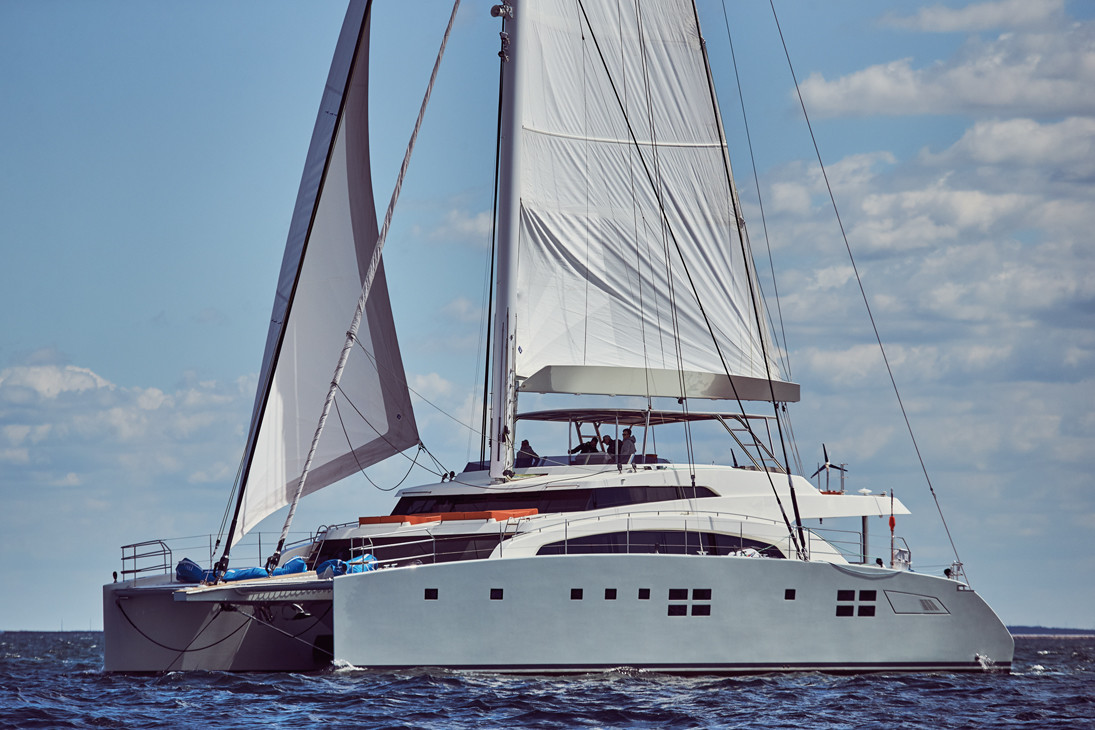
A good average speed to cross the Atlantic or to reach new anchorages in the Caribbean islands after a beautiful summer season in the Mediterranean also guided their choice. It simply remained to find a shipyard capable of satisfying the wishes of the owner. With a budget of more than 4 million euros, this owner was looking for a boat that was not just ultra-equipped and of the highest quality, but a unit that was entirely made ...
To read in full, Buy the boat test
What readers think.
Post a comment
No comments to show.
Share this article
Follow us on, vous avez ajouté " " à vos favoris., vous avez supprimé " " de vos favoris., in order to add this article to your favorites, please sign in..
- Green Propulsion
- Renewable Energy
- Energy efficiency
- Sustainable materials
- News & Events
- Sunreef News Magazine
- Press About Sunreef

- 60 Sunreef Power
- 70 Sunreef Power
- 80 Sunreef Power
- 100 Sunreef Power
- Sunreef Supreme Power
- Sunreef Ultima Range
- Sunreef 44 Ultima
- Sunreef 55 Ultima
- Sunreef 66 Ultima
- Sunreef 77 Ultima
- Sunreef 88 Ultima
- Sunreef fleet

- Sunreef Zero Cat
- Sunreef 100 Eco
- Sunreef Fleet

- Sunreef 43M
- 49M Sunreef Power
- 210 Sunreef Power Trimaran
- Sunreef Explorer
- 40M Sunreef Explorer
- 40M Sunreef Explorer Eco
- 50M Sunreef Explorer
- Superyachts Fleet
Sunreef 88 Double Deck
- Sustainable
DISCOVER THE MODEL
Description.
The start of the ambitious Sunreef 88 Double Deck project was officially communicated during Sunreef Yachts’ press conference at the Cannes Yachting Festival 2016. After eight months of intensive work, the shipyard proudly announced the launch of this catamaran with a zealous, sporty look.
An experienced yachtsman switching from a massive motor yacht , the owner decided to commission the Sunreef 88 Double Deck to pursue a more stable navigation style with greater living space. Indeed, a challenging project for the shipyard’s engineering and design teams.
Nonetheless, this journey was destined to keep the promise of delivering a state-of-the art fully customized sailing catamaran from the start. To achieve the goal of building a seaworthy and dynamic catamaran, Sunreef Yachts’ team of naval architects conceived a completely new yacht design which seemed far sportier than the rest.
Same as all yachts within her range, the Sunreef 88 Double Deck too features a mezzanine level inside the saloon and a spacious master stateroom with a panoramic view in the bow part of the main deck. However, her superstructure was granted a more aerodynamic aspect. As a result, the 88-footer emphasis equally on both performance and luxury, offering over 300m² of living space and an outstanding sailing experience.
Despite this, the Sunreef 88 Double Deck remains a family-friendly yacht offering the best of comfort and safety. The innovative composite superstructure of the sailing yacht conceals a smart and functional layout with luxurious accommodations for eight guests and up to five crew members.
Upon the owners’ request, the interior decor of the Sunreef 88 Double Deck features exclusive natural materials: Chambord oak, linen, leather, natural stone, and quartz tiles – all contribute to the warm and welcoming atmosphere of the sailing yacht . The feeling of warmth was also achieved through applying numerous orange accents to the interiors – an important color for the owner’s family who consider it to be a symbol of energy.
For comprehensive information and guidance on our products, contact us .

SPECIFICATION
- CLASSIC VERSION
Construction
27 m / 88 Ft
Length overall
Beam overall
245 m² / 2637 Ft²
Water capacity
Sunreef Yachts
385 m² / 4145 Ft²
Fuel capacity
2.30 m / 7.5 Ft
180 m² / 1940 Ft²
Comments are closed.
SUBSCRIBE TO OUR NEWSLETTER
- Sailing Yachts
- Power Yachts
- Superyachts
- Making a Change
- Green Concept
- Energy Efficiency
- Sustainable Materials
- ECO Q&A
Copyright © 2024 Sunreef Yachts . All rights reserved.
- Whistleblowing
- Privacy Policy

Sunreef Venture S.A.
Sunreef Yachts Shipyard
ul. Tarcice 6
80-718 Gdańsk, Poland
+48 58 769 77 77
Launched Sunreef Yacht - Not For Sale:
Sunreef 92 dd (92ft)-vessel summary.
BASIC SUMMARY
Dimensions & specifications, hull and deck configuration, engine details.
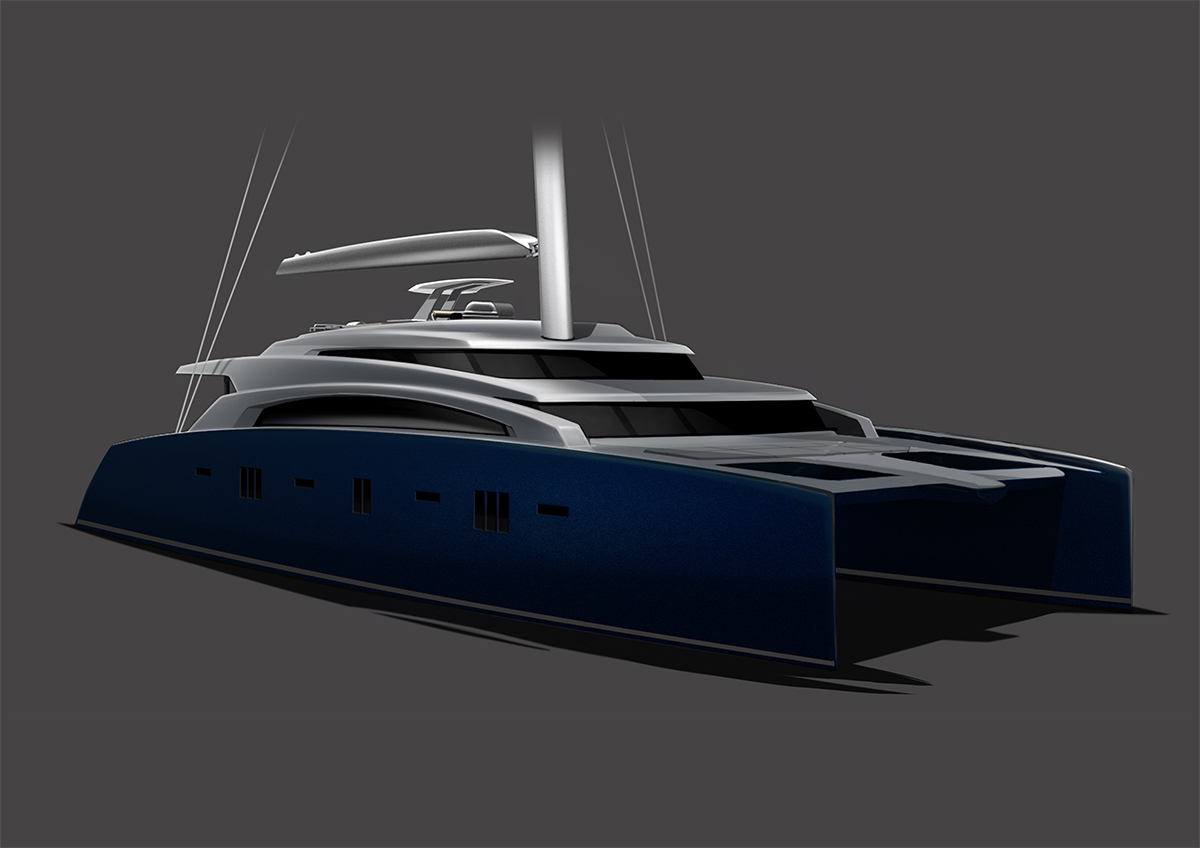
- Update Profile
- Email me when price is activated
- Do you own a boat like this? Sell it now
Boat Description
The Company offers the details of this vessel in good faith but cannot guarantee or warrant the accuracy of this information nor warrant the condition of the vessel. A buyer should instruct his agents, or his surveyors to investigate such details as the buyer desired validated. This vessel is offered subject to prior sale, price change, or withdrawal without notice. Photos may not properly reflect the current condition of the actual vessel offered for sale. In some cases stock photographs may have been used.
Mechanical Disclaimer
Engine and generator hours are as of the date of the original listing and are a representation of what the listing broker is told by the owner and/or actual reading of the engine hour meters. The broker cannot guarantee the true hours. It is the responsibility of the purchaser and/or his agent to verify engine hours, warranties implied or otherwise and major overhauls as well as all other representations noted on the listing.
Dinghy Disclaimer
All dinghies are considered separate vessels and should have separate titles and documents. There is no guarantee as to the title of the dinghy on this vessel so Buyer accepts that while he may receive the dinghy included in the transaction, he may not receive the proper title to it.
- YACHT DESIGN
- YACHT MARKET
- YACHT CLUBS
- YACHT HOTELS
- CHARTER YACHTS
- YACHT SHOWS
- REGATTAS & RACES
YACHT ACCESSORIES
- YACHT APPAREL
- SAILOR GUIDE

- Advertise with Us

New Sunreef 92 Double Deck Sailing Catamaran
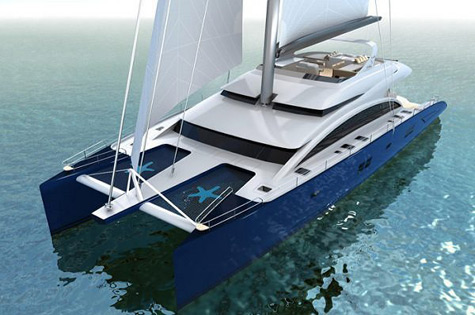
From the same people who brought you the original Sunreef Yacht, comes the new Sunreef 92 Double Deck , with a new design which not only streamlines the deck house, but tops it with a giant 40 m 2 fly bridge.
This was inspired by similar designs found on other super yacht designs. In collaboration with K-Epsilon and Rivoyre Ingenierie , The Sunreef Naval Architecture Bureau has intensely studied performance and sea capabilities using state of the art CFD, computational flow dynamics to create the ultimate in catamaran luxury.
Using integrated stepped hull chins, the Sunreef 92 Double Deck catamaran increases interior space, without compromising performance. Now this yacht can accommodate up to 10 guests, in up to 5 double luxury suites, as well as a crew of four.
Sunreef’s 92 Double Deck also features a canoe style boom and carbon mast, one of this manufacturer’s specialties. How are they able to accomplish such feats? They added a new mezzanine floor, which includes a coffee table and lounge, located on the port side of the main deck dining area, freeing up more space below for larger cabins and storage space, or even more suites if you prefer.
Because of this innovative design modification, now the owner’s suite occupies two floors of the entire front area of this yacht, with a private luxury office, gym and leisure area on the upper level, with the bathroom, wardrobe and storage area below deck. Each cabin has an extended size, three way access to their King sized beds, with spectacular panoramic sea views. Not only this, but each luxury suite comes with its own separate bath and shower area, large closets, storage lockers, as well as their own air conditioning and a comprehensive entertainment system.
With a LOA of 27 meters, an 11.2m beam, and a 1.6m draft, this super yacht has a 80 ton displacement. It will also be powered by two 405HP 1200 L/3170 Gal engines, and will be able to cruise at speeds up to 15 knots. The 70m 2 cockpit will also include a large dining area, sunbathing mattresses, and diving equipment. Its spacious fly bridge is fitted with a jacuzzi, two wet bars, barbecue, ice makers and even a pair of jet skis. It will also include a tender, hidden in a specially built locker under the main sun pad of the cockpit.
Even though this is only the second of such models, it isn’t hard to see why the Sunreef 92 Double Deck sailing catamaran is on it’s way to be one of the most sought after luxury yachts. With it’s innovative design, state of the art electronics, and focus on luxury, the Sunreef 92 Double Deck is top of the line, and a must for people who may still think they have it all. Don’t miss out on your own little piece of paradise.
Sunreef 92 Double Deck specification:
Length overall: 27.00 m/88.85ft Beam maximum: 11.20 m/36.60ft Lightship displacement: 80 T Draft maximum (dagger boat): 1.60 m/5.2 ft Mast clearance: 43.20 m/ 142 ft Mast height: 35.40 m/ 116ft Fully battened main sail: 280 m²/3013 ft² Gennaker: 350 m²/3767 ft² Genoa: 160 m²/1722 ft² Solent: 90 m²/ 968 ft² Main engines: 2 x 405 HP Fuel capacity: 12000 L/3170 Gal Water capacity: 2 x 2000 L/2 x 528 Gal Cruising speed on sails: 15 knots Guests : 10 Crew: 3 Naval Architecture/Design/Builder: Sunreef Yachts
Related links: Sunreef Yachts
Foto: sunreef-yachts.com
- Rivoyre Ingenierie
- Sunreef 92 Double Deck
- Sunreef Catamaran
Related Articles
Skia by design storz: unveiling of a 109-meter superyacht concept, introducing the wallywhy100: a marvel of design and performance, sinot’s beach superyacht series: a symphony of luxury, nature, and sustainability, staying afloat: a guide to survival suits for boaters, navigating waters with ease: top 5 dog ramps for your water-loving pup, unleashing comfort and safety: a guide to essential boat accessories for dogs, unwrapping the top 10 best christmas gifts for yacht enthusiasts, docktail butler elite teak table: elevating yachting experiences with elegance and functionality, exploring the abyss: unveiling the powervision powerray wizard underwater drone, seas of sip: captain ladle and the toadfish tumbler tale, sailing the seas of sound: the fusion® apollo™ ms-srx400 marine zone stereo adventure, water exploration with robosea warp10 water scooter.
OceanShaker.com is a treasure chest of information for people who really "dig" yachts. We believe our project will be a real concoction of beautiful yachts, fresh news, ocean winds and, of course, adventures.
Contact us: [email protected]
© Copyright 2023 - Oceanshaker.com
- AIRPORT LOUNGES / AIRPORT SERVICES

- Montego Bay
- Port Antonio
- South Coast
- Treasure Beach
Where To Stay
Things to do.
- WHERE TO EAT
- AIRPORT LOUNGES
- Airlines that fly to jamaica
- PRIVATE TRANSFERS
- Cruise Ship Ports
- Travel Specialists
- Golf Courses
Welcome Messages
Useful information, airport services, wedding and romance.
- Attractions And Tours
- Nightlife & Entertainment
- Golf & Other Sports
- Arts And Culture
- Off the Beaten Path
- Health And Wellness
- Nature Wildlife And Outdoor
- All Inclusive
- Villas & Boutique Hotels
- Business Hotels
- Budget Accommodations
- Lifestyle And Music
- Brand Jamaica
- Jamaican People
- Food Recipes
- Drink Recipes
Jamaica Travel Stories
- Digital Magazine & Newspaper
Jamaica Diaspora
A seafaring adventure on island routes double-decker catamaran cruise.
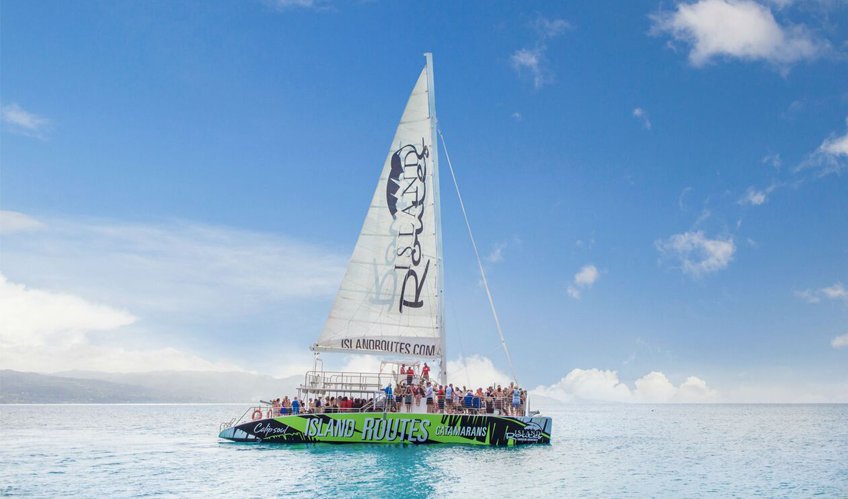
Embark on a luxury catamaran cruise adventure out of Ocho Rios, Jamaica that takes adventure to new heights.
Standing on the dock, I pause a moment to let my gaze travel slowly upwards at the gleaming catamaran floating before me. Rocking gently in the calm Caribbean Sea, the beautiful double-decker Calipsoul seems familiar yet exciting and new to me all at the same time. I had chosen Island Routes Catamaran Dunn’s River Cruise the last time I was in Ocho Rios, Jamaica. It had been the perfect combination of relaxation and excitement that I had been looking for. We had also done the romantic Lovers Rock evening cruise, literally sailing into the sunset together. Making the cruise reservation Both times it had turned out exactly as promised and this time around when I knew I was heading back to Jamaica, I reached out to the wonderfully helpful Island Routes team yet again. I spoke with them about how much I had enjoyed the last catamaran excursion I did with them and shared that this time I would be coming with a group of friends and family of all ages. I had enjoyed the snorkeling aspect of the Dunn’s River cruise so much but it had been fairly short and some of my group said they really wanted to let loose and relax.
Island Routes Reggae Family catamaran cruise They suggested the Island Routes Reggae Family catamaran cruise. They explained that it was like The Dunn’s River cruise minus the climbing, which my mom was happy to hear about, and a lot of time spent exploring the underwater world. Then they told me how great my timing was as they now have a brand new double-decker catamaran! To be honest, I couldn’t quite picture it so I didn’t know what to expect. Standing here, about to step onto the Calipsoul , I am filled with delight as the kids all leap aboard. We aren’t the only family on board that day and as my group is fairly large, coming over on the shuttle service from the Beaches all-inclusive family resort, I had been worried about feeling crowded. Yet, what we discover is the perfect blend of being able to find ample areas for ourselves while also having the opportunity to meet other people as equally excited as we are.
Snorkeling lesson Once in the water, we are directed by the crew, who have joined us, where to swim and, along the way, they make sure to point out coral formations and beautiful fish ensuring we have an amazingly immersive experience (pun intended). I explore for ages and I am very excited as I brought my waterproof camera with me this time and aim to meet my self-imposed challenge of taking an underwater selfie with tropical fish. Although unsuccessful because they move pretty quickly, I still have a blast. Suddenly, someone is tapping me on my shoulder and I pop my head up to see one of the crew members guiding me back to the boat. Making my way back I realize that, as strong a swimmer as I am, I’m pretty happy to have the life vest on as it allows me to keep looking underwater while I make my way back without having to put in too much effort in keeping myself headed in the right direction so all my focus is on the magical world below me. Trampoline for the kids, hammocks for the adults We climb aboard and the teenagers head to the trampoline area (I was told that’s what it’s called). For people who may not normally hang out on a boat, this area serves an engineering purpose but is also a pretty cool place to just hang out on as it’s like a flat stretched-out hammock where you can just lay out and chill. I divest myself of the fins, mask, and vest and realize I’m pretty hungry! Lunch on the ocean Luckily, the food comes out and everyone piles up their plates with tropical fruit, delicious wraps and chips, and salsa, and we head for a sunny spot on the upper deck of the catamaran. We start chatting with other people and decide it’s just about the right time for the rum version of that delicious fruit punch (after all we’re in Jamaica, how can we pass up the delicious rum when no one is driving or diving). My husband opts for a cold Red Stripe instead and leans back to work on his tan. Learning Jamaican dance moves We hear music and a lot of laughter below and realize the trampoline is empty. I decide to leave my husband happily tanning and I follow the music only to discover a full-blown dance class, as the crew is teaching everyone the latest Jamaican dancehall dance moves. Although I feel a little self-conscious when I join in, that quickly fades away as everyone tries their best to match the expertise of the crew. Over on the right, two little girls have their own crew member showing them what to do and they catch on quickly, delighted grins lighting up their faces. I manage to muddle through and I’m pretty sure my sister is going to show these videos to everyone once we get back home for an evening full of a similar level of laughter at my expense. In that moment though, I don’t care. I feel the salt from the sea drying on my skin, my hair is a tousled mess and I’m dancing with my children in the middle of the Caribbean Sea. This, I think, is what happiness is.
Check out the website for more information on Island Routes' catamaran cruises and other excursions they offer in Jamaica and elsewhere in the Caribbean. They’ll help you to book your perfect adventure today! You can also chat online or call US Toll-Free: 1.877.768.8370 Toll-Free Caribbean: 1.800.744.1150 International: 1.305.663.4364
Also, read Take The Driver's East Seat On An Island Routes Mini-Routes Adventure .
Stay tuned for the latest updates and discounts.
Facebook: @IslandRoutes Instagram: @IslandRoutes Twitter: @IslandRoutes

YOU MAY ALSO LIKE

5 scenic drives in Jamaica February 28th, 2017

10 best golf courses in Jamaica March 06th, 2017

10 things to do with kids in Jamaica March 06th, 2017

10 unique experiences in Jamaica March 06th, 2017
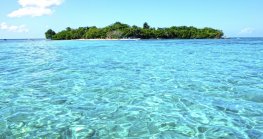
Food, Drink And Recipes

Best of Jamaica

Real Estate
Lounge Experience

Cannabis Tourism

Posted by Facebook on Thursday, August 27, 2015

Unleash Your Inner Mystic

10 best golf courses in Jamaica

‘Wha' gwaan goodie’ - a guide to Jamaican greetings
© 2019 Jamaica Experiences All Rights Reserved

The global authority in superyachting
- NEWSLETTERS
- Yachts Home
- The Superyacht Directory
- Yacht Reports
- Brokerage News
- The largest yachts in the world
- The Register
- Yacht Advice
- Yacht Design
- 12m to 24m yachts
- Monaco Yacht Show
- Builder Directory
- Designer Directory
- Interior Design Directory
- Naval Architect Directory
- Yachts for sale home
- Motor yachts
- Sailing yachts
- Explorer yachts
- Classic yachts
- Sale Broker Directory
- Charter Home
- Yachts for Charter
- Charter Destinations
- Charter Broker Directory
- Destinations Home
- Mediterranean
- South Pacific
- Rest of the World
- Boat Life Home
- Owners' Experiences
- Interiors Suppliers
- Owners' Club
- Captains' Club
- BOAT Showcase
- Boat Presents
- Events Home
- World Superyacht Awards
- Superyacht Design Festival
- Design and Innovation Awards
- Young Designer of the Year Award
- Artistry and Craft Awards
- Explorer Yachts Summit
- Ocean Talks
- The Ocean Awards
- BOAT Connect
- Between the bays
- Golf Invitational
- Boat Pro Home
- Pricing Plan
- Superyacht Insight
- Product Features
- Premium Content
- Testimonials
- Global Order Book
- Tenders & Equipment
First Sunreef 88 double deck catamaran launched
The first hull in the Sunreef 88 range of double deck sailing catamarans has been launched in Gdansk for a European owner, the Polish yard has announced.
This fully personalised multihull superyacht measures 26.82 metres LOA and was styled inside and out by the in-house team at Sunreef Yachts .
In a statement, the Polish yard added that the design of the Sunreef 88 is “a great display of the shipyard’s non-conformist attitude and a genuine example of an avant-garde sailing catamaran concept”.
Captain Ian Sellers added: "She is a beautifully crafted, fully customised transoceanic catamaran, with superb quality and finish."
The design brief was focussed on three key themes: luxury, performance and privacy. To this end, the Sunreef 88 features more than 300 square metres of living space — an impressive figure for a yacht of this size, proving that bigger isn't always better .
This two-deck sailing yacht will feature an extensive flybridge with a central helm station and plenty of al fresco dining and relaxation spaces. Back aft, the cockpit features a central dining table with seating space for ten guests as well as a second sunbed, making good use of the Sunreef 88's 11.2 metre beam.
The in-house design includes sporty and dynamic exterior lines, as well as a fully customised interior layout. Key features include a mezzanine level in the saloon and a main-deck owner's cabin , which boasts superb views out to sea through panoramic windows.
Auxiliary power comes from a pair of 425hp engines drawing on a total fuel capacity of 8,000 litres, while her total sailplan is in excess of 345 square metres.
Sunreef added that the designers drew inspiration for this single-masted sailing yacht from the 35 metre flagship yacht Che , which was launched in 2010. The Sunreef 88 is the sixth superyacht from the Polish yard, which has also created the Sunreef 102 yacht Ipharra .
Similar yachts for sale
More stories, most popular, from our partners, sponsored listings.
36 double-decker catamaran
Alexandra resort beach, up to 25 passengers, from $1,680.00, boat details, 32 double-decker catamaran, 'what is included'.
All Your Gear (Fins, Mask, Vest), Beer, Rum Punch, Soft Drinks, Water, Grilled Fish, Gourmet Sandwiches (Half Day), Grilled Chicken (Full Day), Corn on the Cob (Full Day), Grilled Garlic Bread (Full Day), Peas & Rice (Full Day), Light Snacks
'Add-On Options'
Lobster (in season): $30/lb, Charcuterie: Small $70, Medium $120, Large $160,
Tubing: $50 Fishing: $350 + 12 fishing license for guests 16+ years old,
Veuve Clicquot Champagne: $150
'What To Bring'
Reef Safe Sunscreen, Towel, Your own reusable cup
Ice, Soda, Water : Please Check Description
Boat category : Pontoon, Catamaran
Meeting Point : The beach at The Alexandra Resort, just behind the front reception building.
Local Pick Up : Complimentary pick ups are available in the Grace Bay and Leeward areas only.
Food/Snacks : Please Check Description
Paddleboards : No
Specifications
Length : 32
Passenger Capacity : 25
Crew Capacity : 4
Sleep Capacity : 0
Year Built : 2015
Fuel Capacity : 350
Booking options
Boat location.
- How It Works
- About Boatsetter
Popular Regions
- Ibiza , Spain
- Barcelona , Spain
- Cancún , Mexico
- See all regions

DEK KAT 2680
Dek kat 2680 model.
Meet the new standard in nearshore and offshore coastal high-performance catamaran deck boats. With it’s revolutionary twin tunnel hull design, the Dek Kat 2680 is changing the game for inshore fishing by providing a large, stable fishing platform without sacrificing creature comfort options for the family.
BETTER FEATURES
With ample in deck storage, minimal bow rise on acceleration coupled with a shallow water draft of approximately 12”, the Dek Kat is fast becoming an in-shore guide favorite. At 26’ 2” inches long with a beam of 8’6” there is no other bay boat on the market that comes close to her deck space. The twin tunnels provide a stable and comfortable ride even when the weather is not fully cooperative.
If live bait fishing is your game, the 2680 comes standard with two large in deck live/release wells with the option for additional live wells above deck in the forward seating or in our custom leaning post configuration.
MORE COMFORT
The Dek Kat 2680 is a semi-custom built boat which is just as comfortable on the bay waters chasing trout and redfish as it is at the sand bar with your family. Our oversized hard tops keep the family comfortable with the shade and you will find an abundance of seating throughout the boat, including our custom Adirondack style seat built into the console. Built for fishing and comfort cruising, the Dek Kat is truly one of the most versatile bay boat designs out there. It is ready for whatever your weekend desires are upon the water.
BUILD YOUR DEK KAT
352-541-2800.
Email [email protected] Sales 352-222-7202
STAY IN TOUCH
Join our mailing list to stay up to date with our latest announcements!
- Accessibility Statement
COPYRIGHT 2024 © ALL RIGHTS RESERVED.
- Sign In or Register
- Boats for Sale
- Research Boats
- Sell a Boat
- Search Alerts
- My Listings
- Account Settings
- Dealer Advertising
- Deck Boat Catamaran
Deck Boat Catamaran Boats for sale
1-15 of 360
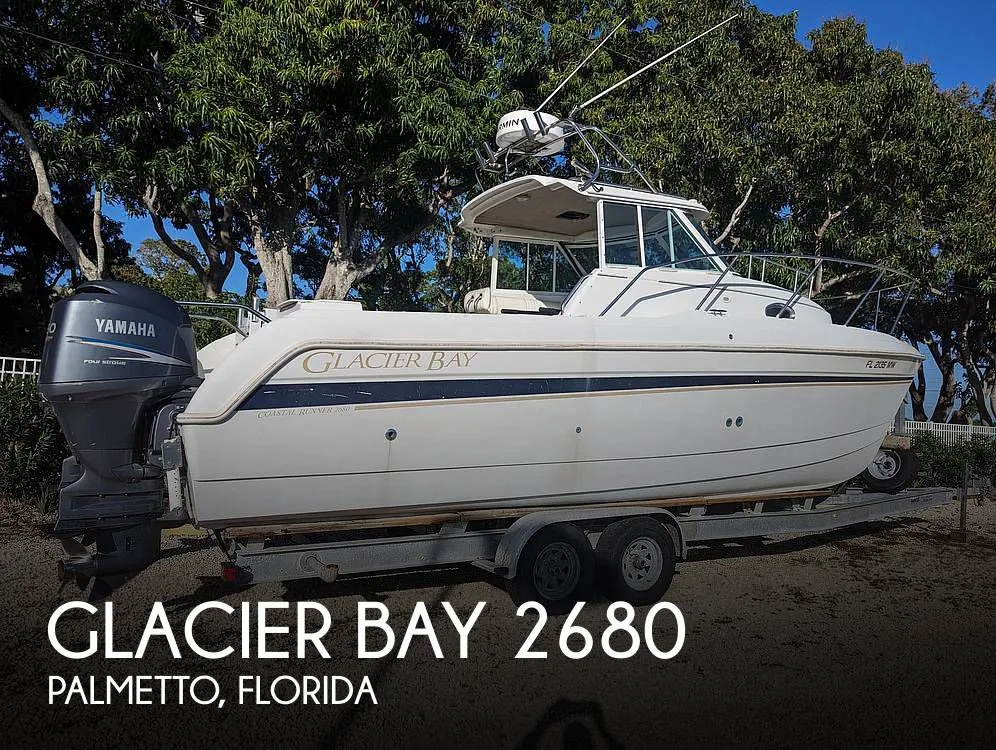
2005 Glacier Bay 2680 Coastal Runner
Palmetto, Florida
Make Glacier Bay
Model 2680 Coastal Runner
Category Power Catamaran Boats
Posted 2 Weeks Ago
This Glacier Bay is in good condition for her age. The seller just had the boat detailed and has a nice hull shine. The hull sides have a nice shine and are free from any major defects. The interior is clean and the electronics have been updated. The cabin is clean and ready for a new owner! Stock #388699 Power Catamaran! Offshore Ready! Just Detailed! Engines Run Great!! 2005 Glacier Bay 2680 Coastal Runner This is a nice power catamaran design with quality construction by Glacier Bay. This Coastal Runner features an interior cabin with room for two to sleep very comfortably and a plumbed head. The dual hull design with its wide beam, and high gunwales creates the perfect combination for a dry, stable ride, even in rough sea days. The cockpit features a wrap-around windshield and side windows with a hardtop overhead with two opening ports. The rear deck area has coaming pads for comfort, a huge live well and access to the integrated swim platform. There are plenty of rod holders and two fish boxes are in the floor. This design allows you to walk around the sides to the bow with handrails. The electronics were recently updated. There is a Garmin GPSMAPS 8612 xsv series 12" touchscreen IPS multifunction display chartplotter-sonar combo with BlueChart G3 and Lakeview G3. A Garmin GT56UHD-TM Traditional CHIRP High wide / UHD Clear-side transducer. A Garmin GMR Fantom 24x White 50 watt Solid State Radar, 60 RPM, 8 Bit Color, Dual Range, Overlay Support, and a Garmin Reactor 40 Hydraulic Corepack with SmartPump with GHC 50 Autopilot that has not been installed yet. Check out all the photos and call today to make it yours! Reason for selling is buying another boat.
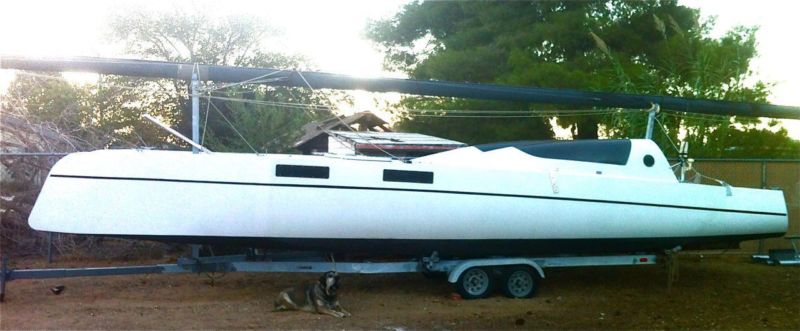
Santa Barbara, California
Posted Over 1 Month
Trailerable 34' catamaran. Demountable. Sets up in 1.75 hours. 34 LOA beam 20 mast 45' from water. This is a very fast cat with no light air problems at all. Brand new sails, sleeping in the hulls. Wave piercing bows. great galvanized trailer. Packs down to 8' wide for the road or shipping container. serious buyers only please. Asking 49k O.B.O. Here is the inventory list. This is quite possibly one of the finest custom Stilettos on earth. . Deluxe trailer. Quick set up. Racer / cruiser. Custom sleeping births in each hull. Professionally reconditioned to "like new" condition in 2005. structural glassed in bed frames with extra floatation, upsized sea hatches, Lewmar winches. 20' beam and transforms into 8' wide for trailering or fit into a shipping container and ship over seas. Set up to single hand. Room for plenty of friends or the whole family. She is wicked fast, handles like a dream with a light helm that is quick and responsive. This cat was originaly a "Stiletto 27" we added a 3' stern extention kit and a wave piercing bow off the Oracle pattern making it a full 34 feet. Length overall 34' Length at water line 34' beam 20' mast hieght from water line 45' Inventory: 12 volt gel cell. 2 Colligo endless line furliers with endless fid lines. 15 hp Mercury motor. starts and runs perfect. VHF radio with stern mounted antenna. Sony Marine AM/FM CD. Marine grade electronic panel with futures 3 12 volt charge adapters New autohelm with custom bracket Rear net/tramp from the webbing material of the big cat "Double Bullets" Two Openable port lights interior forward bow Custom Pro built mast rotator stainless differential Colligo line organizers Four Halyard clutches mast mounted Beautiful new custom centerboard. Garmin GPS Hull mounted GPS antenna. "SPOT" rescue system New gas tank. Galvanized trailer. twin axle New hevey duty hitch Custom built in sink and cabinets with fresh water tank New deluxe Porta Potti Two deck mounted anchor lockers Custom white marine grade cushions in almost new condition. 2 sets of oars new 6 new life jackets in the case. Main sail is full roach glass battens only used a couple times. w/ lazy jacks. Screecher used once. Brand new jib in the bag Second jib. Mylar very used but a lot of sailing left in it. Galvanized trailer with set of removable magnetic lighting. Custom aluminum motor mount Brand new all synthetic rigging . S.E. model with side windows at the head of the births. (Lexan) New Lexan canopies Glass high performance rudders. Two Adjustable tiller handles with shovel grips Center dagger board was custom made ( glass ) high performance foil aprox. 6' tall and its beautiful. New fire extinguisher, tool kit, compass, shade cockpit cover, big anchor with 30 feet of chain and a lot of rode, lots of extra lines and frankly I can't remember all thats in my boat so just come see it. lots of misc. This Catamaran is ready to trailer and sail right now. A ton of money and careful attention has been poured into this boat, Many more extras and lots of photos to serious qualified buyers only please. Shipping can easily be arranged. 49,000 U.S. Dollars

1999 Catamaran Berkstresser Boats 60
Clearwater, Florida
Make Catamaran
Model Berkstresser Boats 60
1999 Catamaran Berkstresser Boats 60 A 60 foot world cruiser, live aboard and term charter sailing catamaran that is fast, long, light, comfortable, efficient and easy to sail (single hand). Low maintenance design provides a safe and unsinkable vessel. Many windows, ports and hatches provide a lite, open and airy interior. Lots of locker space provides storage for gear and toys (dive gear, windsurf, kite and surfboards). Large aft deck for allows ease of setup for tender operation and setting up water toys. Large swim platform and swim steps provides for easy water access. This world cruiser, live aboard or term charter sailing catamaran provide accommodations for 1 to 10 persons in 4 cabins with queen size beds, private heads and showers and two separate crew cabins with single beds and lots of storage. Excellent opportunity exist for new owners to add to an existing fleet or to startup a new business. A real money maker with prior weekly BVI bookings in the $16,000-$22,000 range depending on the dates. Out-of-State buyers can now buy and use their boat in beautiful Florida for 180 days with No Florida Sales Tax! Ask your EYS broker for details.
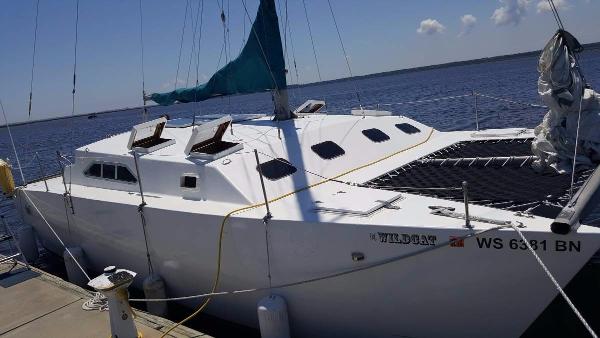
1987 Catamaran Hortsman 34'
Miami, Florida
Model Hortsman 34'
1987 Catamaran Hortsman 34' 34 1987 CATAMARAN HORTSMAN ONLY 70 HOURS PRACTICALLY BRAND NEW 2014 30HP HONDA UPGRADED ENGINE MOUNT AUTO PILOT 2017 SIMRAD GO 7XE CHART PLOTTER WITH SIDEVIEW SONAR 2, 40 GALLON FRESH WATER TANKS SOLAR PANELS UHF RADIO BRAND NEW CUSTOM BENCH BRAND NEW TOPSIDE DECK PAINTED SEA ANCHOR PARACHUTE SYSTEM HEAVY DUTY FRONT ANCHOR AND REAR ANCHOR LED LIGHTING AND TONS OF OTHER ACCESSORIES THAT WILL GO WITH THE BOAT There a ton of extras. We just upgraded everything just about for some blue water traveling. You really need nothing else to do to her. She is turn key at this moment. Financing available if needed.
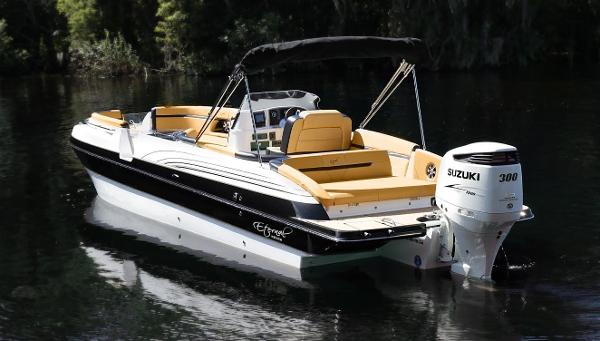
2016 Eternal Boats 28 Catamaran Deck Boat
Dunedin, Florida
Make Eternal Boats
Model 28 Catamaran Deck Boat
Category Deck Boats
2016 Eternal Boats 28 Catamaran Deck Boat Be sure to check out the above video highlighting key features of the boat! America's First True High Performance Catamaran Hull with Deck boat platform. Ladder with shower in front, Eternal door in front, Deck boat seating with plenty of storage underneath. 2 designated cooler areas. Standup porcelain head with electric flush, carbon fiber vanity with sink and shower. Under helm, double helm seat with flip up holster. Touch screen Garmin GPS with 2 digital gauges. All doors are backlit in blue. Under water blue courtesy lights. Back off the boat enhanced with play pen area which electrically raises to reveal additional storage. 2 ladders in the back with shower 1 ladder in front.
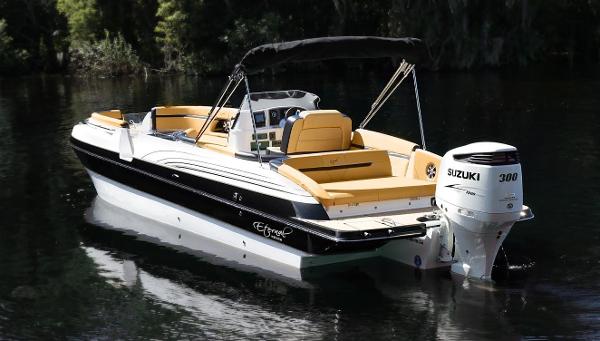
Category Powerboats
2016 Eternal Boats 28 Catamaran Deck Boat America's First True High Performance Catamaran Hull with Deck boat platform. Ladder with shower in front, Eternal door in front, Deck boat seating with plenty of storage underneath. 2 designated cooler areas. Standup porcelain head with electric flush, carbon fiber vanity with sink and shower. Under helm, double helm seat with flip up holster. Touch screen Garmin GPS with 2 digital gauges. All doors are backlit in blue. Under water blue courtesy lights. Back off the boat enhanced with play pen area which electrically raises to reveal additional storage. 2 ladders in the back with shower 1 ladder in front.
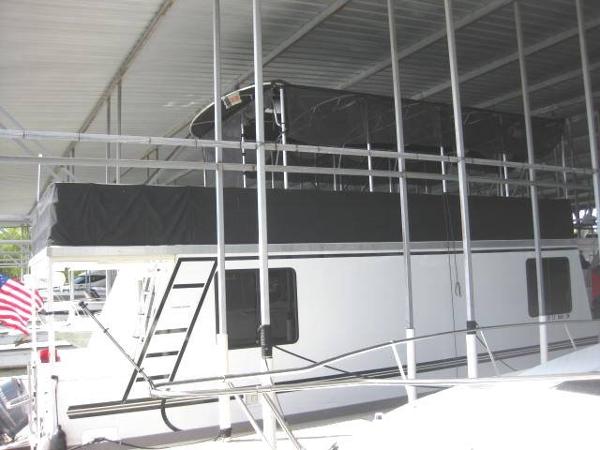
2012 Catamaran Cruisers Custom House Boat
Flower Mound, Texas
Make Catamaran Cruisers
Model Custom House Boat
Category Cruiser Boats
2012 Catamaran Cruisers Custom House Boat GREAT LIVE-A-BOARD!FRESHWATER USE ONLY!YAMAHA 115 FOUR STROKE! ONLY 48 HOURS!AIR CONDITIONING!GENERATOR!This VERY clean 39' x 12' custom houseboat is powered by a fuel efficient Yamaha 115hp four stroke outboard motor with only 48 hours. Wonderful light and bright layout with private stateroom, full galley and large head. Other features include large front and aft covered decks, docking lights, 30 amp shore power, rear & upper deck camera with monitor, depth finder, factory installed generator, roof top air conditioning, 2 flat panel TV's, High Powered Kenwood sound system with multiple speakers including six JL Audio bullet speakers outside and 3 amps, large dinette, sofa sleeper, hot water, stove, M/W, full size frost free refrigerator, private master stateroom with privacy door, large head with marine toilet and huge stall shower, lots of storage space, huge upper deck with custom made aluminum party top canopy and shade screens, fans, large flat screen TV and more. This would make a great live-a-board or weekend cruiser. NO TRAILER! All photos and videos shot October 1, 2016.Located on Lake Lewisville and turn-key ready for use!
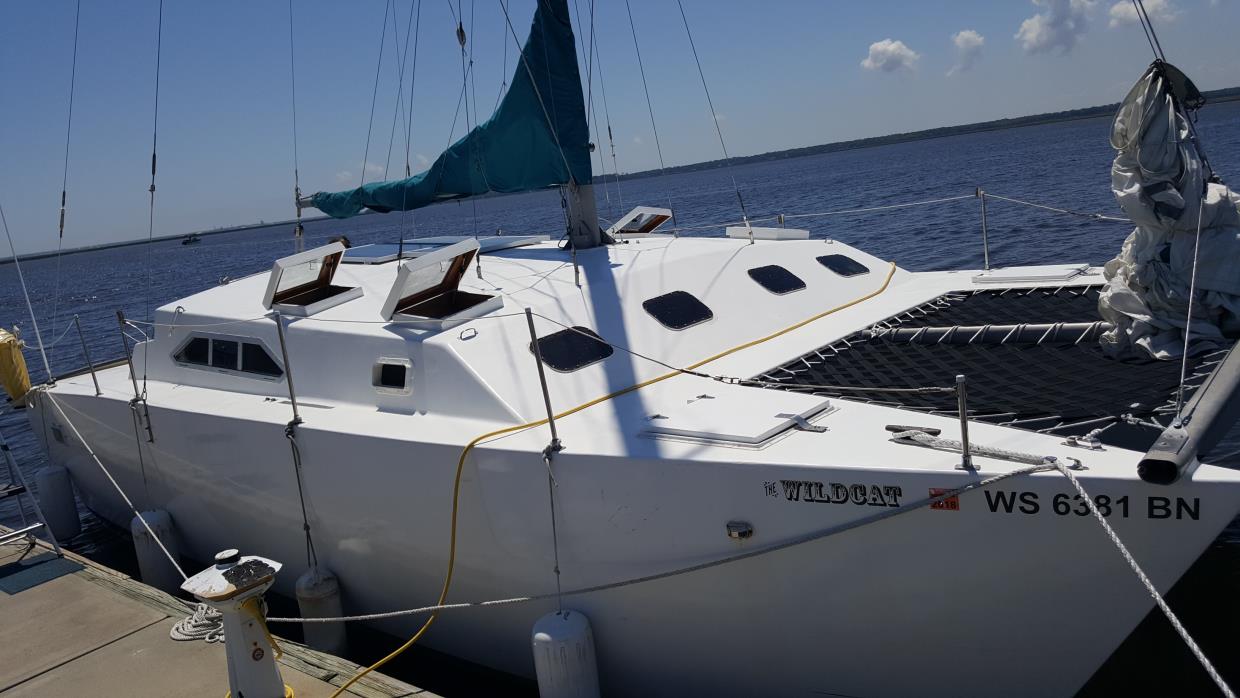
1987 Horstman Catamaran
Palm Beach Gardens, Florida
Make Horstman
Model Catamaran
Category Catamarans
1987 Horstman Catamaran Selling my beautiful sailing Catamaran. She is a 34 ft Hortsman. Built solid from wood and fiberglass. She will not sink. Great for a live aboard or just checking out beautiful places. There a ton of extras. We just upgraded everything just about for some blue water traveling. You really need nothing else to do to her. She is turn key at this moment. Comes with:3 SailsPractically brand new 2014 30hp HondaUpgraded engine mountAuto pilot2017 Simrad Go 7xe Chart plotter with sideview sonar 2016 Generator 2, 40 gallon fresh water tanks Solar panelsUHF radioBrand new custom benchBrand new topside deck paintedSea anchor parachute systemHeavy duty front anchor and rear anchorLED LightingAnd tons of other accessories that will go with the boatCall me at 904-Seven-Zero-Three-8273
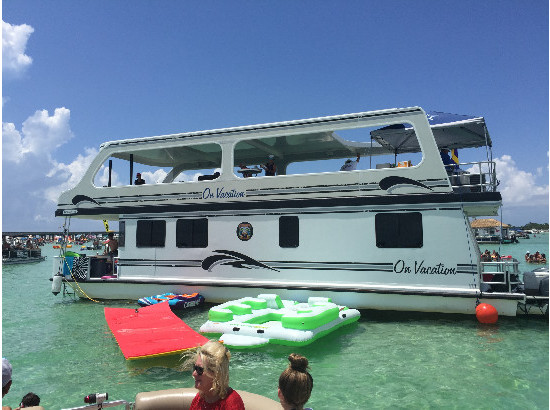
2002 Custom Catamaran
Raceland, Louisiana
Make Custom
Category Houseboats
2002 Custom Catamaran, Comfort on the water doesn't get much better!!!Introducing this 2002 Custom 52ft Catamaran Houseboat "On Vacation" manufactured by Louisiana Houseboats Inc. This 2 bedroom, 2 bath floating home has all the convenience of a fully furnished condominium with the capabilities to change your residency with the crank of an engine. The fully fiberglass hull is powered by twin 250 Yamaha outboards keeping engine maintenance low. The interior was newly refurbished for 2016 with new carpet throughout the boat as well as a new stack Whirlpool washer and dryer in the master. The 2nd story sundeck with fiberglass top features sofa style seating across the bow, with the entire deck being open to the stern maximizing the total area above. Why settle for a vacation home in one location when you can travel the coast without leaving the comfort of your living room sofa?Highlighted Features Include:-2 Bedrooms 2 Bath-New Carpet throughout the boat-New Stack Whirlpool Washer and Dryer-Fully Furnished Living room and Kitchen-Electric Cooktop stove, Oven & Microwave-Full size Refrigerator-Twin Yamaha 250 outboards (2006 model year)-600 gallon Fuel Capacity-600 gallon Fresh Water tank-Onboard Sewage treatment plant-23kw Isuzu Generator-2 50 amp shore power outlets (boats runs on 1)- Fresh water line hookup-Bose Sound system (top deck)**Boat is located in Louisiana on open waterways, No landlock transportation cost** $170000.00
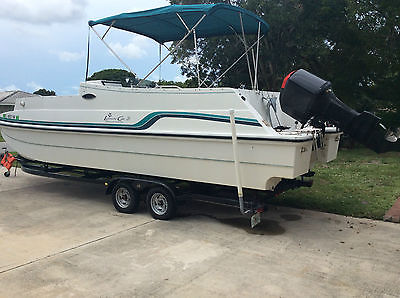
Leisure Cat 26 Catamaran Deck Boat with Trailer
Naples, Florida
Model Leisure Cat 26
Length 26.0
Leisure Cat 26 Catamaran Deck Boat with Trailer. Anchor & line, large bimini top, aft swim ladder, full cover, seat cushions, fresh water shower, and full lighted gauges. Power: 1998 225 HP Mercury outboard motor - serviced this year and runs perfectly. 2 new batteries and internal battery charger. 80 gallon fuel tank. Max capacity of 12 passengers. 2013 Bear Tritoon Trailer. Holds 24 to 26 foot Tritoon. Model PB 13-26TTL. 2 axles with drum brakes, adjustable rails, and in great condition.
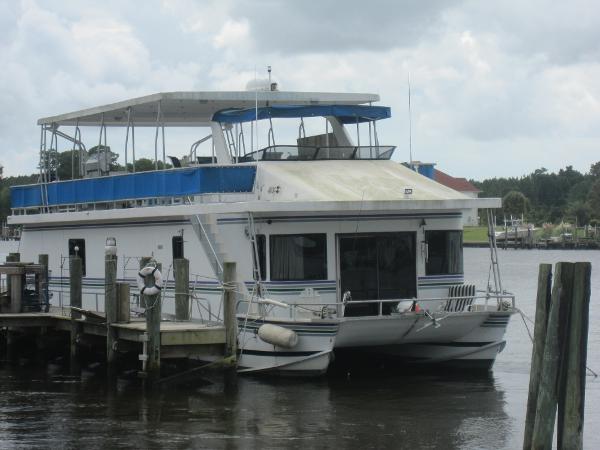
1998 New Orleans Catamaran House Boat
Wilmington, North Carolina
Make New Orleans
Model Catamaran House Boat
Category Power Catamarans
1998 New Orleans Catamaran House Boat Huge cruising home with trawler economy. With her 2002 straight inboard, prop protected 310hp cummins diesels. This three stateroom two head floating home has it all, from her upper and lower steering stations to her forward and aft decks and her massive upper deck for entertaining!!! Also available is the waterfront non-buildable lot w/90'x60' T-dock for $150K. Owner will give the buyer of the boat 6 months free dockage or will finance the sell of the land and dock.
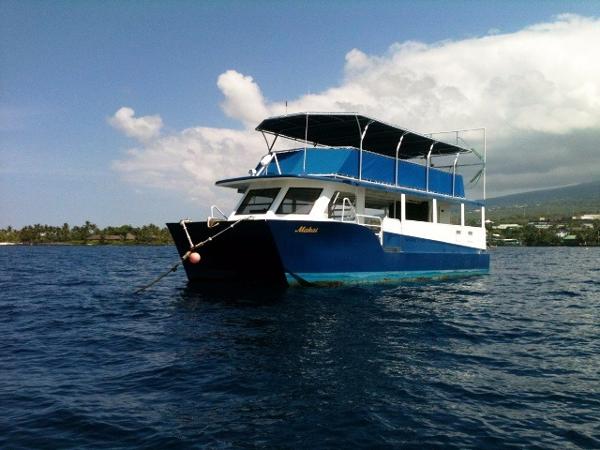
1991 Sea taxi Custom Catamaran Dive Boat
Fort Lauderdale, Florida
Make Sea Taxi
Model Custom Catamaran Dive Boat
1991 Sea taxi Custom Catamaran Dive Boat The Makai is 46 ft long 16ft wide 2-deck power catamaran. It is USCG inspected for 84 passengers. It has been used for sight seeing tours, snorkeling and scuba tours, sunset cruises, whale watching, private events and tendering for cruises ships, private yachts and the military.The vessel has 2 restrooms, fresh water shower, concessions bar, dive/swim ladder and upper deck lounge with cushioned seating. It just completed its bi-annual dry dock an annual inspection. Its hulls are solid fiberglass with glass over wood wing. Registered Dimensions: 46' x 16.4' x 5.2' Tonnage: 11 Gross / 8 Net Type/Trade: Twin Diesel Catamaran / USCG Passenger-Inspected, Coastwise Built in 1991 Opa Locka, Florida and re-powered in 2005. ADDITIONAL PERMIT AVAILABLE FOR PURCHASE: State of Hawaii commercial permit and mooring permit. This permit allows commercial operation from the Kailua Kona Hawaii pier in the heart of Kona. This pier is Kona’s cruise ship port which sees weekly cruise ship visitations. These permits are limited by the State of Hawaii.
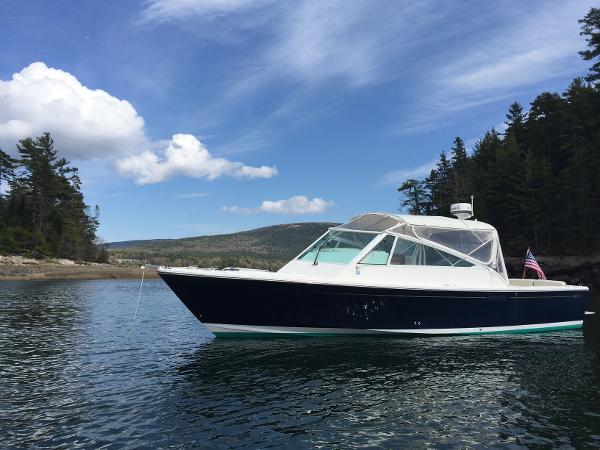
2012 Catamaran Coaches Trimaran
Make Catamaran Coaches
Model Trimaran
2012 Catamaran Coaches Trimaran PRICE REDUCTION! Want the most awesome deck boat ? Or are you thinking about launching a wildlife-watching, sea-touring, flats-fishing, kayaking, paddle-boarding or water yoga and shelling excursion business? THIS IS THE BOAT FOR YOU Custom composite and aluminum-railed 26-foot trimaran draws only 18 inches Two battery banks and an inverter power it all Great sound system Dance on the top deck or store kayaks and paddle boards there Lowrance chart plotter, VHF, live wells, wash down pump & filet table Ready for family fun or create your own business. Custom seating and a private head for your comfort Recent bottom paint No slip fees because a heavy-duty tri-axle aluminum trailer is included. Powered by a low-time (600 hours) Yamaha F350, this Florida-manufactured custom trimaran is strong, fast and reliable. Arrange a showing today.

Narrow Results
Current search reset all.
- Keyword: deck boat catamaran
- Wellcraft (19)
- Glacier Bay (11)
- Twin Vee (7)
- Glastron (5)
- Robertson And Caine (5)
- Sea Fox (5)
- Catamaran Cruisers (4)
- Fountaine Pajot (4)
- World Cat (4)
- Catamaran (3)
- 2 Criag Cats, 2 Mini Speed Boats,2 Jet Skis (2)
- Bayliner (2)
- CATAMARAN CRUISER (2)
- COBALT BOATS (2)
- Carolina Skiff (2)
- Catamaran Coaches (2)
- Catamaran Cruiser (2)
- Eternal Boats (2)
- Hysucat (2)
- Probio Plastic Boat (2)
- Sea Cat (2)
- Seawind (2)
- Splendor (2)
- 33rd Strike Group (1)
- 33rd Strike Group Power Catamaran (1)
- Advantage (1)
- Armadia (1)
- Barracuda (1)
- Beachcat (1)
- BoatYard (1)
- Carolina Cat (1)
- Chaparral (1)
- Desert Shore Yachts (1)
- Destination (1)
- Eliminator (1)
- Eric Lerouge (1)
- Force Engineering (1)
- Four Winns (1)
- GLACIER BAY (1)
- Glacier Bay* (1)
- Gulf Coast (1)
- H2X Custom (1)
- Hobie Cat (1)
- Horstman (1)
- Island Hopper (1)
- Island Packet (1)
- Lightning Power Boats (1)
- Mowdy Boats (1)
- New Orleans (1)
- OFFSHORE CATAMARANS (1)
- Ocean Cat (1)
- Pedigree (1)
- Perfection Boats (1)
- Pro Sports (1)
- Robertson & Caine (1)
- Sea Taxi (1)
- Shoalwater (1)
- Shuttleworth (1)
- Solaris (1)
- Sport Cat (1)
- Sportcraft (1)
- WorldCat (1)
- Catamarans (17)
- Power Catamarans (17)
- Sport Fishing Boats (11)
- Power Catamaran Boats (9)
- Powerboats (8)
- Center Consoles (7)
- Deck Boats (7)
- Houseboats (7)
- Sailboats (6)
- Bowrider Boats (5)
- Cruiser Boats (5)
- Bay Boats (4)
- Dual Console Boats (4)
- Fishing Boats (4)
- Center Console Boats (3)
- Racer Boats (3)
- Saltwater Fishing Boats (3)
- Catamaran Sailboats (2)
- Tender Boats (2)
- Aft Cabin (1)
- Aluminum Fishing Boats (1)
- Cuddy Cabin Boats (1)
- Flats Boats (1)
- Inflatable Boats (1)
- Motor Yachts (1)
- Pilothouse Boats (1)
- Pontoon Boats (1)
- Skiff Boats (1)
- Small Boats (1)
- Trawler Boats (1)
- Walkarounds (1)
- Florida (267)
- California (9)
- New York (8)
- Tennessee (7)
- North Carolina (6)
- Washington (6)
- Maryland (5)
- Connecticut (3)
- New Jersey (3)
- South Carolina (3)
- Virginia (3)
- British Columbia (2)
- England (2)
- Georgia (2)
- Illinois (2)
- Louisiana (2)
- Minnesota (2)
- West Virginia (2)
- Colorado (1)
- District Of Columbia (1)
- Eastern Cape (1)
- Kentucky (1)
- Massachusetts (1)
- Michigan (1)
- Mississippi (1)
- Provence-Alpes-Cote D'Azur (1)
- POP Yachts (9)
- Search Title Only
- Has Picture
- Include Sold Listings
Showcase Ads

2003 Harbor Master 520 Wide Body
Lecanto, FL

1998 ShoreLand'r LEB46TCBL

2006 Boston Whaler 150 Montauk
Chenequa, WI

2004 Sea Ray 270 Sundeck
Phoenix, AZ

2016 Malibu Wakesetter 22 MXZ
Browns Summit, NC

2004 Sea Ray 260 Sundancer
University of Richmond, VA

2010 Tige Z1
Create Alert
Please, name this search
Select Interval
Alert Successfully Created
- 1-855-932-1711
- My Account Hello Credits My Account Log out
Catamaran Sightseeing Cruise: Sea, Salt & Klein Bonaire
Kralendijk, Bonaire
Activity Level
Excursion Type
Local Sightseeing,25,All
Wheelchair Accessible
Starting At
Minimum Age
Information Not Currently Available
Approximately 2 Hours
Meals Included
Meals not included
Savor Bonaire's breathtaking seascapes from the Sea Breeze double-decker power catamaran .
You'll stop at the famous pink salt flats and white mountains of salt. Your guide will explain the salt production process.
Offshore from the historical white slave huts, learn some Caribbean facts and discover why these centuries-old huts are built next to the sea.
The catamaran approaches the uninhabited island of Klein Bonaire by way of the famous Bonaire Marine Park . Its protected reef makes it a divers' paradise. From up close, you will see Bonaire's most attractive white-sand beach. Its name, of course, is No-Name Beach.
Follow the coastline for exceptional panoramic views, and don't forget to look down into the crystal-clear turquoise water. Oceanfront hotels and restaurants and beautiful Dutch Caribbean mansions line the way back to the port.
Maximum age is 70 years. Maximum height is 6'6". Maximum weight is 330 lbs. Guests who are more than five months pregnant or have a heart condition, asthma, or leg or chest injuries and/or recent surgery are not allowed to participate. Not advisable for guests with mobility limitations.
- Popular Professionals
- Design & Planning
- Construction & Renovation
- Finishes & Fixtures
- Landscaping & Outdoor
- Systems & Appliances
- Interior Designers & Decorators
- Architects & Building Designers
- Design-Build Firms
- Kitchen & Bathroom Designers
- General Contractors
- Kitchen & Bathroom Remodelers
- Home Builders
- Roofing & Gutters
- Cabinets & Cabinetry
- Tile & Stone
- Hardwood Flooring Dealers
- Landscape Contractors
- Landscape Architects & Landscape Designers
- Home Stagers
- Swimming Pool Builders
- Lighting Designers and Suppliers
- 3D Rendering
- Sustainable Design
- Basement Design
- Architectural Design
- Universal Design
- Energy-Efficient Homes
- Multigenerational Homes
- House Plans
- Home Remodeling
- Home Additions
- Green Building
- Garage Building
- New Home Construction
- Basement Remodeling
- Stair & Railing Contractors
- Cabinetry & Cabinet Makers
- Roofing & Gutter Contractors
- Window Contractors
- Exterior & Siding Contractors
- Carpet Contractors
- Carpet Installation
- Flooring Contractors
- Wood Floor Refinishing
- Tile Installation
- Custom Countertops
- Quartz Countertops
- Cabinet Refinishing
- Custom Bathroom Vanities
- Finish Carpentry
- Cabinet Repair
- Custom Windows
- Window Treatment Services
- Window Repair
- Fireplace Contractors
- Paint & Wall Covering Dealers
- Door Contractors
- Glass & Shower Door Contractors
- Landscape Construction
- Land Clearing
- Garden & Landscape Supplies
- Deck & Patio Builders
- Deck Repair
- Patio Design
- Stone, Pavers, & Concrete
- Paver Installation
- Driveway & Paving Contractors
- Driveway Repair
- Asphalt Paving
- Garage Door Repair
- Fence Contractors
- Fence Installation
- Gate Repair
- Pergola Construction
- Spa & Pool Maintenance
- Swimming Pool Contractors
- Hot Tub Installation
- HVAC Contractors
- Electricians
- Appliance Services
- Solar Energy Contractors
- Outdoor Lighting Installation
- Landscape Lighting Installation
- Outdoor Lighting & Audio/Visual Specialists
- Home Theater & Home Automation Services
- Handyman Services
- Closet Designers
- Professional Organizers
- Furniture & Accessories Retailers
- Furniture Repair & Upholstery Services
- Specialty Contractors
- Color Consulting
- Wine Cellar Designers & Builders
- Home Inspection
- Custom Artists
- Columbus, OH Painters
- New York City, NY Landscapers
- San Diego, CA Bathroom Remodelers
- Minneapolis, MN Architects
- Portland, OR Tile Installers
- Kansas City, MO Flooring Contractors
- Denver, CO Countertop Installers
- San Francisco, CA New Home Builders
- Rugs & Decor
- Home Improvement
- Kitchen & Tabletop
- Bathroom Vanities
- Bathroom Vanity Lighting
- Bathroom Mirrors
- Bathroom Fixtures
- Nightstands & Bedside Tables
- Kitchen & Dining
- Bar Stools & Counter Stools
- Dining Chairs
- Dining Tables
- Buffets and Sideboards
- Kitchen Fixtures
- Wall Mirrors
- Living Room
- Armchairs & Accent Chairs
- Coffee & Accent Tables
- Sofas & Sectionals
- Media Storage
- Patio & Outdoor Furniture
- Outdoor Lighting
- Ceiling Lighting
- Chandeliers
- Pendant Lighting
- Wall Sconces
- Desks & Hutches
- Office Chairs
- View All Products
- Side & End Tables
- Console Tables
- Living Room Sets
- Chaise Lounges
- Ottomans & Poufs
- Bedroom Furniture
- Nightstands
- Bedroom Sets
- Dining Room Sets
- Sideboards & Buffets
- File Cabinets
- Room Dividers
- Furniture Sale
- Trending in Furniture
- View All Furniture
- Bath Vanities
- Single Vanities
- Double Vanities
- Small Vanities
- Transitional Vanities
- Modern Vanities
- Houzz Curated Vanities
- Best Selling Vanities
- Bathroom Vanity Mirrors
- Medicine Cabinets
- Bathroom Faucets
- Bathroom Sinks
- Shower Doors
- Showerheads & Body Sprays
- Bathroom Accessories
- Bathroom Storage
- Trending in Bath
- View All Bath
- How to Choose a Bathroom Vanity

- Patio Furniture
- Outdoor Dining Furniture
- Outdoor Lounge Furniture
- Outdoor Chairs
- Adirondack Chairs
- Outdoor Bar Furniture
- Outdoor Benches
- Wall Lights & Sconces
- Outdoor Flush-Mounts
- Landscape Lighting
- Outdoor Flood & Spot Lights
- Outdoor Decor
- Outdoor Rugs
- Outdoor Cushions & Pillows
- Patio Umbrellas
- Lawn & Garden
- Garden Statues & Yard Art
- Planters & Pots
- Outdoor Sale
- Trending in Outdoor
- View All Outdoor
- 8 x 10 Rugs
- 9 x 12 Rugs
- Hall & Stair Runners
- Home Decor & Accents
- Pillows & Throws
- Decorative Storage
- Faux Florals
- Wall Panels
- Window Treatments
- Curtain Rods
- Blackout Curtains
- Blinds & Shades
- Rugs & Decor Sale
- Trending in Rugs & Decor
- View All Rugs & Decor
- Pendant Lights
- Flush-Mounts
- Ceiling Fans
- Track Lighting
- Wall Lighting
- Swing Arm Wall Lights
- Display Lighting
- Table Lamps
- Floor Lamps
- Lamp Shades
- Lighting Sale
- Trending in Lighting
- View All Lighting
- Bathroom Remodel
- Kitchen Remodel
- Kitchen Faucets
- Kitchen Sinks
- Major Kitchen Appliances
- Cabinet Hardware
- Backsplash Tile
- Mosaic Tile
- Wall & Floor Tile
- Accent, Trim & Border Tile
- Whole House Remodel
- Heating & Cooling
- Building Materials
- Front Doors
- Interior Doors
- Home Improvement Sale
- Trending in Home Improvement
- View All Home Improvement
- Cups & Glassware
- Kitchen & Table Linens
- Kitchen Storage and Org
- Kitchen Islands & Carts
- Food Containers & Canisters
- Pantry & Cabinet Organizers
- Kitchen Appliances
- Gas & Electric Ranges
- Range Hoods & Vents
- Beer & Wine Refrigerators
- Small Kitchen Appliances
- Cookware & Bakeware
- Tools & Gadgets
- Kitchen & Tabletop Sale
- Trending in Kitchen & Tabletop
- View All Kitchen & Tabletop
- Storage & Organization
- Baby & Kids

- View all photos
- Dining Room
- Breakfast Nook
- Family Room
- Bed & Bath
- Powder Room
- Storage & Closet
- Outdoor Kitchen
- Bar & Wine
- Wine Cellar
- Home Office
- Popular Design Ideas
- Kitchen Backsplash
- Deck Railing
- Privacy Fence
- Small Closet
- Stories and Guides
- Popular Stories
- Renovation Cost Guides
- Fence Installation Cost Guide
- Window Installation Cost Guide
- Discussions
- Design Dilemmas
- Before & After
- Houzz Research
- View all pros
- View all services
- View all products
- View all sales
- Living Room Chairs
- Dining Room Furniture
- Coffee Tables
- Home Office Furniture
- Join as a Pro
- Interior Design Software
- Project Management
- Custom Website
- Lead Generation
- Invoicing & Billing
- Landscape Contractor Software
- General Contractor Software
- Remodeler Software
- Builder Software
- Roofer Software
- Architect Software
- Takeoff Software
- Lumber & Framing Takeoffs
- Steel Takeoffs
- Concrete Takeoffs
- Drywall Takeoffs
- Insulation Takeoffs
- Stories & Guides
- LATEST FROM HOUZZ
- HOUZZ DISCUSSIONS
- SHOP KITCHEN & DINING
- Kitchen & Dining Furniture
- Sinks & Faucets
- Kitchen Cabinets & Storage
- Knobs & Pulls
- Kitchen Knives
- KITCHEN PHOTOS
- FIND KITCHEN PROS
- Bath Accessories
- Bath Linens
- BATH PHOTOS
- FIND BATH PROS
- SHOP BEDROOM
- Beds & Headboards
- Bedroom Decor
- Closet Storage
- Bedroom Vanities
- BEDROOM PHOTOS
- Kids' Room
- FIND DESIGN PROS
- SHOP LIVING
- Fireplaces & Accessories
- LIVING PHOTOS
- SHOP OUTDOOR
- Pool & Spa
- Backyard Play
- OUTDOOR PHOTOS
- FIND LANDSCAPING PROS
- SHOP LIGHTING
- Bathroom & Vanity
- Flush Mounts
- Kitchen & Cabinet
- Outdoor Wall Lights
- Outdoor Hanging Lights
- Kids' Lighting
- Decorative Accents
- Artificial Flowers & Plants
- Decorative Objects
- Screens & Room Dividers
- Wall Shelves
- About Houzz
- Houzz Credit Cards
- Privacy & Notice
- Cookie Policy
- Your Privacy Choices
- Mobile Apps
- Copyright & Trademark
- For Professionals
- Houzz vs. Houzz Pro
- Houzz Pro vs. Ivy
- Houzz Pro Advertising Reviews
- Houzz Pro 3D Floor Planner Reviews
- Trade Program
- Buttons & Badges
- Your Orders
- Shipping & Delivery
- Return Policy
- Houzz Canada
- Review Professionals
- Suggested Professionals
- Accessibility
- Houzz Support
- COUNTRY COUNTRY
Deck Builders & Contractors in Elektrostal'
Location (1).
- Use My Current Location
Popular Locations
- Albuquerque
- Cedar Rapids
- Grand Rapids
- Indianapolis
- Jacksonville
- Kansas City
- Little Rock
- Los Angeles
- Minneapolis
- New Orleans
- Oklahoma City
- Orange County
- Philadelphia
- Portland Maine
- Salt Lake City
- San Francisco
- San Luis Obispo
- Santa Barbara
- Washington D.C.
- Elektrostal', Moscow Oblast, Russia
Featured Reviews for Deck Builders & Contractors in Elektrostal'
- Reach out to the pro(s) you want, then share your vision to get the ball rolling.
- Request and compare quotes, then hire the Decks, Patio & Outdoor Enclosures professional that perfectly fits your project and budget limits.
- Deck Building
- Deck Lighting Installation
- Deck Refinishing
- Deck Staining
- Deck Waterproofing
- Gazebo Design & Construction
Some of the best decking materials include:
- Wood: Cedar, redwood, and tropical hardwoods offer a classic look but require regular maintenance.
- Pressure-Treated Lumber: Affordable pine that resists rot and insects but may need staining.
- Composite Decking: Low-maintenance blend of wood fibers and recycled plastic, available in various colors.
- PVC Decking: Synthetic option resistant to stains, scratches, and fading, but can be pricey.
- Aluminum Decking: Lightweight, durable, rust-resistant, suitable for water areas, but more expensive.
- Vinyl Decking: Low-maintenance, moisture, and rot-resistant, but quality varies.
It’s better to build a patio when:
- Privacy is a priority: Patio provides a sense of privacy, especially when enclosed.
- Budget and low maintenance are the priority: Patios are generally more cost-effective to build and require less maintenance.
- The ground is flat: For even ground, constructing a patio is easier and more straightforward.
It’s better to build a deck when:
- Scenic views are desired: Decks offer better views.
- You are fine with obtaining building permits and inspections: Decks typically require permits and inspections due to their structural impact on the home.
- The ground is uneven: If your backyard has slopes or uneven terrain, a deck can provide a stable and level outdoor space.
What services do deck and patio companies in Elektrostal', Moscow Oblast, Russia provide?
Questions to ask a prospective elektrostal', moscow oblast, russia deck installers and patio builder:, business services, connect with us.
Things to Do in Elektrostal, Russia - Elektrostal Attractions
Things to do in elektrostal.
- 5.0 of 5 bubbles
- 4.0 of 5 bubbles & up
- Good for a Rainy Day
- Good for Kids
- Good for Big Groups
- Adventurous
- Budget-friendly
- Hidden Gems
- Good for Couples
- Honeymoon spot
- Good for Adrenaline Seekers
- Things to do ranked using Tripadvisor data including reviews, ratings, photos, and popularity.

1. Electrostal History and Art Museum

2. Statue of Lenin

3. Park of Culture and Leisure
4. museum and exhibition center.

5. Museum of Labor Glory

7. Galereya Kino
8. viki cinema, 9. smokygrove.

10. Gandikap
11. papa lounge bar, 12. karaoke bar.
- Statue of Lenin
- Electrostal History and Art Museum
- Park of Culture and Leisure
- Museum and Exhibition Center
- Museum of Labor Glory

test. The Sunreef 88 DD hasn't forgotten any of the rules of super-yachting. Attention to detail and refinement is everywhere on board, making life enjoyable. The cockpit interior offers a good view forward across the water. From here, you can handle the boat while staying warm during night watches.
At the water, the Portless Catamaran inflates into an impressive 14.8-foot (4.5-m) cat with upper and lower decks designed to accommodate a total of six people. It's meant to go from car trunk to ...
The start of the ambitious Sunreef 88 Double Deck project was officially communicated during Sunreef Yachts' press conference at the Cannes Yachting Festival 2016. After eight months of intensive work, the shipyard proudly announced the launch of this catamaran with a zealous, sporty look. An experienced yachtsman switching from a massive ...
The Sunreef 92 Double Deck features almost 430 square meters of living space, twice as much as the Sunreef 82 Double Deck introduced in 2012. The enlarged deckhouse gives the owners greater comfort and the possibility to invite even more guests on a luxury cruise. The yacht will comfortably accommodate up to 12 guests giving each of them the ...
The double decker is capable of carrying 200 passengers out of the US,and 149 in US waters. The price is the base price without power and can be customized to fit your needs. This boat is fast and economical. Ron Cooper has built over 165 passenger catamarans, from 39' to 107'.
Using integrated stepped hull chins, the Sunreef 92 Double Deck catamaran increases interior space, without compromising performance. Now this yacht can accommodate up to 10 guests, in up to 5 double luxury suites, as well as a crew of four. ... Draft maximum (dagger boat): 1.60 m/5.2 ft
Check out the website for more information on Island Routes' catamaran cruises and other excursions they offer in Jamaica and elsewhere in the Caribbean. They'll help you to book your perfect adventure today! You can also chat online or call. US Toll-Free: 1.877.768.8370. Toll-Free Caribbean: 1.800.744.1150.
The first hull in the Sunreef 88 range of double deck sailing catamarans has been launched in Gdansk for a European owner, the Polish yard has announced. This fully personalised multihull superyacht measures 26.82 metres LOA and was styled inside and out by the in-house team at Sunreef Yachts.
To sum it up, embarking on a double-decker catamaran tour to discover Isla Mujeres is an incredible adventure that combines natural beauty, snorkeling, and island exploration. With the convenience of making a reservation and paying later, along with free cancellation up to 24 hours in advance, this tour offers flexibility for travelers.
32 Double-Decker Catamaran36 ft double deck power catamaran that can accommodate up to 30 guests comfortably. It features a built in bar, 2 loungers on the top deck, a diving board, a waterslide and bathroom. This is a great boat for a private charter.'What is Included' All Your Gear (Fins, Mask, Vest), Beer, ...
Spend the day soaking up the rays on the Caribbean Sea and Isla Mujeres when you book this great-value double-decker catamaran cruise with open bar. Stop to snorkel in the open sea, amid vibrant fish, coral and sculptures. Next, savor a delicious buffet lunch at an island beach club, with free time before you sail back to Cancun amid a spectacular sunset. Upgrade for transfers; all packages ...
Meet the new standard in nearshore and offshore coastal high-performance catamaran deck boats. With it's revolutionary twin tunnel hull design, the Dek Kat 2680 is changing the game for inshore fishing by providing a large, stable fishing platform without sacrificing creature comfort options for the family. Build Your Dek Kat.
Isla Mujeres Catamaran Tour with Snorkel, Open bar and Transportation from hotel. 1,088. Spring Break. from. $75.00. per adult (price varies by group size) Catamaran Tour to Isla Mujeres from Cancún with Bar and Lunch. 10.
Bays of Huatulco and Snorkeling on a Double Decker Catamaran cancellation policy: For a full refund, cancel at least 24 hours in advance of the start date of the experience. ... Surf was rough even for the large boat and 1 person got sea sick. Snorkelling was very good. The crew was great and we had a lot of fun. Read more. Written December 1 ...
Leisure Cat 26 Catamaran Deck Boat with Trailer. Anchor & line, large bimini top, aft swim ladder, full cover, seat cushions, fresh water shower, and full lighted gauges. Power: 1998 225 HP Mercury outboard motor - serviced this year and runs perfectly. 2 new batteries and internal battery charger. 80 gallon fuel tank.
Our Happy Fish II, is a Double Decker 34 feet Motor Catamaran with capacity for 30 guests that will give you a different experience of cruising along the Punta Cana and Cape Engaño crystal clear shallow waters. The Happy Fish II is a very accommodating boat, it has 1 bathroom, a Slide Toboggan, big shade area, upper deck and sound system.
Happy Fish II. Our Happy Fish II, is a Double Decker 34 feet Motor Catamaran with capacity for 30 guests that will give you a different experience of cruising along the Punta Cana and Cape Engaño crystal clear shallow waters. Only offered for Private Tours. The Happy Fish II is a very accommodating boat, it has 1 bathroom, a Slide Toboggan ...
Our Catamaran Party Boat Tour is a MUST when it comes to Punta Cana experiences. This booze cruise takes you along the Coast of Bavaro to the most popular Natural Pool in the Dominican Republic - and that's only the beginning! ... Private, All Inclusive, Double-Decker Catamaran in Punta Cana cancellation policy: For a full refund, cancel at ...
Approximately 2 Hours. Meals Included. Meals not included. Savor Bonaire's breathtaking seascapes from the Sea Breeze double-decker power catamaran. You'll stop at the famous pink salt flats and white mountains of salt. Your guide will explain the salt production process. Offshore from the historical white slave huts, learn some Caribbean facts ...
Search 1,121 Elektrostal' new & custom home builders to find the best custom home builder for your project. See the top reviewed local custom home builders in Elektrostal', Moscow Oblast, Russia on Houzz.
Find deck & patio builders near me on Houzz Before you hire a deck or patio builder in Elektrostal', Moscow Oblast, browse through our network of over 104 local deck & patio builders. Read through customer reviews, check out their past projects and then request a quote from the best deck & patio builders near you.
Strip Club 54 Sunset Boat Party Off Road Fury Barbados Camel Safari Las Vegas Three Tables Dive Site Ice Lagoon Adventure Boat Tours Elephant Jungle Sanctuary Samui Swift Creek Outfitters & Teton Horseback Adventures Odyssey Whale Watching Giorgos Pame Walking Tours
Find company research, competitor information, contact details & financial data for ELGLASS, OOO of Elektrostal, Moscow region. Get the latest business insights from Dun & Bradstreet.
eastward ho sailboat for sale

- Boats for Sale
24' eastward ho cruisers.
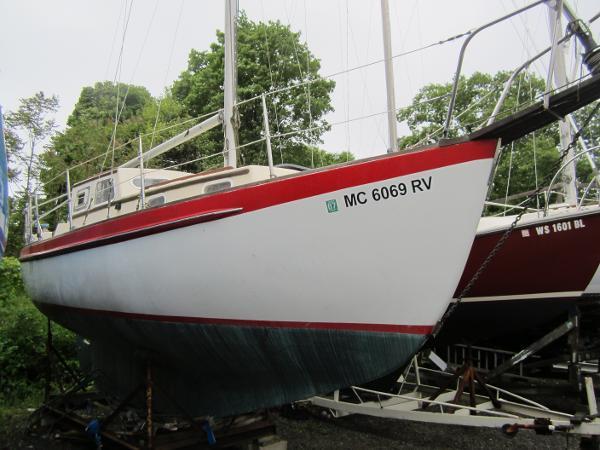
ARCHIVED: This is a previously listed vessel and is no longer offered for sale If you would like assistance locating a similar vessel, Click Here to locate a similar boat
Designed by Eldredge-McInnis and built by Portsmouth Yacht Co., the Eastward Ho is a compact yet roomy sloop designed for family cruising in comfort. She is a proven design which combines traditional elegance with practical accommodations. Nothing has been overlooked to satisfy both the sailor and the cruising enthusiast. Her generous headroom, two berths, full galley, and enclosed head are unique on a boat of this size. Her spacious cockpit affords seats long enough for an afternoon nap or additional overnight guests. Sailing or under power she is lively and responsive with a motion reminiscent of a much larger boat. Her ample beam and sufficient ballast make her very stiff without sacrificing valuable draft.
Attabuoy is in need of general cleaning inside and out and some cosmetic work. The keel will need some minor fiberglass work. The sails are like new. The engine turns over, but has not been operated for a number of years. Take a look and you will fall in love!
- Specifications
- Description
Hull color - white
Deck color - cream
Keel - internal lead
Cockpit Cushions
Stern Ladder
Opening Ports - 2
Pressure Water
Refrigerator
Battery - 1 (most likely is dead)
Shorepower 110V
Roller Furling
Depthsounder
Cradle - steel
Anchors - 3
Anchor Rode - 2
Fire Extinguisher
Life Jackets
Main - white, Dacron, The Yacht Sailmakers
Main Cover - blue, Sunbrella
Genoa - white, Dacron, The Yacht Sailmakers
Summer & Winter - Torresen Marine, Inc., Muskegon, Michigan
For more information or details, please contact Steve Dake, Director of Sailboat Sales, at (231) 759-8596 or by email at [email protected] .
Steve has been in the marine business for over 40 years. Please use his knowledge and experience to help you find the right boat for your needs.
Because we value your time, please call and make an appointment prior to visiting. Your scheduled appointment helps ensure the ability to board and see the boat you would like to preview. Please wear boat shoes only to board all boats. The only exceptions are non-marking treads. Thank you!
Connecting with Marinesource.com
Copyright 1992-2024 MarineSource Network, Inc. All Rights Reserved.

I want to get mails about Recently added "eastward ho 24" ads.
I agree with the Terms of use and Terms of Privacy .
Publication date
- Last 15 Days
- Most popular
- Most recent added
- Lower price
Price (min)
- 100.000 USD
- 125.000 USD
- 150.000 USD
- 175.000 USD
- 200.000 USD
- 225.000 USD
- 250.000 USD
- 275.000 USD
- 300.000 USD
- 350.000 USD
- 400.000 USD
- 450.000 USD
- 500.000 USD
- 600.000 USD
- 700.000 USD
- 800.000 USD
- 900.000 USD
- 1.000.000 USD
- 1.100.000 USD
- 1.300.000 USD
- 1.500.000 USD
- 1.700.000 USD
- 2.000.000 USD
- 2.500.000 USD
Price (max)
Hull Material
Length (min)
Length (max)
eastward ho 24 for sale
- eastward ho 24

1976 CE Ryder Eastward Ho 24 sailboat for sale in Connecticut
Ce ryder eastward ho 24.
Built by CE Ryder (USA) and finished by Portsmouth Yacht Co., Rhode Island, USA, this stout pocket cruiser is a solid full-keel sailing vessel. Omoo has had a lot...
Other classifieds according to your search criteria

Haynie 24 HO 2014
Haynie 24ho.

1978 CE Ryder Portsmouth Yacht Co Eastward Ho sailboat for sale in Florida
Airyella is a classic New England style sloop - has incredible character, is very distinctive, and is a pleasure to sail. She is perfect for anyone looking for a...

2014 Haynie 24 HO | 25ft
Haynie 24 ho.
2014 Haynie 24 HO 2014 Haynie 24 High Output, Yamaha 300 w/215hrs, Jackplate, trim tabs, underwater lights, Minn Kota I-pilot 112lbs 36v trolling motor, Power...

Yamaha SX240 HO
Yamaha sx240 ho.
Sales Department phone 2012 Yamaha SX240 HO 1 of 111 View Large Images Description Stock #075952 - If you are in the market for a jet, look no further...
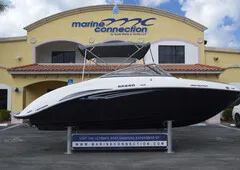
Marine Connection Boat Sales 1.phone West Palm Beach, FL 2011 Yamaha SX240 HO 2011 Yamaha SX240 HO Jet Boat Combines Performance & Family Friendly Fun!! $34,900...
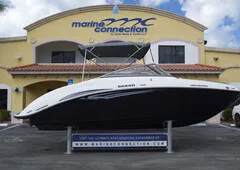
Marine Connection Boat Sales 1.phone West Palm Beach, FL 2011 Yamaha SX240 HO NICE! 2011 Yamaha SX240 HO Jet Boat, Twin 180HP Engines, Financing! $34,900 ConditionUsed...
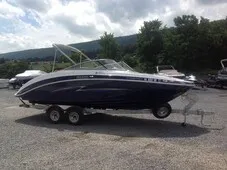
#content {margin: 0; padding: 0; font-family: Helvetica, Arial, sans-serif; font-size: 12px; color: #000;} dl, dl dt, dl dd, ul, ul li, img {margin: 0; padding:...
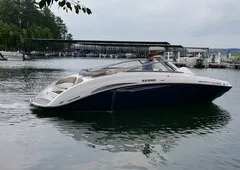
This boat has approximately 53 hours and in like new condition and only used in fresh water. Boat has been in dry storage when not in use. It's powered by twin 180...
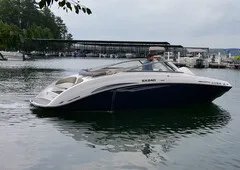
Yamaha AR 240 HO
Yamaha ar 240 ho.
PICTURES ANDDESCRIPTION COMING SOON

Yamaha 240 SX HO
Yamaha 240 sx ho.
Looking for the most fun 24 bowrider on the market? The Yamaha 240SX HO drafts only 17 inches and planes in 2.3 seconds! Powered by twin 1.8 Liter High Output engines,...

Yamaha SX240 H.O.
Yamaha sx240 h.o..
Garret McLaughlin phone 5327 East Frontage Rd NW Rochester Minnesota 55901 16 Yamaha SX240 H.O. TEXT GARRET Call or text Garret at phone for prompt and friendly...
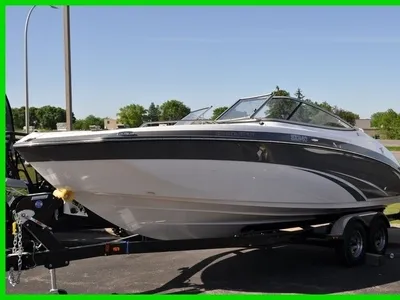
Yamaha AR240 H.O.
Yamaha ar240 h.o..
2017 YAMAHA AR240 HO BRAND NEW !!!ALL OTHER MODELS IN STOCK MUST GOPRICED TO SELL NOW!ALL OTHER 2017 MODELS AVAILABLE TOO!!!MUST TEXT OR CALL KYLE PRICE @ phone...
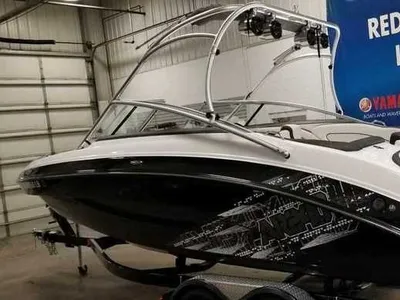
Related Searches "eastward ho 24" :
The information we receive from advertisement sites may vary. Therefore, when you go to the listing site, you may not always find the same offer that you see on waa2.
- Add Your Listing
- Terms of Privacy
- Terms of use
- About

Popular Sailboat Models
- Bavaria Cruiser 46
- Fountaine Pajot Saona 47
- Beneteau Oceanis 45
- Beneteau 50
- Catalina 30
Popular Powerboat Models
- Sea Doo Speedster
- Sea Ray Sundancer 320
- Bayliner Vr5
- Beneteau Antares 11
- Malibu Wakesetter 23 Lsv
- Boston Whaler 170 Montauk
- Princess V65
- Jeanneau Nc 1095
Feedback! ▼
Waa2 login to your account, register for free, forgot password.
Would you also like to receive alerts for these other related searches?
yamaha fx 1 9 ho 24
2015 yamaha ar240 ho
fx cruiser ho 2018
Waa2 uses our own and third-party cookies to improve your user experience, enhance our services, and to analyze your browsing data in order to show you relevant advertisements. By continuing browsing please note you are accepting this policy. You are free to change the settings or get more information here >>> OK
- Sign In or Register
- Research Boats
- Sell a Boat
- Search Alerts
- My Listings
- Account Settings
- Dealer Advertising
- Portsmouth Eastward Ho
Portsmouth Eastward Ho Boats for sale
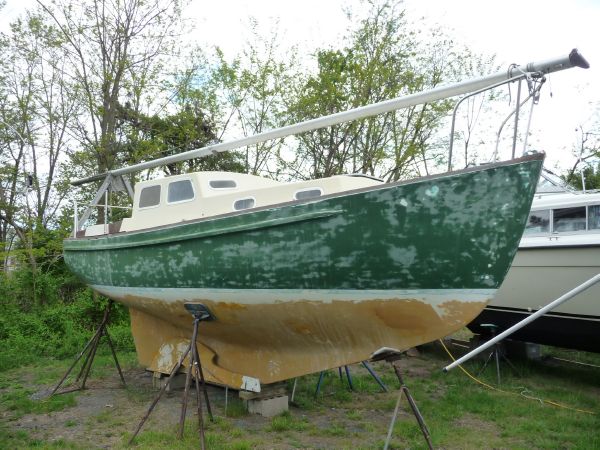
1976 PORTSMOUTH Eastward Ho
Neptune, New Jersey
Make PORTSMOUTH
Model Eastward Ho
Category Sailboats
Posted Over 1 Month
1976 PORTSMOUTH Eastward Ho All of the prep work has been done and she's just about ready for paint. This is a great opportunity for someone looking to customize an Eastward Ho their way and do it cheap! Seller has all parts to complete this project. Also available separately is the completely rebuilt 14HP Volvo MD7A Diesel engine, ready to be placed in the boat. Top to Bottom rebuild was performed by world renowned Monmouth Marine Engines of Brielle NJ. $3000 Invested.

Belmar, New Jersey
Narrow Results
Current search reset all.
- Keyword: portsmouth eastward ho
- PORTSMOUTH (1)
- Sailboats (1)
- New Jersey (2)
- Search Title Only
- Has Picture
- Include Sold Listings
Showcase Ads

2017 Boston Whaler 230 Vantage
Daly City, CA

2008 Sea Ray 260 Sundancer Cruiser

2006 Sea Ray 340 Sundancer
Belleville, MI

2014 Malibu Wakesetter 24 MXZ
Create Alert
Please, name this search
Select Interval
Alert Successfully Created

- New comments
- Military Photos
- Russian Military
- Anti-Aircraft
- SA-21/S-400 Triumf

92N6E Radar, S-400
- Oct 18, 2010
Media information
Share this media.
- This site uses cookies to help personalise content, tailor your experience and to keep you logged in if you register. By continuing to use this site, you are consenting to our use of cookies. Accept Learn more…
- Popular Professionals
- Design & Planning
- Construction & Renovation
- Finishes & Fixtures
- Landscaping & Outdoor
- Systems & Appliances
- Interior Designers & Decorators
- Architects & Building Designers
- Design-Build Firms
- Kitchen & Bathroom Designers
- General Contractors
- Kitchen & Bathroom Remodelers
- Home Builders
- Roofing & Gutters
- Cabinets & Cabinetry
- Tile & Stone
- Hardwood Flooring Dealers
- Landscape Contractors
- Landscape Architects & Landscape Designers
- Home Stagers
- Swimming Pool Builders
- Lighting Designers and Suppliers
- 3D Rendering
- Sustainable Design
- Basement Design
- Architectural Design
- Universal Design
- Energy-Efficient Homes
- Multigenerational Homes
- House Plans
- Home Remodeling
- Home Additions
- Green Building
- Garage Building
- New Home Construction
- Basement Remodeling
- Stair & Railing Contractors
- Cabinetry & Cabinet Makers
- Roofing & Gutter Contractors
- Window Contractors
- Exterior & Siding Contractors
- Carpet Contractors
- Carpet Installation
- Flooring Contractors
- Wood Floor Refinishing
- Tile Installation
- Custom Countertops
- Quartz Countertops
- Cabinet Refinishing
- Custom Bathroom Vanities
- Finish Carpentry
- Cabinet Repair
- Custom Windows
- Window Treatment Services
- Window Repair
- Fireplace Contractors
- Paint & Wall Covering Dealers
- Door Contractors
- Glass & Shower Door Contractors
- Landscape Construction
- Land Clearing
- Garden & Landscape Supplies
- Deck & Patio Builders
- Deck Repair
- Patio Design
- Stone, Pavers, & Concrete
- Paver Installation
- Driveway & Paving Contractors
- Driveway Repair
- Asphalt Paving
- Garage Door Repair
- Fence Contractors
- Fence Installation
- Gate Repair
- Pergola Construction
- Spa & Pool Maintenance
- Swimming Pool Contractors
- Hot Tub Installation
- HVAC Contractors
- Electricians
- Appliance Services
- Solar Energy Contractors
- Outdoor Lighting Installation
- Landscape Lighting Installation
- Outdoor Lighting & Audio/Visual Specialists
- Home Theater & Home Automation Services
- Handyman Services
- Closet Designers
- Professional Organizers
- Furniture & Accessories Retailers
- Furniture Repair & Upholstery Services
- Specialty Contractors
- Color Consulting
- Wine Cellar Designers & Builders
- Home Inspection
- Custom Artists
- Columbus, OH Painters
- New York City, NY Landscapers
- San Diego, CA Bathroom Remodelers
- Minneapolis, MN Architects
- Portland, OR Tile Installers
- Kansas City, MO Flooring Contractors
- Denver, CO Countertop Installers
- San Francisco, CA New Home Builders
- Rugs & Decor
- Home Improvement
- Kitchen & Tabletop
- Bathroom Vanities
- Bathroom Vanity Lighting
- Bathroom Mirrors
- Bathroom Fixtures
- Nightstands & Bedside Tables
- Kitchen & Dining
- Bar Stools & Counter Stools
- Dining Chairs
- Dining Tables
- Buffets and Sideboards
- Kitchen Fixtures
- Wall Mirrors
- Living Room
- Armchairs & Accent Chairs
- Coffee & Accent Tables
- Sofas & Sectionals
- Media Storage
- Patio & Outdoor Furniture
- Outdoor Lighting
- Ceiling Lighting
- Chandeliers
- Pendant Lighting
- Wall Sconces
- Desks & Hutches
- Office Chairs
- View All Products
- Side & End Tables
- Console Tables
- Living Room Sets
- Chaise Lounges
- Ottomans & Poufs
- Bedroom Furniture
- Nightstands
- Bedroom Sets
- Dining Room Sets
- Sideboards & Buffets
- File Cabinets
- Room Dividers
- Furniture Sale
- Trending in Furniture
- View All Furniture
- Bath Vanities
- Single Vanities
- Double Vanities
- Small Vanities
- Transitional Vanities
- Modern Vanities
- Houzz Curated Vanities
- Best Selling Vanities
- Bathroom Vanity Mirrors
- Medicine Cabinets
- Bathroom Faucets
- Bathroom Sinks
- Shower Doors
- Showerheads & Body Sprays
- Bathroom Accessories
- Bathroom Storage
- Trending in Bath
- View All Bath
- Designer Picks
- Houzz x Jennifer Kizzee
- Houzz x Motivo Homes
- How to Choose a Bathroom Vanity

- Patio Furniture
- Outdoor Dining Furniture
- Outdoor Lounge Furniture
- Outdoor Chairs
- Adirondack Chairs
- Outdoor Bar Furniture
- Outdoor Benches
- Wall Lights & Sconces
- Outdoor Flush-Mounts
- Landscape Lighting
- Outdoor Flood & Spot Lights
- Outdoor Decor
- Outdoor Rugs
- Outdoor Cushions & Pillows
- Patio Umbrellas
- Lawn & Garden
- Garden Statues & Yard Art
- Planters & Pots
- Outdoor Sale
- Trending in Outdoor
- View All Outdoor
- 8 x 10 Rugs
- 9 x 12 Rugs
- Hall & Stair Runners
- Home Decor & Accents
- Pillows & Throws
- Decorative Storage
- Faux Florals
- Wall Panels
- Window Treatments
- Curtain Rods
- Blackout Curtains
- Blinds & Shades
- Rugs & Decor Sale
- Trending in Rugs & Decor
- View All Rugs & Decor
- Pendant Lights
- Flush-Mounts
- Ceiling Fans
- Track Lighting
- Wall Lighting
- Swing Arm Wall Lights
- Display Lighting
- Table Lamps
- Floor Lamps
- Lamp Shades
- Lighting Sale
- Trending in Lighting
- View All Lighting
- Bathroom Remodel
- Kitchen Remodel
- Kitchen Faucets
- Kitchen Sinks
- Major Kitchen Appliances
- Cabinet Hardware
- Backsplash Tile
- Mosaic Tile
- Wall & Floor Tile
- Accent, Trim & Border Tile
- Whole House Remodel
- Heating & Cooling
- Building Materials
- Front Doors
- Interior Doors
- Home Improvement Sale
- Trending in Home Improvement
- View All Home Improvement
- Cups & Glassware
- Kitchen & Table Linens
- Kitchen Storage and Org
- Kitchen Islands & Carts
- Food Containers & Canisters
- Pantry & Cabinet Organizers
- Kitchen Appliances
- Gas & Electric Ranges
- Range Hoods & Vents
- Beer & Wine Refrigerators
- Small Kitchen Appliances
- Cookware & Bakeware
- Tools & Gadgets
- Kitchen & Tabletop Sale
- Trending in Kitchen & Tabletop
- View All Kitchen & Tabletop
- Storage & Organization
- Baby & Kids

- View all photos
- Dining Room
- Breakfast Nook
- Family Room
- Bed & Bath
- Powder Room
- Storage & Closet
- Outdoor Kitchen
- Bar & Wine
- Wine Cellar
- Home Office
- Popular Design Ideas
- Kitchen Backsplash
- Deck Railing
- Privacy Fence
- Small Closet
- Stories and Guides
- Popular Stories
- Renovation Cost Guides
- Fence Installation Cost Guide
- Window Installation Cost Guide
- Discussions
- Design Dilemmas
- Before & After
- Houzz Research
- View all pros
- View all services
- View all products
- View all sales
- Living Room Chairs
- Dining Room Furniture
- Coffee Tables
- Home Office Furniture
- Join as a Pro
- Interior Design Software
- Project Management
- Custom Website
- Lead Generation
- Invoicing & Billing
- Landscape Contractor Software
- General Contractor Software
- Remodeler Software
- Builder Software
- Roofer Software
- Architect Software
- Takeoff Software
- Lumber & Framing Takeoffs
- Steel Takeoffs
- Concrete Takeoffs
- Drywall Takeoffs
- Insulation Takeoffs
- Stories & Guides
- LATEST FROM HOUZZ
- HOUZZ DISCUSSIONS
- SHOP KITCHEN & DINING
- Kitchen & Dining Furniture
- Sinks & Faucets
- Kitchen Cabinets & Storage
- Knobs & Pulls
- Kitchen Knives
- KITCHEN PHOTOS
- FIND KITCHEN PROS
- Bath Accessories
- Bath Linens
- BATH PHOTOS
- FIND BATH PROS
- SHOP BEDROOM
- Beds & Headboards
- Bedroom Decor
- Closet Storage
- Bedroom Vanities
- BEDROOM PHOTOS
- Kids' Room
- FIND DESIGN PROS
- SHOP LIVING
- Fireplaces & Accessories
- LIVING PHOTOS
- SHOP OUTDOOR
- Pool & Spa
- Backyard Play
- OUTDOOR PHOTOS
- FIND LANDSCAPING PROS
- SHOP LIGHTING
- Bathroom & Vanity
- Flush Mounts
- Kitchen & Cabinet
- Outdoor Wall Lights
- Outdoor Hanging Lights
- Kids' Lighting
- Decorative Accents
- Artificial Flowers & Plants
- Decorative Objects
- Screens & Room Dividers
- Wall Shelves
- About Houzz
- Houzz Credit Cards
- Privacy & Notice
- Cookie Policy
- Your Privacy Choices
- Mobile Apps
- Copyright & Trademark
- For Professionals
- Houzz vs. Houzz Pro
- Houzz Pro vs. Ivy
- Houzz Pro Advertising Reviews
- Houzz Pro 3D Floor Planner Reviews
- Trade Program
- Buttons & Badges
- Your Orders
- Shipping & Delivery
- Return Policy
- Houzz Canada
- Review Professionals
- Suggested Professionals
- Accessibility
- Houzz Support
- COUNTRY COUNTRY
New & Custom Home Builders in Elektrostal'
Location (1).
- Use My Current Location
Popular Locations
- Albuquerque
- Cedar Rapids
- Grand Rapids
- Indianapolis
- Jacksonville
- Kansas City
- Little Rock
- Los Angeles
- Minneapolis
- New Orleans
- Oklahoma City
- Orange County
- Philadelphia
- Portland Maine
- Salt Lake City
- San Francisco
- San Luis Obispo
- Santa Barbara
- Washington D.C.
- Elektrostal', Moscow Oblast, Russia
Featured Reviews for New & Custom Home Builders in Elektrostal'
- Reach out to the pro(s) you want, then share your vision to get the ball rolling.
- Request and compare quotes, then hire the Home Builder that perfectly fits your project and budget limits.
Before choosing a Builder for your residential home project in Elektrostal', there are a few important steps to take:
- Define your project: Outline your desired home type, features, and layout. Provide specific details and preferences to help the builder understand your vision.
- Establish a budget: Develop a comprehensive budget, including construction expenses and material costs. Communicate your budgetary constraints to the builder from the beginning.
- Timeline: Share your estimated timeline or desired completion date.
- Site conditions: Inform the builder about any unique site conditions or challenges.
- Local regulations: Make the builder aware of any building regulations or permits required.
- Custom Homes
- Floor Plans
- House Framing
- Land Surveying
- Site Planning
What do new home building contractors do?
Questions to ask a prospective custom home builder in elektrostal', moscow oblast, russia:, business services, connect with us.
Great choice! Your favorites are temporarily saved for this session. Sign in to save them permanently, access them on any device, and receive relevant alerts.
- Sailboat Guide
Eastward HO 24
Eastward HO 24 is a 23 ′ 7 ″ / 7.2 m monohull sailboat designed by Walter McInnis and built by C. E. Ryder starting in 1975.

Rig and Sails
Auxilary power, accomodations, calculations.
The theoretical maximum speed that a displacement hull can move efficiently through the water is determined by it's waterline length and displacement. It may be unable to reach this speed if the boat is underpowered or heavily loaded, though it may exceed this speed given enough power. Read more.
Classic hull speed formula:
Hull Speed = 1.34 x √LWL
Max Speed/Length ratio = 8.26 ÷ Displacement/Length ratio .311 Hull Speed = Max Speed/Length ratio x √LWL
Sail Area / Displacement Ratio
A measure of the power of the sails relative to the weight of the boat. The higher the number, the higher the performance, but the harder the boat will be to handle. This ratio is a "non-dimensional" value that facilitates comparisons between boats of different types and sizes. Read more.
SA/D = SA ÷ (D ÷ 64) 2/3
- SA : Sail area in square feet, derived by adding the mainsail area to 100% of the foretriangle area (the lateral area above the deck between the mast and the forestay).
- D : Displacement in pounds.
Ballast / Displacement Ratio
A measure of the stability of a boat's hull that suggests how well a monohull will stand up to its sails. The ballast displacement ratio indicates how much of the weight of a boat is placed for maximum stability against capsizing and is an indicator of stiffness and resistance to capsize.
Ballast / Displacement * 100
Displacement / Length Ratio
A measure of the weight of the boat relative to it's length at the waterline. The higher a boat’s D/L ratio, the more easily it will carry a load and the more comfortable its motion will be. The lower a boat's ratio is, the less power it takes to drive the boat to its nominal hull speed or beyond. Read more.
D/L = (D ÷ 2240) ÷ (0.01 x LWL)³
- D: Displacement of the boat in pounds.
- LWL: Waterline length in feet
Comfort Ratio
This ratio assess how quickly and abruptly a boat’s hull reacts to waves in a significant seaway, these being the elements of a boat’s motion most likely to cause seasickness. Read more.
Comfort ratio = D ÷ (.65 x (.7 LWL + .3 LOA) x Beam 1.33 )
- D: Displacement of the boat in pounds
- LOA: Length overall in feet
- Beam: Width of boat at the widest point in feet
Capsize Screening Formula
This formula attempts to indicate whether a given boat might be too wide and light to readily right itself after being overturned in extreme conditions. Read more.
CSV = Beam ÷ ³√(D / 64)
Originally designed for wood contruction. The hulls of the later, FG version were built by CE Ryder (USA) and finished by Portsmouth Yacht Co. Diesel power was available as an option.
Embed this page on your own website by copying and pasting this code.
- About Sailboat Guide
©2024 Sea Time Tech, LLC
This site is protected by reCAPTCHA and the Google Privacy Policy and Terms of Service apply.
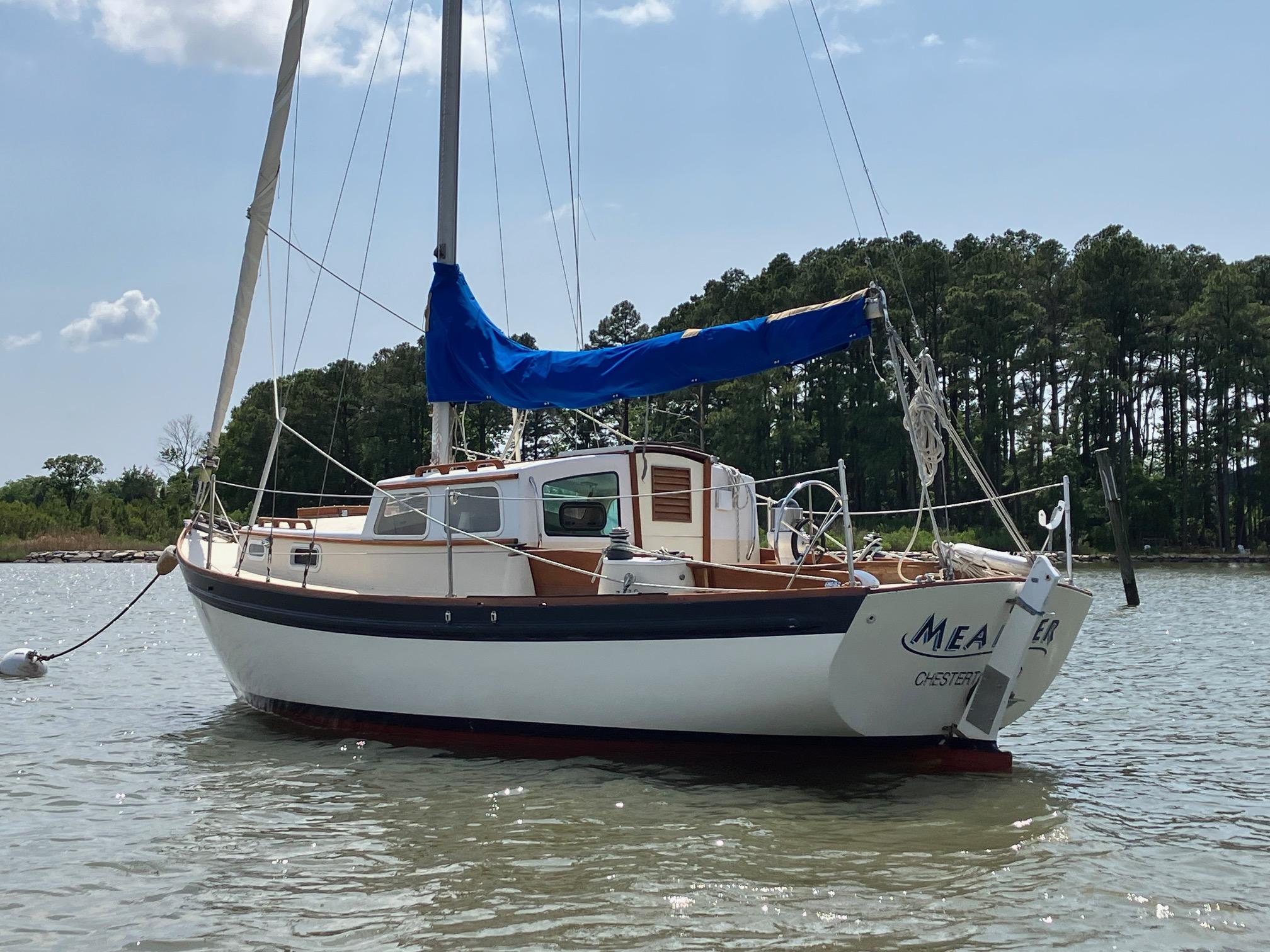
Eastward ho 24 preowned sailboats for sale by owner. Eastward ho 24 used sailboats for sale by owner.
Both salon settees turn into two twin beds so can sleep 4 adults. YEAR: 1977 MAKE: Portsmouth Yacht Co MODEL: Eastward Ho CLASS: Sloop, Pocket Cruiser LENGTH: 26' (24' with 2' boomkin) HULL MATERIAL: FIberglass reinforced plastic FUEL TYPE: Diesel. AIR CONDITIONING: Drop in Cruise Air. ALL PHOTOS ARE RECENT.
1978. 31'. 10'. 4.2'. Florida. $12,900. Description: Airyella is a classic New England style sloop - has incredible character, is very distinctive, and is a pleasure to sail. She is perfect for anyone looking for a boat that will sail, and anchor overnight with 1-5 people, comfortably in the bay and the Keys and beyond, at a fantastic price.
1976. 24'. 9'. 4'. Connecticut. $12,000. Description: Built by CE Ryder (USA) and finished by Portsmouth Yacht Co., Rhode Island, USA, this stout pocket cruiser is a solid full-keel sailing vessel. Omoo has had a lot of updates including new diesel engine (Kubota Beta marine), rebuilt gearbox (2021), new standing and running rigging (2020), new ...
Broker: Designed by Eldredge-McInnis and built by Portsmouth Yacht Co., the Eastward Ho is a compact yet roomy sloop designed for family cruising in comfort. She is a proven design which combines traditional elegance with practical accommodations. Nothing has been overlooked to satisfy both the sailor and the cruising enthusiast.
A boat with a BN of 1.6 or greater is a boat that will be reefed often in offshore cruising. Derek Harvey, "Multihulls for Cruising and Racing", International Marine, Camden, Maine, 1991, states that a BN of 1 is generally accepted as the dividing line between so-called slow and fast multihulls.
Model McInnis. Category Sailboats. Length 31'. Posted Over 1 Month. 1985 #1 Hull McInnis,31 ft., 4.5ft. draft, McInnis Cutter rig Eastward Ho series. 28hp Yanmar diesel, All hardwood Interior, Complete custom finished, In bristol condition. Completely blue water equipt.Leave Message at 772/283-0853. $40000.
Go to Sailing Texas classifieds for current sailboats for sale . Eastward HO 24, 1977 LOA 25'5" LWL 20' Beam 8'8" Draft 3'10" SA 283 sq ft Ballast 3,600 Displacement 7,000 Keel Full Designed by Thomas F. Eldredge/Walter J. Mcinnis and built by the Portsmouth Boat Company (UK).
Used 1978 Eastward Ho 31 for sale is located in Bienville National Forest (Mississippi, United States of America). This vessel was designed and built by the Eastward shipyard in 1978. Key features 1978 Eastward Ho 31: length 9.45 meters. engine: fuel type - diesel. 1978 Eastward Ho 31 refers to classes: sailing yachts , sailboats and sailing ...
Seller's Description. Portsmouth Eastward Ho 24, 1978 sailboat for sale I am selling my 1978 Portsmouth Eastward Ho 24 for $12,500. The boat is in Alamitos Bay (Seal Beach, CA / Long Beach, CA) where the buyer may assume the slip at $320 a month. Very nice location, across the street from the new 2nd and PCH outdoor mall.
Go to Sailing Texas classifieds for current sailboats for sale Eastward Ho, 24 ft., 1975 No. 55, 1975. Highly regarded Eldridge/McGinnis cruising design- Full keel, 4 ft. draft. ... The lower a boat's ratio is, the less power it takes to drive the boat to its nominal hull speed or beyond. Read more. Formula. D/L = (D ÷ 2240) ÷ (0.01 x LWL)³ ...
Seller's Description. 1980 Portsmouth Yacht Co Eastward Ho 31. She is a classic designed in 1959, built in 1980. Similar to the Sea Sprite 33 that Robin Graham sailed around the world. Custom interior Volvo Penta MD2B 25hp Nice thick teak toe rail Electric Windlass Auto Helm Updated hardware above deck Updated rigging Bimini, dodger frames ...
Search eastward ho 24 prices - more than 1 listings - Built by CE Ryder (USA) and finished by Portsmouth Yacht Co., Rhode Island, USA, this stout pocket cruiser is a solid full-keel sailing vessel. ... 1976 CE Ryder Eastward Ho 24 sailboat for sale in Connecticut. Ce Ryder eastward ho 24 . Built by CE Ryder (USA) and finished by Portsmouth ...
Boat Trader currently has 3 Eastward boats for sale, including 1 new vessels and 2 used boats listed by both private sellers and professional yacht brokers and boat dealerships mainly in United States. The oldest model listed is a contemporary boat built in 2018 and the newest model year of 2021.
Join Date: Aug 2018. Posts: 3. Eastward Ho 31 Sailboat. Cutter Rig. Eldredge McInnis design, built in RI by C. Ryder Yachts. Roller furling jib. Jib boom & roller for twin furlers. Re-built Volvo Penta 30hp with spare engine & transmission. Bimini & dodger.
35.5' Endeavour E35 Presently on the hard for winter storage at Morgans Marina, New Jersey Asking $35,000
2015 Malibu Wakesetter 22 VLX. Battle Creek, MI. $40,000. 2008 Hydra-Sports 2200 CC. Sarasota, FL. $26,500. 2 new and used Portsmouth Eastward Ho boats for sale at smartmarineguide.com.
First S-400 bltn, Elektrostal, Moscow.
Get directions to Yuzhny prospekt, 6к1 and view details like the building's postal code, description, photos, and reviews on each business in the building
Search 1,121 Elektrostal' new & custom home builders to find the best custom home builder for your project. See the top reviewed local custom home builders in Elektrostal', Moscow Oblast, Russia on Houzz.
Find company research, competitor information, contact details & financial data for STELS, OOO of Elektrostal, Moscow region. Get the latest business insights from Dun & Bradstreet.
Advertisement. Eastward HO 24 is a 23′ 7″ / 7.2 m monohull sailboat designed by Walter McInnis and built by C. E. Ryder starting in 1975.

IMAGES
VIDEO
COMMENTS
June 15, 2022. Storm sails are popular safety measures that help you retain control of your boat in high winds. They also reduce the risk of knockdown. In this article, we'll cover the most common types of storm sails and their uses. Additionally, we'll go over storm sail materials, cost, sizing, and tips from the sailing community.
Typically, storm sails are buried in the depths of a locker or under a bunk, leaving the more accessible space for other items deemed more important. This is a mistake: nothing is more important than the safety of the boat and crew. So when you're on passage, your storm sails need to be easy to locate and ready to use.
Last summer SAIL tested Banner Bay's STORM-BAG and ATN's Gale Sail to get a feel for how easy it is to set and stow these systems. Here's what we learned. ATN GALE SAIL. The ATN Gale Sail is a fairly straightforward storm sail made from bombproof 8.5- or 9.5-oz. Dacron, depending on the size of the boat.
For offshore yachts, a storm jib is considered by many as even more essential, especially with a roller furling headsail setup. Many boats have a fairly large Genoa permanently set on the roller gear. However, a sail that has been designed for light to moderate breezes will be more or less useless in a blow of 30 or 40 knots.
Skip Novak explains the easiest and safest way to reduce sail and carry on in a gale int he latest Storm Sailing video. Check out our other videos at www.ya...
The gale sail is made of the same high-quality Dacron and to the same high specification as the standard storm jib. Choosing your Storm Sails. All our storm sails come in many different sizes to suit most yachts from 16 to 55' boat lengths. You can easily choose the correct size for your boat in the following tables.
For a standard basic storm sail you can expect to pay between $494.99 - $1,099.99. The lower priced sails will be suitable for smaller boats and much larger boats will need to pay for sails in the upper price band. If you need an even cheaper alternative you might consider looking on the second hand market.
Setting a trysail. 1 Set the storm jib. This reduces canvas and means you can find a comfortable point of sail to drop the main without being over-powered. 2 Drop the mainsail. This is easier said ...
Storm sails are small, but the sails are perfectly proportioned for high winds. Newer boats have the trysail attached to the boom, with the storm jib set forward of the mast - this keeps the boat balanced. Strategy . When facing a storm, there are two possible scenarios - avoid it or head for more space in the open ocean.
In general, a storm trysail should be about 25% to 30% of the area of the full mainsail, according to most sailmakers. More sophisticated formulas are available in the literature, but they usually end up with a similarly sized sail. One is 0.05 times the square of the full mainsail luff.
Lie ahull, in which you ride out the storm with the sail down. Use your storm sails to maintain control and steering through rough conditions. Heave-to, in which you trim your jib and then the main while lashing your helm for steerageway. Check the weather forecast to avoid future dangers.
The boat, its sails balanced, would then ride the waves like a duck, the crew hunkered down, waiting for the worst to pass or steering gradually away from the storm's center. A day or two later, the winds would ease, the storm sails were removed, and the boat was got underway again by its battered, but otherwise unharmed, crew.
Sail under storm jib and deeply reefed mainsail or storm trysail. This approach provides the most control. Sails give you the power to steer and control your boat in the waves. Run before the storm with the stern toward the waves, perhaps towing a drogue to slow the boat. This tactic requires a lot of sea room, and the boat must be steered ...
Explore our Storm Sails collection at The Sail Store. Rugged sails in white or fluorescent orange, built with U.S. made cloth from Challenge. SailStore. The Sail Store. Search for Sails by Boat Model [email protected] 888-946-8242 The Sail Store » Catalog » Storm Sails.
This can hang quietly attached to the toe rail or chain plate until needed. Then as the storm approaches, it can be deployed with a ratchet, wheel or lever to tighten the wire and a reduced headsail hanked on. Having been under load, the genoa needed extra turns round the foil to furl away fully. Photo: Richard Langdon.
Racing yacht storm sail areas must meet rule requirements . 2. What color should storm sails be? Orange for visibility by ships and search planes but can be white with orange patches. 3. Name two places to sheet a storm trysail. Normally a trysail is trimmed to the spinnaker sheet blocks. This is easy and usually the best way to initially set it.
Sails . A storm jib is a small triangular staysail for use in heavy weather. If you participate in offshore racing you need a mandatory orange storm jib. It's part of ISAF's requirements. A trysail is a storm replacement for the mainsail. It's small, triangular, and it uses a permanently attached pennant. ... I have a small yacht sail which was ...
The 501 (c)3 Storm Trysail Foundation supports a national slate of events, including Junior Safety-At-Sea Seminars, Adult Hands-On Safety-At-Sea Seminars and the Intercollegiate Offshore Regatta. It is also involved in safety research and education, as well as grants to other institutions to foster similar education and training.
Mega Yacht. Luxury Sailing Yacht Sybaris is a 70 m / 229′8″ sailing vessel. She was built by Perini Navi in 2016. With a beam of 13.24 m and a draft of 4.54 m, she has an aluminium hull and aluminium superstructure. She is powered by MTU engines of 1930 hp each. The sailing yacht can accommodate guests in cabins and an exterior design by .....
In a report, the Norwegian Safety Investigation Authority upbraided the Viking Sky, saying it was "a ship's length from running aground.". The ship left the northern city of Tromsoe carrying almost 1,400 people, despite storm warnings. It was headed for Stavanger in southern Norway when it had engine problems amid a storm on March 23 ...
Hoist the Sails, a Plunderstorm Has Arrived! Get swept away in the Plunderstorm 1 — a fun, new, limited-time, pirate-themed event of prodigious proportions lasting the next several weeks. Scour the map and try to be the last pirate standing while dashing across the Arathi Highlands to find abilities, upgrades, and loot to plunder just to survive!
Blizzard Entertainment March 19, 2024. Get swept away in the Plunderstorm 1 — a fun, new, limited-time, pirate-themed event of prodigious proportions lasting the next several weeks. Scour the map and try to be the last pirate standing while dashing across the Arathi Highlands to find abilities, upgrades, and loot to plunder just to survive!
test. The Sunreef 88 DD hasn't forgotten any of the rules of super-yachting. Attention to detail and refinement is everywhere on board, making life enjoyable. The cockpit interior offers a good view forward across the water. From here, you can handle the boat while staying warm during night watches.... At the water, the Portless Catamaran inflates into an impressive 14.8-foot (4.5-m) cat with ...
Wally Yacht, based in Monte Carlo, Monaco, is a world-renowned designer of high-speed sailing and power yachts. The 118-foot yacht will feature three TF50 gas turbines in a Combined Diesel Or Gas (CODOG) turbine configuration. Two TF50s will be used as side or "wing" engines, with one small auxiliary diesel engine connected to each wing engine....
Seller's Description. Portsmouth Eastward Ho 24, 1978 sailboat for sale I am selling my 1978 Portsmouth Eastward Ho 24 for $12,500. The boat is in Alamitos Bay (Seal Beach, CA / Long Beach, CA) where the buyer may assume the slip at $320 a month. Very nice location, across the street from the new 2nd and PCH outdoor mall....